BSBWHS401: Assessment of Implementing and Monitoring WHS Programs
VerifiedAdded on 2019/10/09
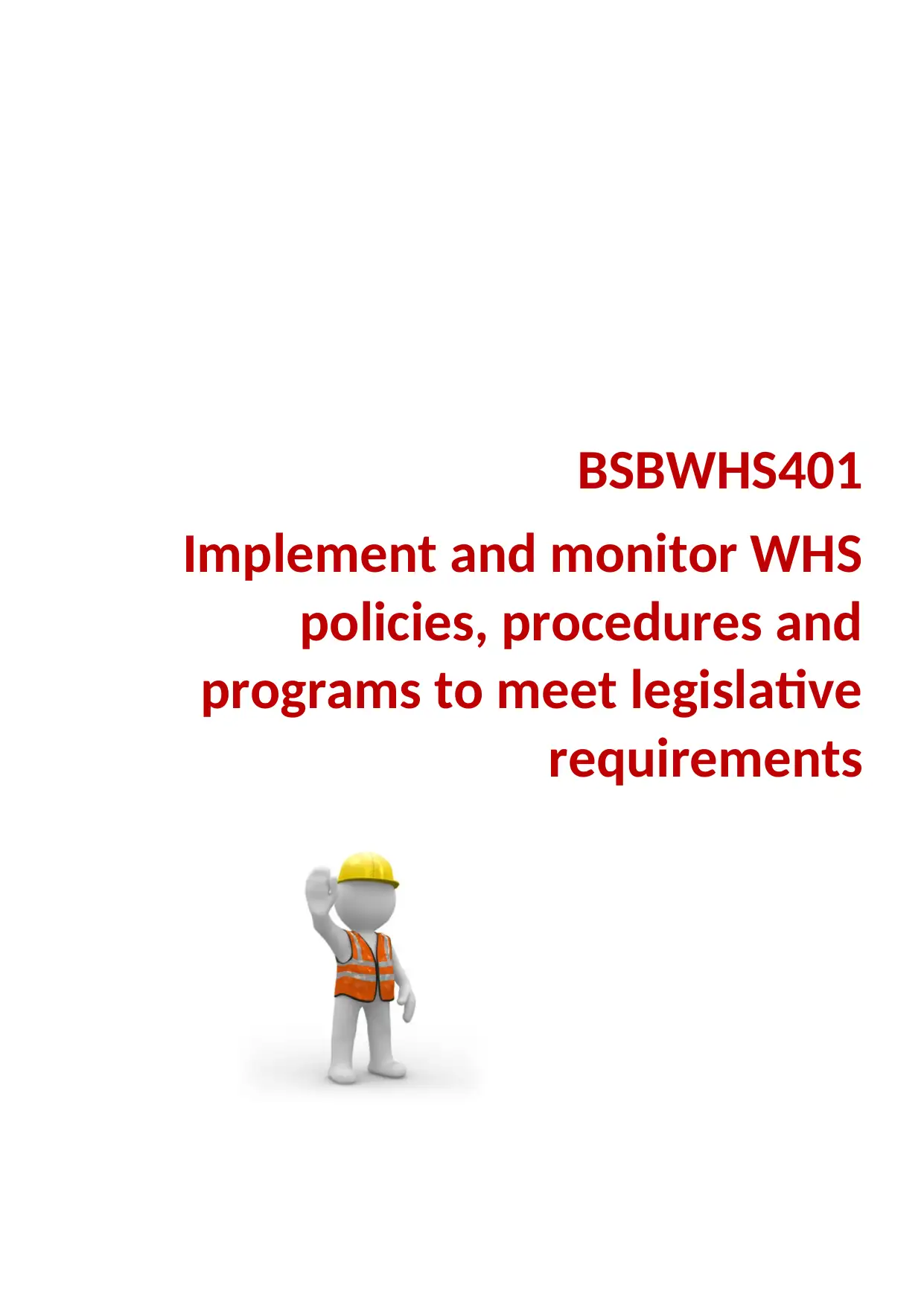
Implement and monitor WHS
policies, procedures and
programs to meet legislative
requirements
Paraphrase This Document

Table of Contents
Table of Contents.......................................................................................................................1
Instructions to Learner...............................................................................................................3
Assessment instructions......................................................................................................3
Assessment requirements....................................................................................................6
Candidate Details.......................................................................................................................7
Assessment – BSBWHS401: Implement and monitor WHS policies, procedures and
programs to meet legislative requirements.........................................................................7
Observation/Demonstration.......................................................................................................8
Third Party Guide.......................................................................................................................9
Third party details (required information from the learner)...............................................9
Activities..................................................................................................................................10
Activity 1A.......................................................................................................................10
Activity 1A checklist – for assessor.................................................................................11
Activity 1B........................................................................................................................12
Activity 1B checklist – for assessor..................................................................................13
Activity 1C........................................................................................................................14
Activity 1C checklist – for assessor..................................................................................15
Activity 2A.......................................................................................................................16
Activity 2A checklist – for assessor.................................................................................17
Activity 2B........................................................................................................................18
Activity 2B checklist – for assessor..................................................................................19
Activity 2C........................................................................................................................20
Activity 2C checklist – for assessor..................................................................................21
Activity 2D.......................................................................................................................22
Activity 2D checklist – for assessor.................................................................................23
Activity 3A.......................................................................................................................24
Activity 3A checklist – for assessor.................................................................................25
Activity 3B........................................................................................................................26
Activity 3B checklist – for assessor..................................................................................27
Activity 3C........................................................................................................................28
Activity 3C checklist – for assessor..................................................................................29
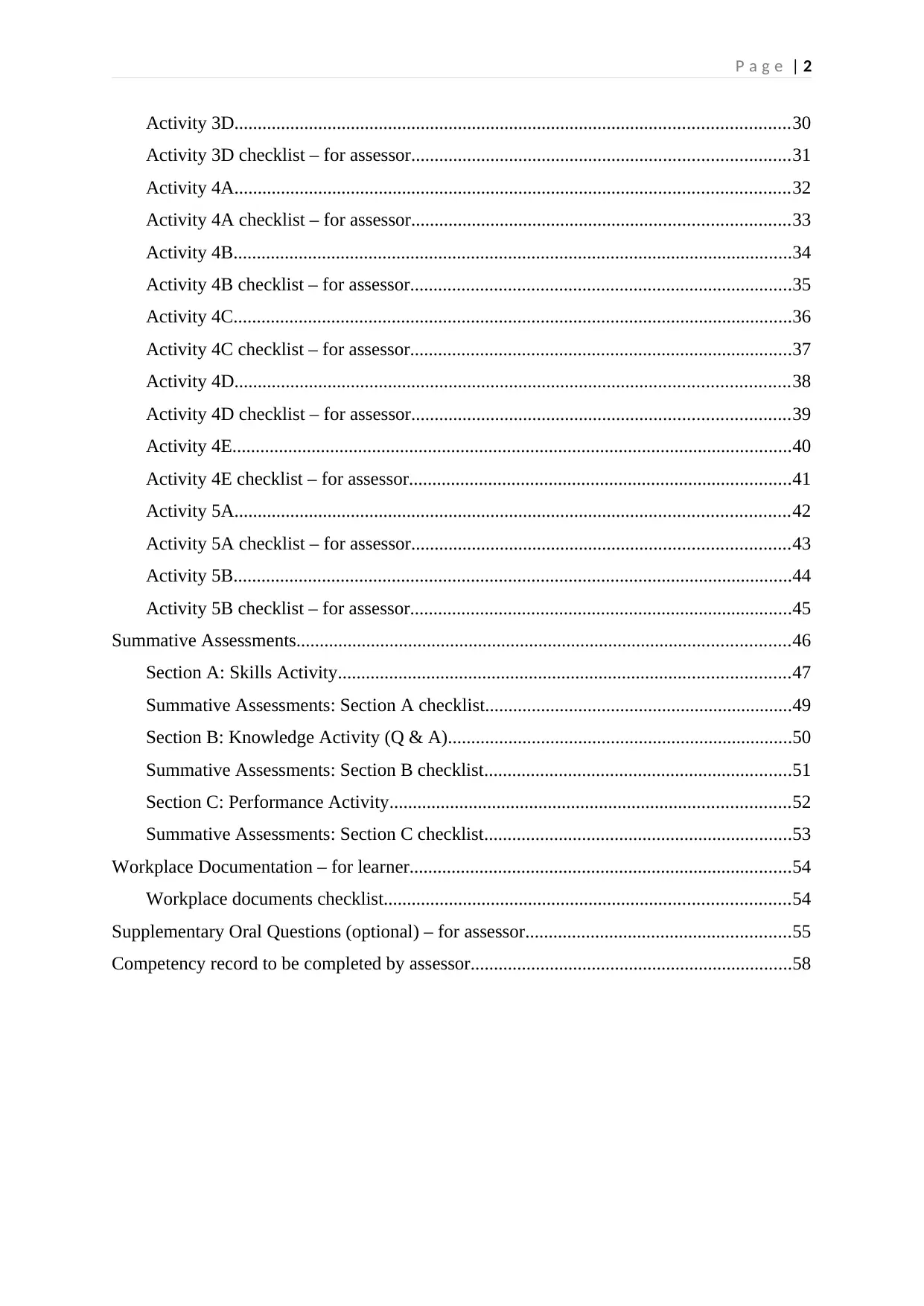
Activity 3D.......................................................................................................................30
Activity 3D checklist – for assessor.................................................................................31
Activity 4A.......................................................................................................................32
Activity 4A checklist – for assessor.................................................................................33
Activity 4B........................................................................................................................34
Activity 4B checklist – for assessor..................................................................................35
Activity 4C........................................................................................................................36
Activity 4C checklist – for assessor..................................................................................37
Activity 4D.......................................................................................................................38
Activity 4D checklist – for assessor.................................................................................39
Activity 4E........................................................................................................................40
Activity 4E checklist – for assessor..................................................................................41
Activity 5A.......................................................................................................................42
Activity 5A checklist – for assessor.................................................................................43
Activity 5B........................................................................................................................44
Activity 5B checklist – for assessor..................................................................................45
Summative Assessments..........................................................................................................46
Section A: Skills Activity.................................................................................................47
Summative Assessments: Section A checklist..................................................................49
Section B: Knowledge Activity (Q & A)..........................................................................50
Summative Assessments: Section B checklist..................................................................51
Section C: Performance Activity......................................................................................52
Summative Assessments: Section C checklist..................................................................53
Workplace Documentation – for learner..................................................................................54
Workplace documents checklist.......................................................................................54
Supplementary Oral Questions (optional) – for assessor.........................................................55
Competency record to be completed by assessor.....................................................................58
⊘ This is a preview!⊘
Do you want full access?
Subscribe today to unlock all pages.

Trusted by 1+ million students worldwide
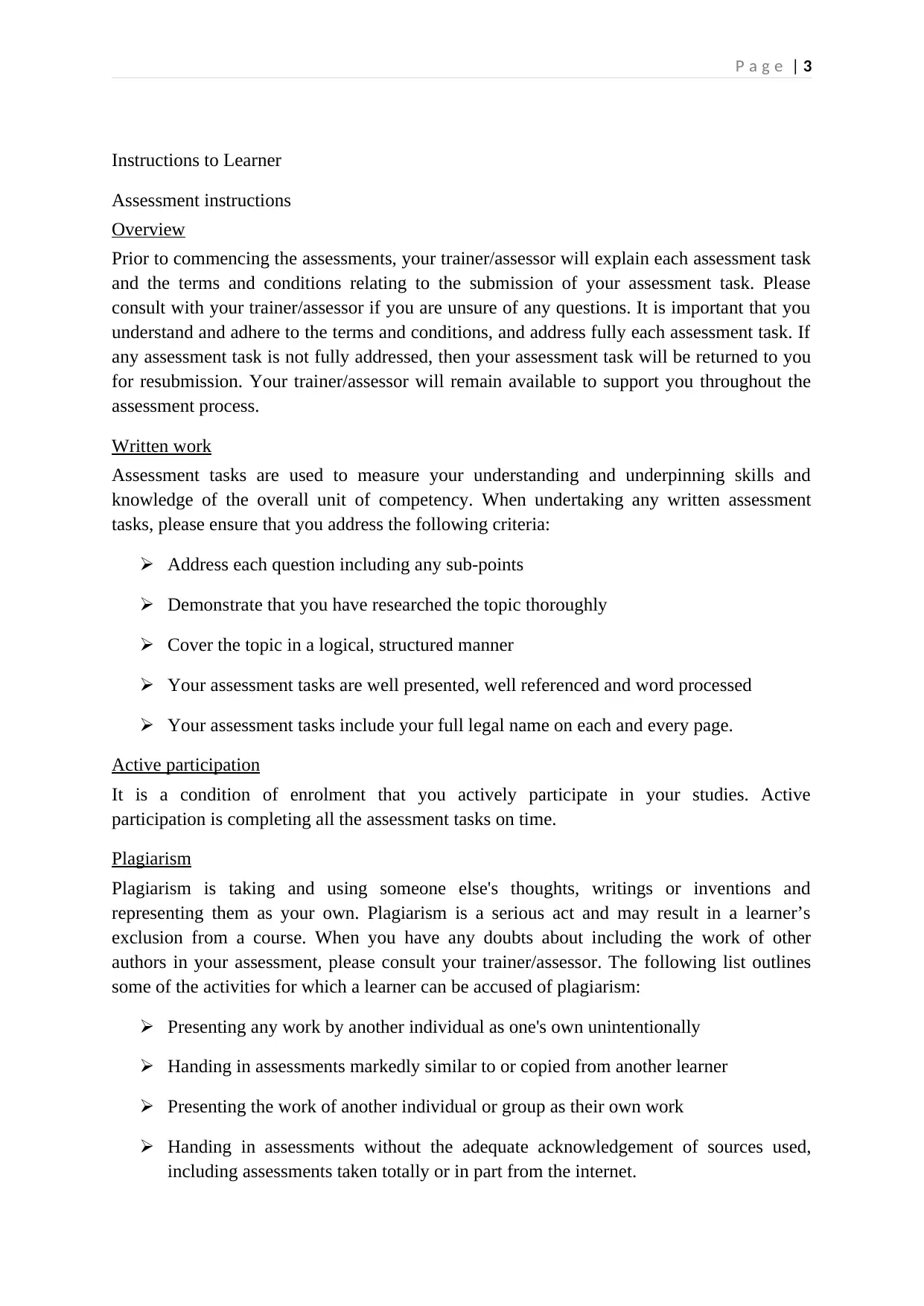
Instructions to Learner
Assessment instructions
Overview
Prior to commencing the assessments, your trainer/assessor will explain each assessment task
and the terms and conditions relating to the submission of your assessment task. Please
consult with your trainer/assessor if you are unsure of any questions. It is important that you
understand and adhere to the terms and conditions, and address fully each assessment task. If
any assessment task is not fully addressed, then your assessment task will be returned to you
for resubmission. Your trainer/assessor will remain available to support you throughout the
assessment process.
Written work
Assessment tasks are used to measure your understanding and underpinning skills and
knowledge of the overall unit of competency. When undertaking any written assessment
tasks, please ensure that you address the following criteria:
Address each question including any sub-points
Demonstrate that you have researched the topic thoroughly
Cover the topic in a logical, structured manner
Your assessment tasks are well presented, well referenced and word processed
Your assessment tasks include your full legal name on each and every page.
Active participation
It is a condition of enrolment that you actively participate in your studies. Active
participation is completing all the assessment tasks on time.
Plagiarism
Plagiarism is taking and using someone else's thoughts, writings or inventions and
representing them as your own. Plagiarism is a serious act and may result in a learner’s
exclusion from a course. When you have any doubts about including the work of other
authors in your assessment, please consult your trainer/assessor. The following list outlines
some of the activities for which a learner can be accused of plagiarism:
Presenting any work by another individual as one's own unintentionally
Handing in assessments markedly similar to or copied from another learner
Presenting the work of another individual or group as their own work
Handing in assessments without the adequate acknowledgement of sources used,
including assessments taken totally or in part from the internet.
Paraphrase This Document
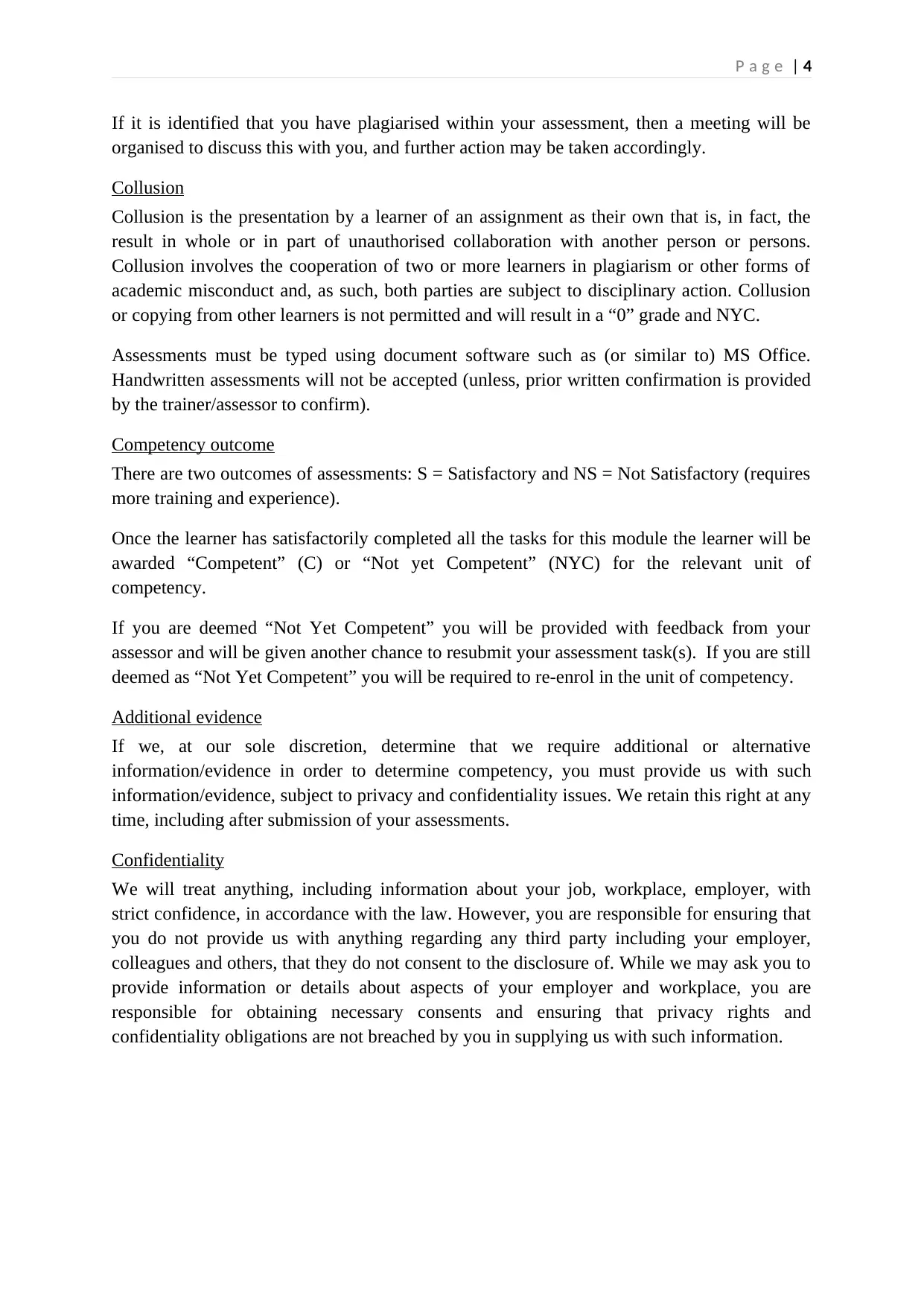
If it is identified that you have plagiarised within your assessment, then a meeting will be
organised to discuss this with you, and further action may be taken accordingly.
Collusion
Collusion is the presentation by a learner of an assignment as their own that is, in fact, the
result in whole or in part of unauthorised collaboration with another person or persons.
Collusion involves the cooperation of two or more learners in plagiarism or other forms of
academic misconduct and, as such, both parties are subject to disciplinary action. Collusion
or copying from other learners is not permitted and will result in a “0” grade and NYC.
Assessments must be typed using document software such as (or similar to) MS Office.
Handwritten assessments will not be accepted (unless, prior written confirmation is provided
by the trainer/assessor to confirm).
Competency outcome
There are two outcomes of assessments: S = Satisfactory and NS = Not Satisfactory (requires
more training and experience).
Once the learner has satisfactorily completed all the tasks for this module the learner will be
awarded “Competent” (C) or “Not yet Competent” (NYC) for the relevant unit of
competency.
If you are deemed “Not Yet Competent” you will be provided with feedback from your
assessor and will be given another chance to resubmit your assessment task(s). If you are still
deemed as “Not Yet Competent” you will be required to re-enrol in the unit of competency.
Additional evidence
If we, at our sole discretion, determine that we require additional or alternative
information/evidence in order to determine competency, you must provide us with such
information/evidence, subject to privacy and confidentiality issues. We retain this right at any
time, including after submission of your assessments.
Confidentiality
We will treat anything, including information about your job, workplace, employer, with
strict confidence, in accordance with the law. However, you are responsible for ensuring that
you do not provide us with anything regarding any third party including your employer,
colleagues and others, that they do not consent to the disclosure of. While we may ask you to
provide information or details about aspects of your employer and workplace, you are
responsible for obtaining necessary consents and ensuring that privacy rights and
confidentiality obligations are not breached by you in supplying us with such information.

Assessment appeals process
If you feel that you have been unfairly treated during your assessment, and you are not happy
with your assessment and/or the outcome as a result of that treatment, you have the right to
lodge an appeal. You must first discuss the issue with your trainer/assessor. If you would like
to proceed further with the request after discussions with your trainer/assessor, you need to
lodge your appeal to the course coordinator, in writing, outlining the reason(s) for the appeal.
Recognised prior learning
Candidates will be able to have their previous experience or expertise recognised on request.
Special needs
Candidates with special needs should notify their trainer/assessor to request any required
adjustments as soon as possible. This will enable the trainer/assessor to address the identified
needs immediately .
⊘ This is a preview!⊘
Do you want full access?
Subscribe today to unlock all pages.

Trusted by 1+ million students worldwide
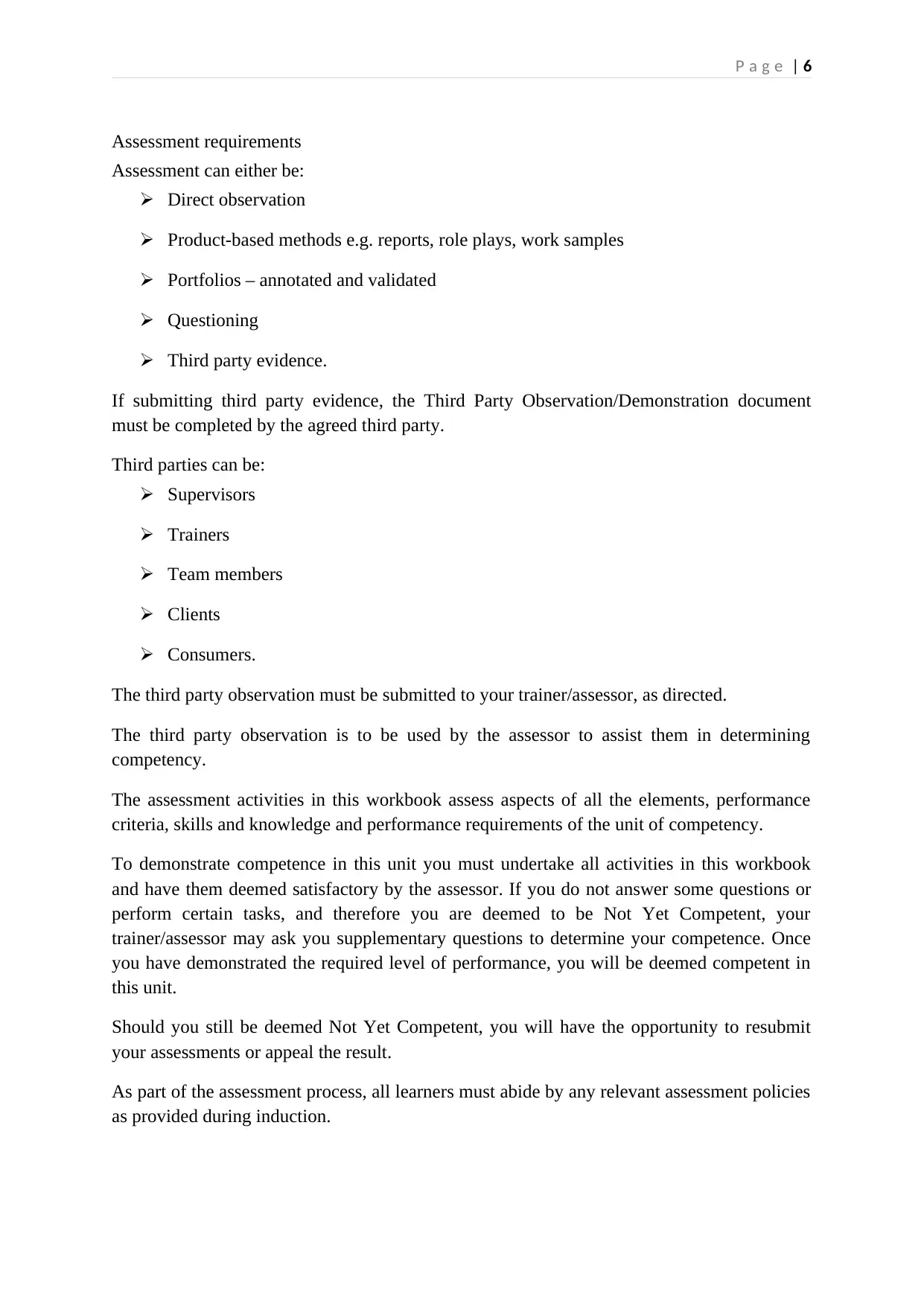
Assessment requirements
Assessment can either be:
Direct observation
Product-based methods e.g. reports, role plays, work samples
Portfolios – annotated and validated
Questioning
Third party evidence.
If submitting third party evidence, the Third Party Observation/Demonstration document
must be completed by the agreed third party.
Third parties can be:
Supervisors
Trainers
Team members
Clients
Consumers.
The third party observation must be submitted to your trainer/assessor, as directed.
The third party observation is to be used by the assessor to assist them in determining
competency.
The assessment activities in this workbook assess aspects of all the elements, performance
criteria, skills and knowledge and performance requirements of the unit of competency.
To demonstrate competence in this unit you must undertake all activities in this workbook
and have them deemed satisfactory by the assessor. If you do not answer some questions or
perform certain tasks, and therefore you are deemed to be Not Yet Competent, your
trainer/assessor may ask you supplementary questions to determine your competence. Once
you have demonstrated the required level of performance, you will be deemed competent in
this unit.
Should you still be deemed Not Yet Competent, you will have the opportunity to resubmit
your assessments or appeal the result.
As part of the assessment process, all learners must abide by any relevant assessment policies
as provided during induction.
Paraphrase This Document
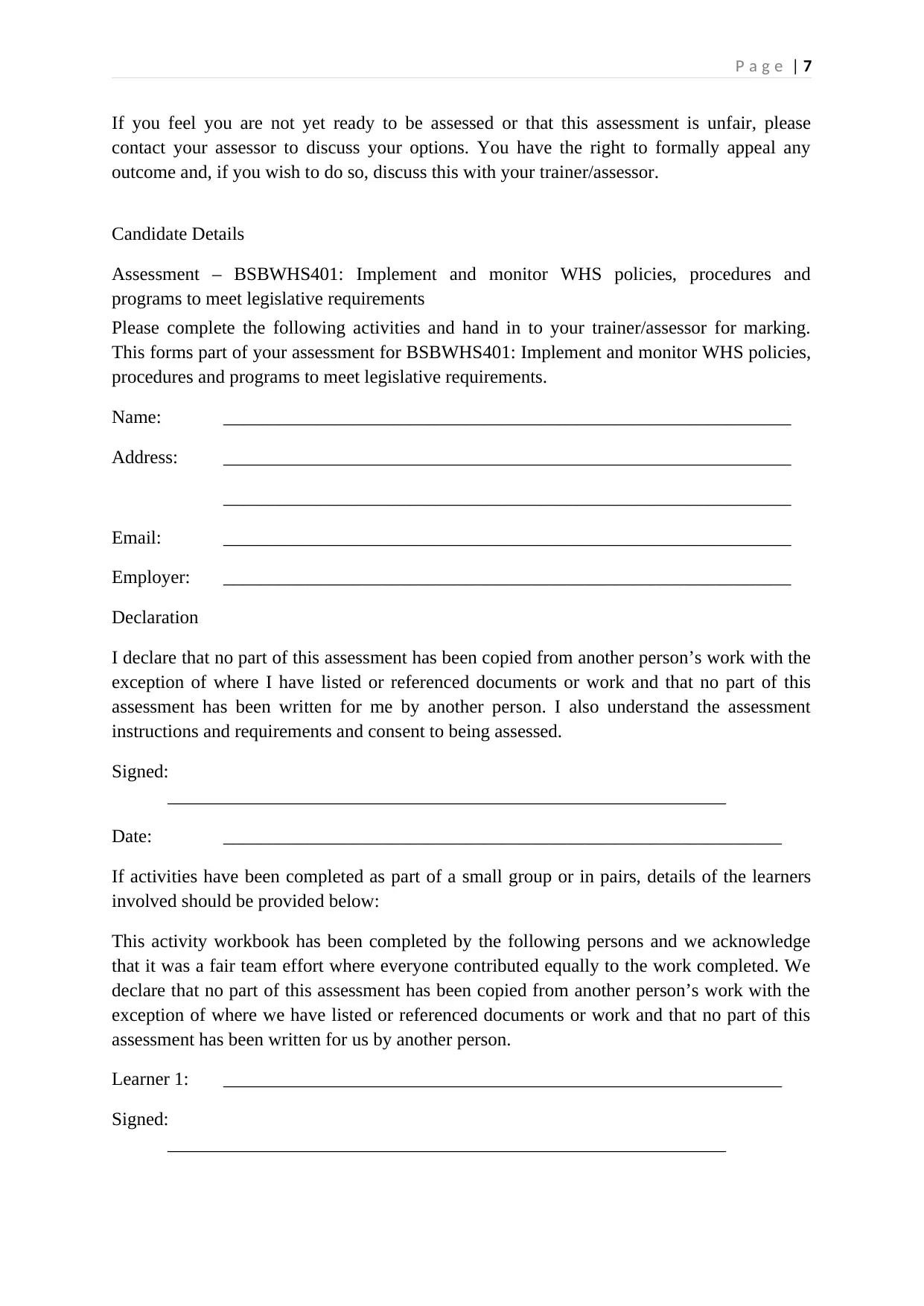
If you feel you are not yet ready to be assessed or that this assessment is unfair, please
contact your assessor to discuss your options. You have the right to formally appeal any
outcome and, if you wish to do so, discuss this with your trainer/assessor.
Candidate Details
Assessment – BSBWHS401: Implement and monitor WHS policies, procedures and
programs to meet legislative requirements
Please complete the following activities and hand in to your trainer/assessor for marking.
This forms part of your assessment for BSBWHS401: Implement and monitor WHS policies,
procedures and programs to meet legislative requirements.
Name: _____________________________________________________________
Address: _____________________________________________________________
_____________________________________________________________
Email: _____________________________________________________________
Employer: _____________________________________________________________
Declaration
I declare that no part of this assessment has been copied from another person’s work with the
exception of where I have listed or referenced documents or work and that no part of this
assessment has been written for me by another person. I also understand the assessment
instructions and requirements and consent to being assessed.
Signed:
____________________________________________________________
Date: ____________________________________________________________
If activities have been completed as part of a small group or in pairs, details of the learners
involved should be provided below:
This activity workbook has been completed by the following persons and we acknowledge
that it was a fair team effort where everyone contributed equally to the work completed. We
declare that no part of this assessment has been copied from another person’s work with the
exception of where we have listed or referenced documents or work and that no part of this
assessment has been written for us by another person.
Learner 1: ____________________________________________________________
Signed:
____________________________________________________________
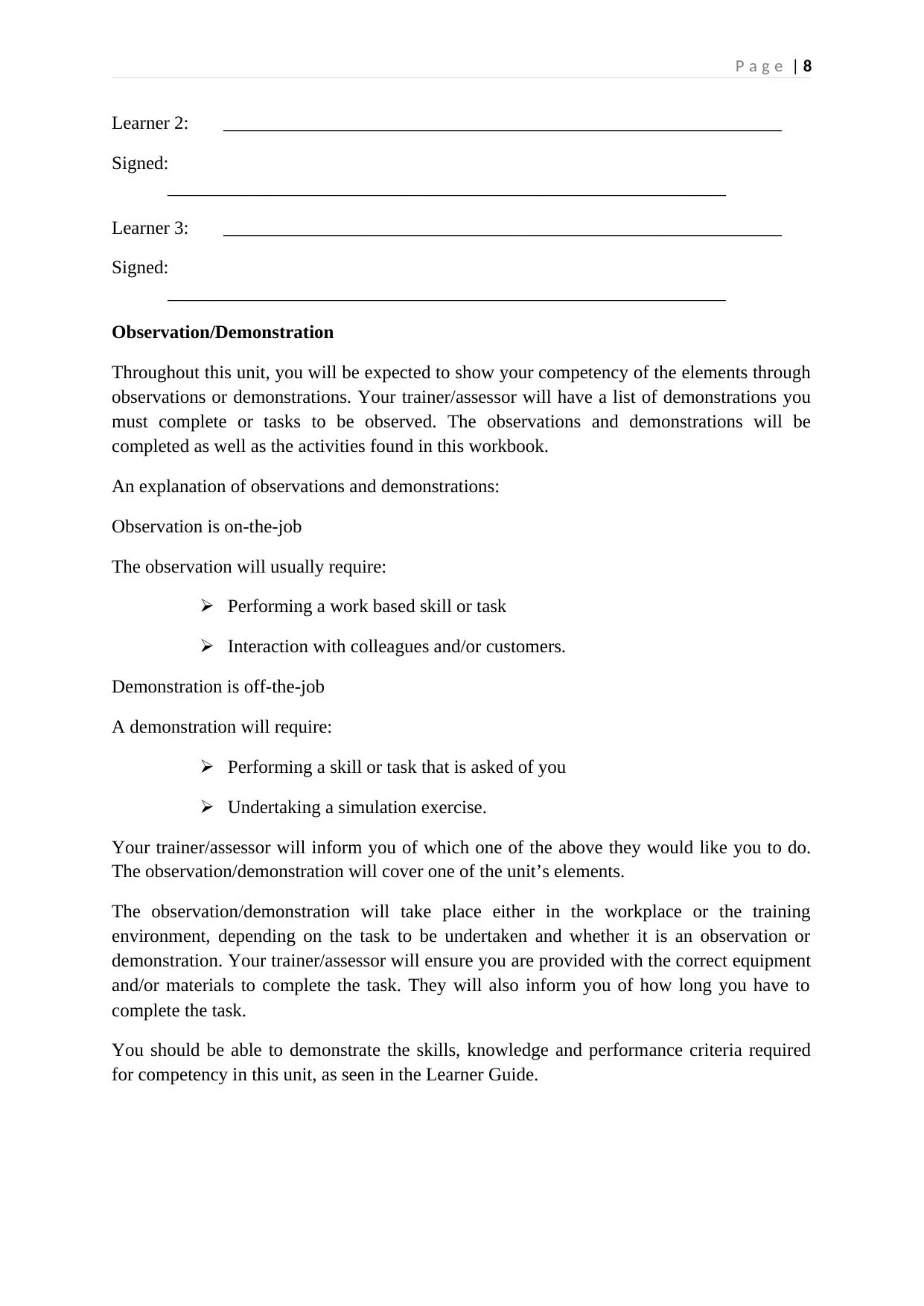
Learner 2: ____________________________________________________________
Signed:
____________________________________________________________
Learner 3: ____________________________________________________________
Signed:
____________________________________________________________
Observation/Demonstration
Throughout this unit, you will be expected to show your competency of the elements through
observations or demonstrations. Your trainer/assessor will have a list of demonstrations you
must complete or tasks to be observed. The observations and demonstrations will be
completed as well as the activities found in this workbook.
An explanation of observations and demonstrations:
Observation is on-the-job
The observation will usually require:
Performing a work based skill or task
Interaction with colleagues and/or customers.
Demonstration is off-the-job
A demonstration will require:
Performing a skill or task that is asked of you
Undertaking a simulation exercise.
Your trainer/assessor will inform you of which one of the above they would like you to do.
The observation/demonstration will cover one of the unit’s elements.
The observation/demonstration will take place either in the workplace or the training
environment, depending on the task to be undertaken and whether it is an observation or
demonstration. Your trainer/assessor will ensure you are provided with the correct equipment
and/or materials to complete the task. They will also inform you of how long you have to
complete the task.
You should be able to demonstrate the skills, knowledge and performance criteria required
for competency in this unit, as seen in the Learner Guide.
⊘ This is a preview!⊘
Do you want full access?
Subscribe today to unlock all pages.

Trusted by 1+ million students worldwide
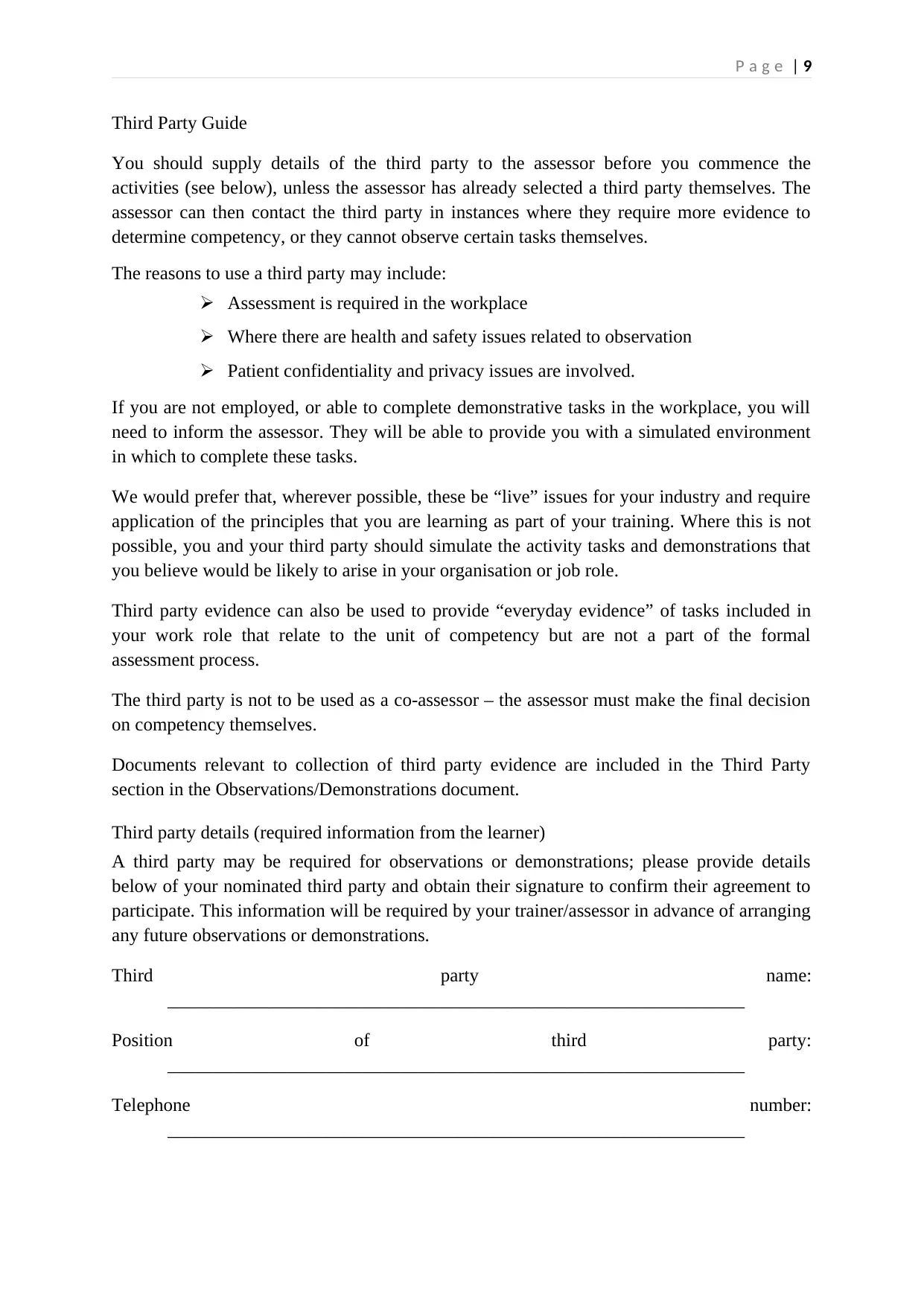
Third Party Guide
You should supply details of the third party to the assessor before you commence the
activities (see below), unless the assessor has already selected a third party themselves. The
assessor can then contact the third party in instances where they require more evidence to
determine competency, or they cannot observe certain tasks themselves.
The reasons to use a third party may include:
Assessment is required in the workplace
Where there are health and safety issues related to observation
Patient confidentiality and privacy issues are involved.
If you are not employed, or able to complete demonstrative tasks in the workplace, you will
need to inform the assessor. They will be able to provide you with a simulated environment
in which to complete these tasks.
We would prefer that, wherever possible, these be “live” issues for your industry and require
application of the principles that you are learning as part of your training. Where this is not
possible, you and your third party should simulate the activity tasks and demonstrations that
you believe would be likely to arise in your organisation or job role.
Third party evidence can also be used to provide “everyday evidence” of tasks included in
your work role that relate to the unit of competency but are not a part of the formal
assessment process.
The third party is not to be used as a co-assessor – the assessor must make the final decision
on competency themselves.
Documents relevant to collection of third party evidence are included in the Third Party
section in the Observations/Demonstrations document.
Third party details (required information from the learner)
A third party may be required for observations or demonstrations; please provide details
below of your nominated third party and obtain their signature to confirm their agreement to
participate. This information will be required by your trainer/assessor in advance of arranging
any future observations or demonstrations.
Third party name:
______________________________________________________________
Position of third party:
______________________________________________________________
Telephone number:
______________________________________________________________
Paraphrase This Document
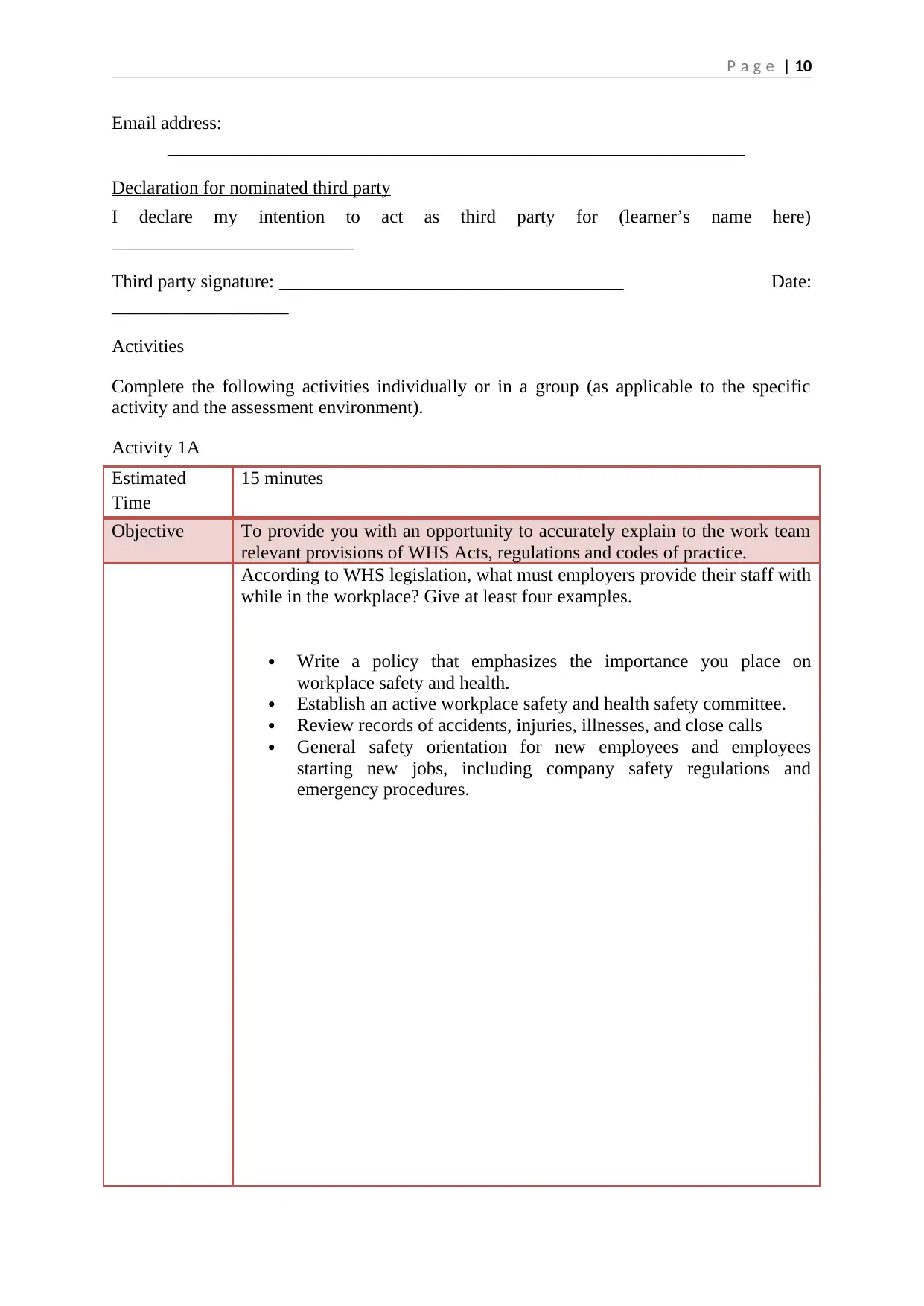
Email address:
______________________________________________________________
Declaration for nominated third party
I declare my intention to act as third party for (learner’s name here)
__________________________
Third party signature: _____________________________________ Date:
___________________
Activities
Complete the following activities individually or in a group (as applicable to the specific
activity and the assessment environment).
Activity 1A
Estimated
Time
15 minutes
Objective To provide you with an opportunity to accurately explain to the work team
relevant provisions of WHS Acts, regulations and codes of practice.
According to WHS legislation, what must employers provide their staff with
while in the workplace? Give at least four examples.
Write a policy that emphasizes the importance you place on
workplace safety and health.
Establish an active workplace safety and health safety committee.
Review records of accidents, injuries, illnesses, and close calls
General safety orientation for new employees and employees
starting new jobs, including company safety regulations and
emergency procedures.

⊘ This is a preview!⊘
Do you want full access?
Subscribe today to unlock all pages.

Trusted by 1+ million students worldwide
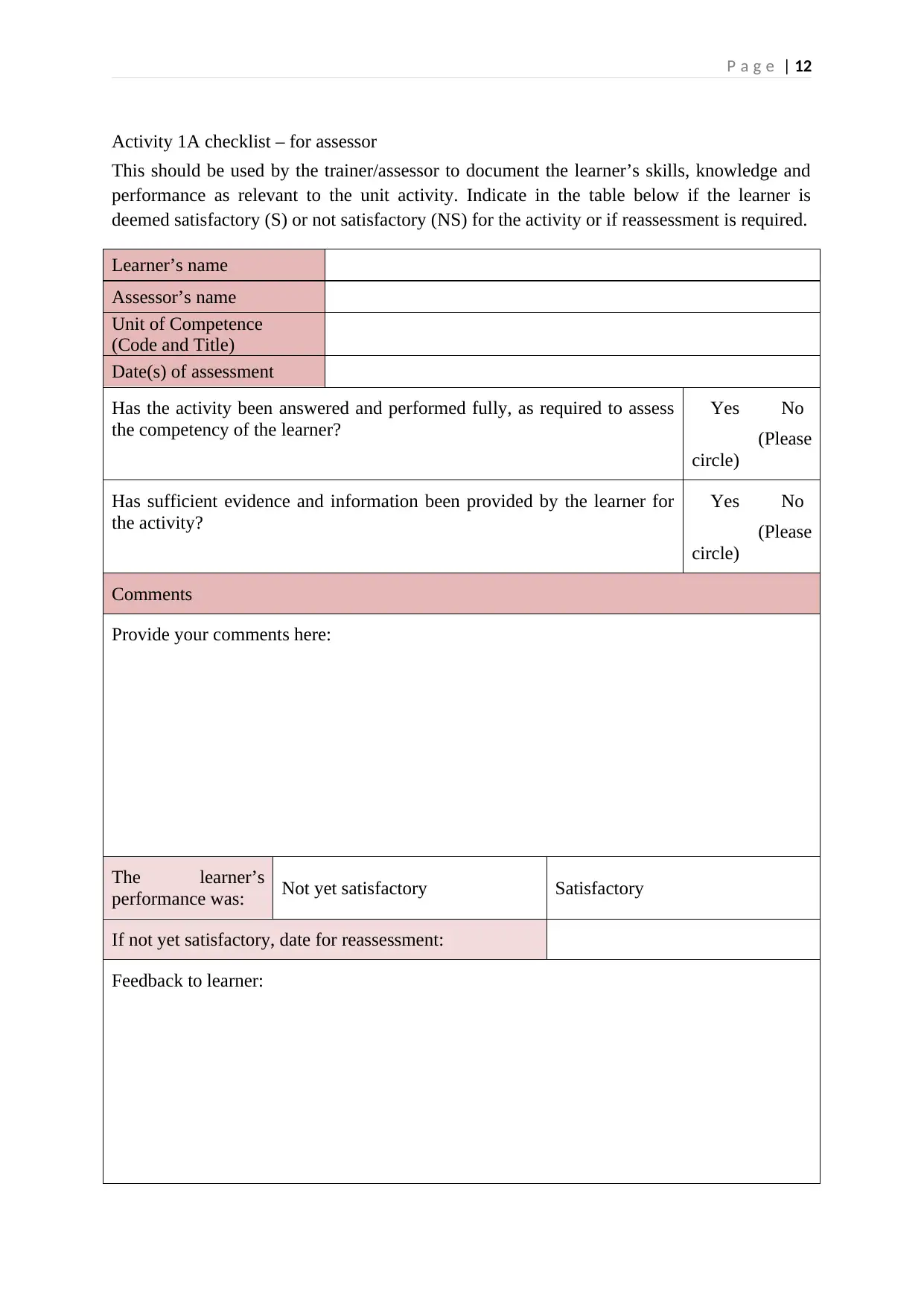
Activity 1A checklist – for assessor
This should be used by the trainer/assessor to document the learner’s skills, knowledge and
performance as relevant to the unit activity. Indicate in the table below if the learner is
deemed satisfactory (S) or not satisfactory (NS) for the activity or if reassessment is required.
Learner’s name
Assessor’s name
Unit of Competence
(Code and Title)
Date(s) of assessment
Has the activity been answered and performed fully, as required to assess
the competency of the learner?
Yes No
(Please
circle)
Has sufficient evidence and information been provided by the learner for
the activity?
Yes No
(Please
circle)
Comments
Provide your comments here:
The learner’s
performance was: Not yet satisfactory Satisfactory
If not yet satisfactory, date for reassessment:
Feedback to learner:
Paraphrase This Document
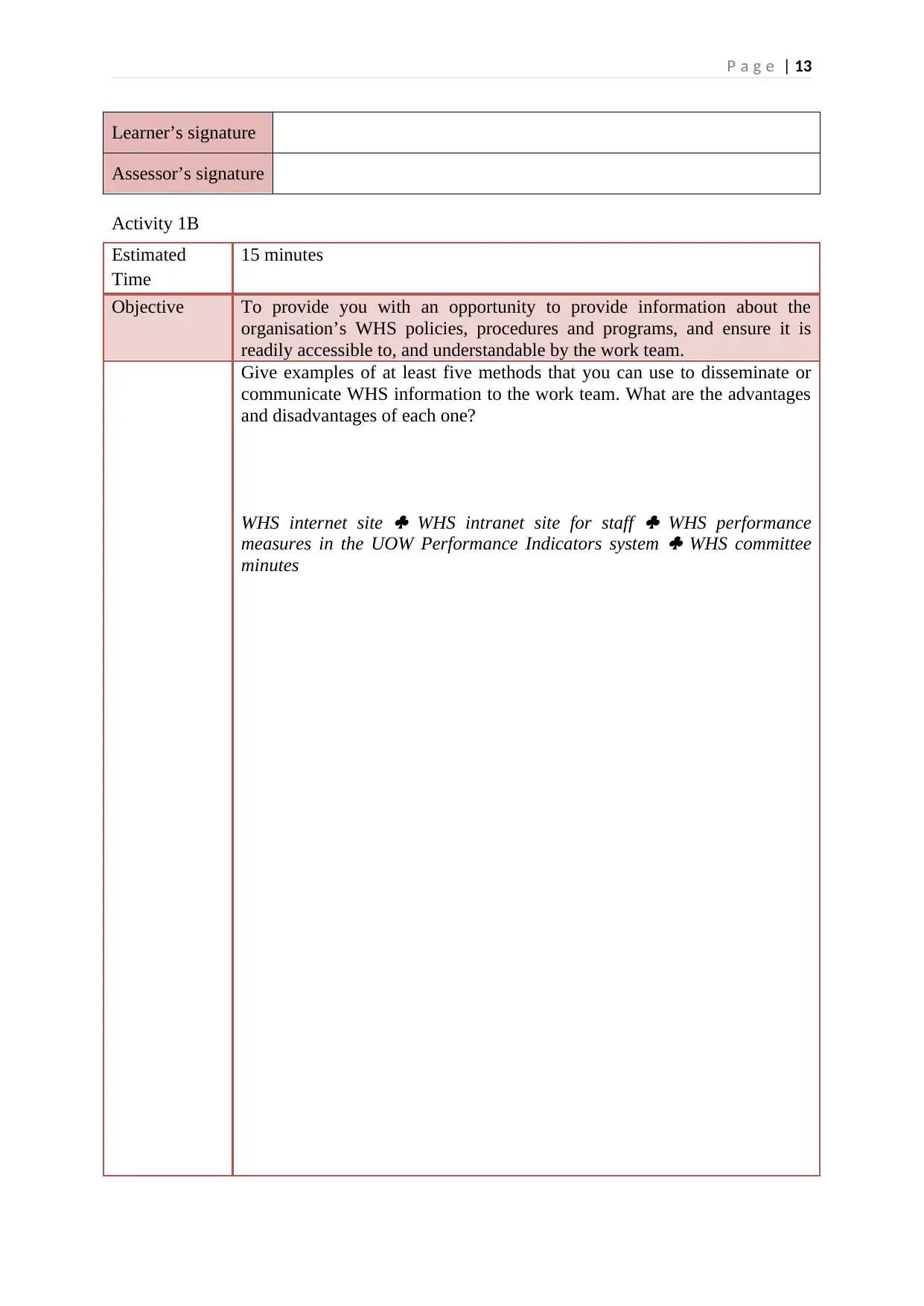
Learner’s signature
Assessor’s signature
Activity 1B
Estimated
Time
15 minutes
Objective To provide you with an opportunity to provide information about the
organisation’s WHS policies, procedures and programs, and ensure it is
readily accessible to, and understandable by the work team.
Give examples of at least five methods that you can use to disseminate or
communicate WHS information to the work team. What are the advantages
and disadvantages of each one?
WHS internet site
WHS intranet site for staff
WHS performance
measures in the UOW Performance Indicators system
WHS committee
minutes

⊘ This is a preview!⊘
Do you want full access?
Subscribe today to unlock all pages.

Trusted by 1+ million students worldwide
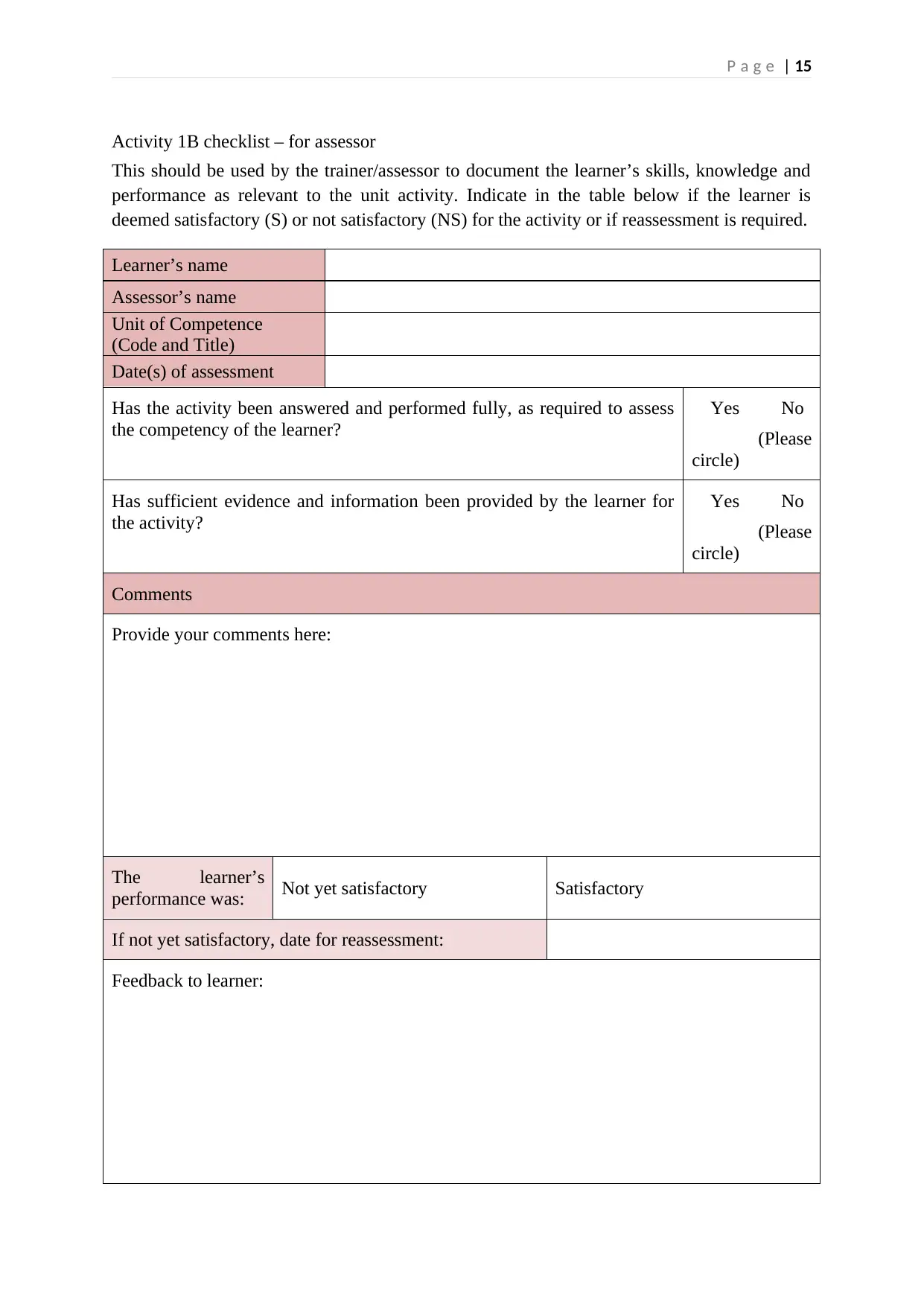
Activity 1B checklist – for assessor
This should be used by the trainer/assessor to document the learner’s skills, knowledge and
performance as relevant to the unit activity. Indicate in the table below if the learner is
deemed satisfactory (S) or not satisfactory (NS) for the activity or if reassessment is required.
Learner’s name
Assessor’s name
Unit of Competence
(Code and Title)
Date(s) of assessment
Has the activity been answered and performed fully, as required to assess
the competency of the learner?
Yes No
(Please
circle)
Has sufficient evidence and information been provided by the learner for
the activity?
Yes No
(Please
circle)
Comments
Provide your comments here:
The learner’s
performance was: Not yet satisfactory Satisfactory
If not yet satisfactory, date for reassessment:
Feedback to learner:
Paraphrase This Document
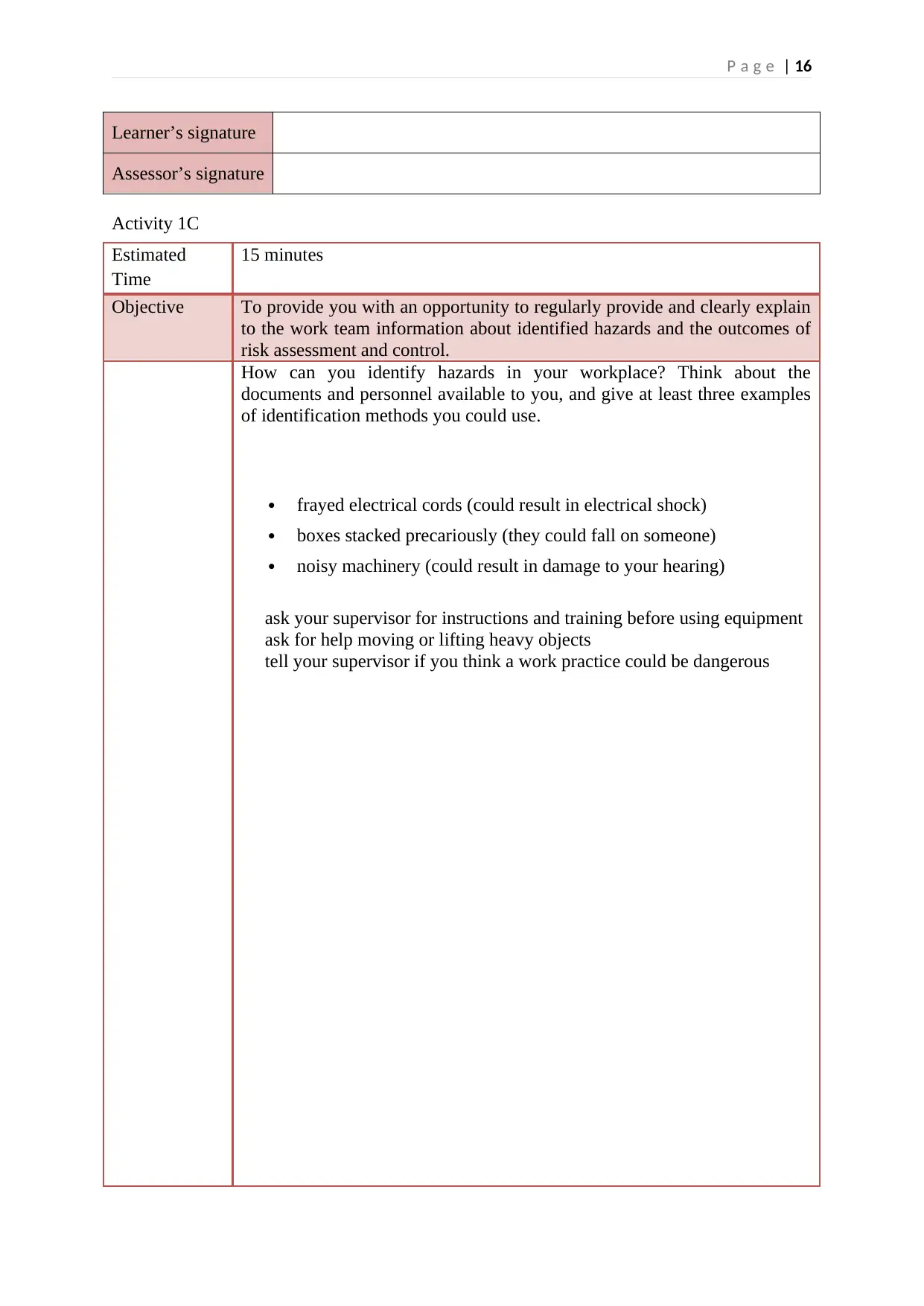
Learner’s signature
Assessor’s signature
Activity 1C
Estimated
Time
15 minutes
Objective To provide you with an opportunity to regularly provide and clearly explain
to the work team information about identified hazards and the outcomes of
risk assessment and control.
How can you identify hazards in your workplace? Think about the
documents and personnel available to you, and give at least three examples
of identification methods you could use.
frayed electrical cords (could result in electrical shock)
boxes stacked precariously (they could fall on someone)
noisy machinery (could result in damage to your hearing)
ask your supervisor for instructions and training before using equipment
ask for help moving or lifting heavy objects
tell your supervisor if you think a work practice could be dangerous

⊘ This is a preview!⊘
Do you want full access?
Subscribe today to unlock all pages.

Trusted by 1+ million students worldwide
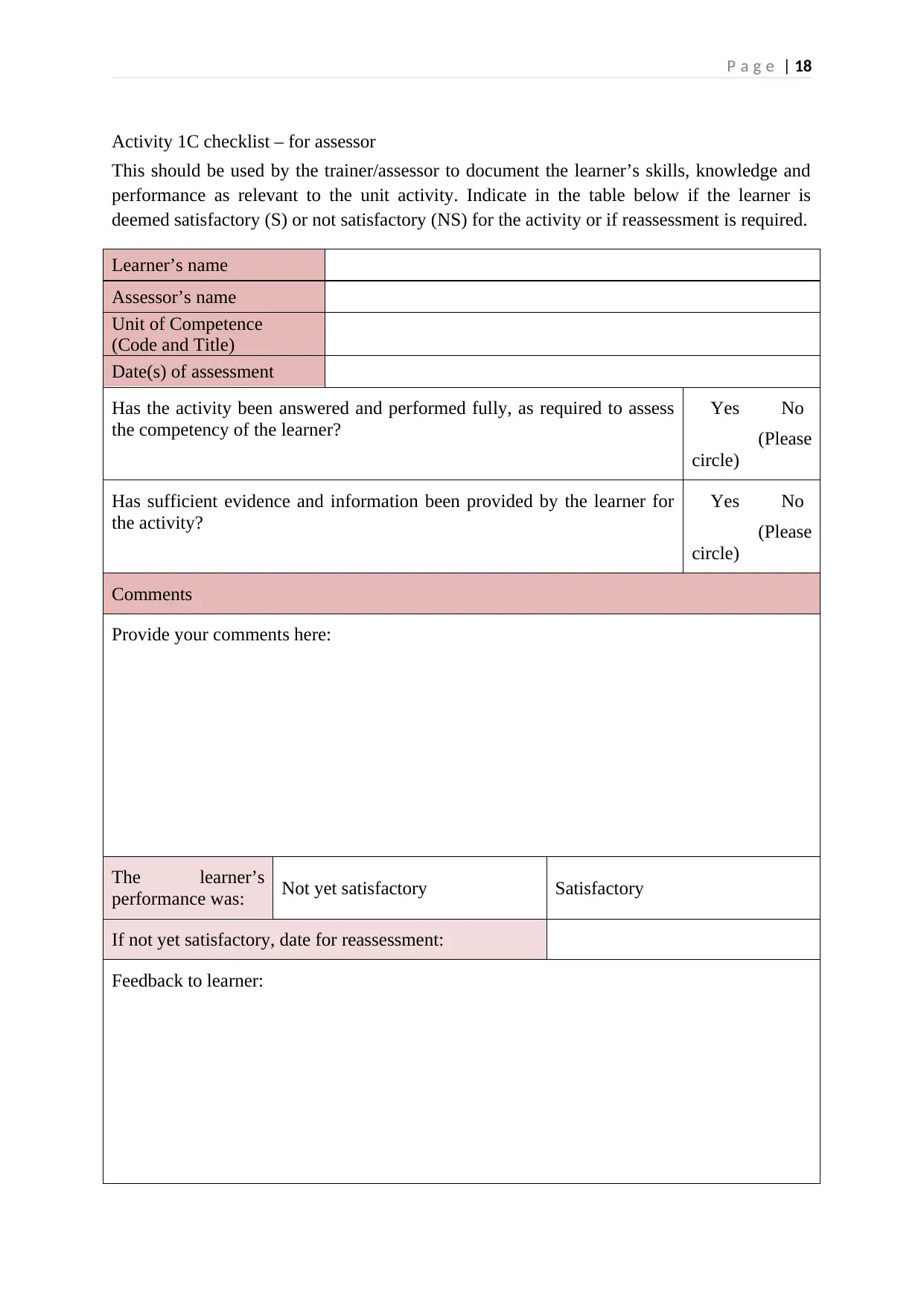
Activity 1C checklist – for assessor
This should be used by the trainer/assessor to document the learner’s skills, knowledge and
performance as relevant to the unit activity. Indicate in the table below if the learner is
deemed satisfactory (S) or not satisfactory (NS) for the activity or if reassessment is required.
Learner’s name
Assessor’s name
Unit of Competence
(Code and Title)
Date(s) of assessment
Has the activity been answered and performed fully, as required to assess
the competency of the learner?
Yes No
(Please
circle)
Has sufficient evidence and information been provided by the learner for
the activity?
Yes No
(Please
circle)
Comments
Provide your comments here:
The learner’s
performance was: Not yet satisfactory Satisfactory
If not yet satisfactory, date for reassessment:
Feedback to learner:
Paraphrase This Document
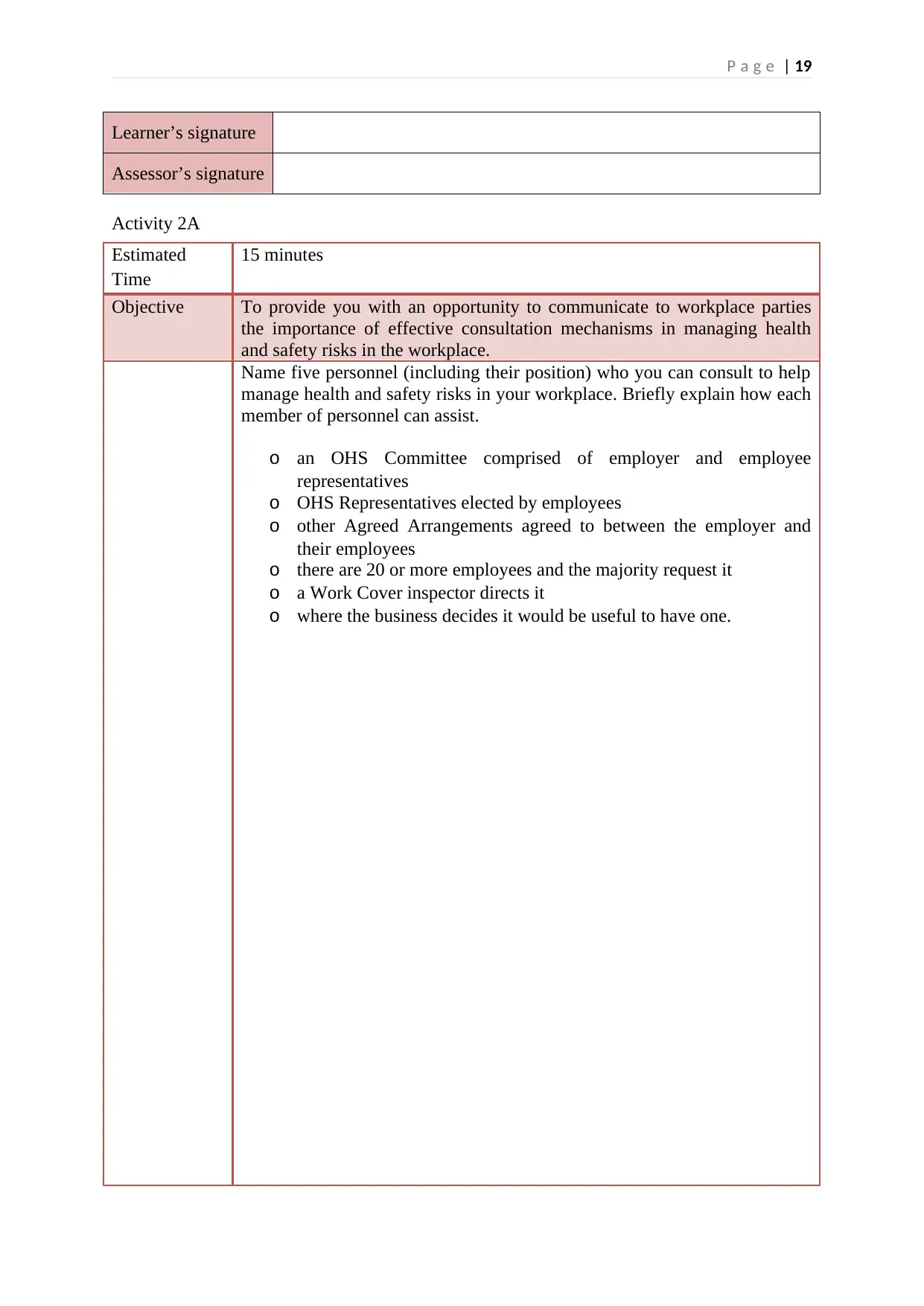
Learner’s signature
Assessor’s signature
Activity 2A
Estimated
Time
15 minutes
Objective To provide you with an opportunity to communicate to workplace parties
the importance of effective consultation mechanisms in managing health
and safety risks in the workplace.
Name five personnel (including their position) who you can consult to help
manage health and safety risks in your workplace. Briefly explain how each
member of personnel can assist.
o an OHS Committee comprised of employer and employee
representatives
o OHS Representatives elected by employees
o other Agreed Arrangements agreed to between the employer and
their employees
o there are 20 or more employees and the majority request it
o a Work Cover inspector directs it
o where the business decides it would be useful to have one.

⊘ This is a preview!⊘
Do you want full access?
Subscribe today to unlock all pages.

Trusted by 1+ million students worldwide
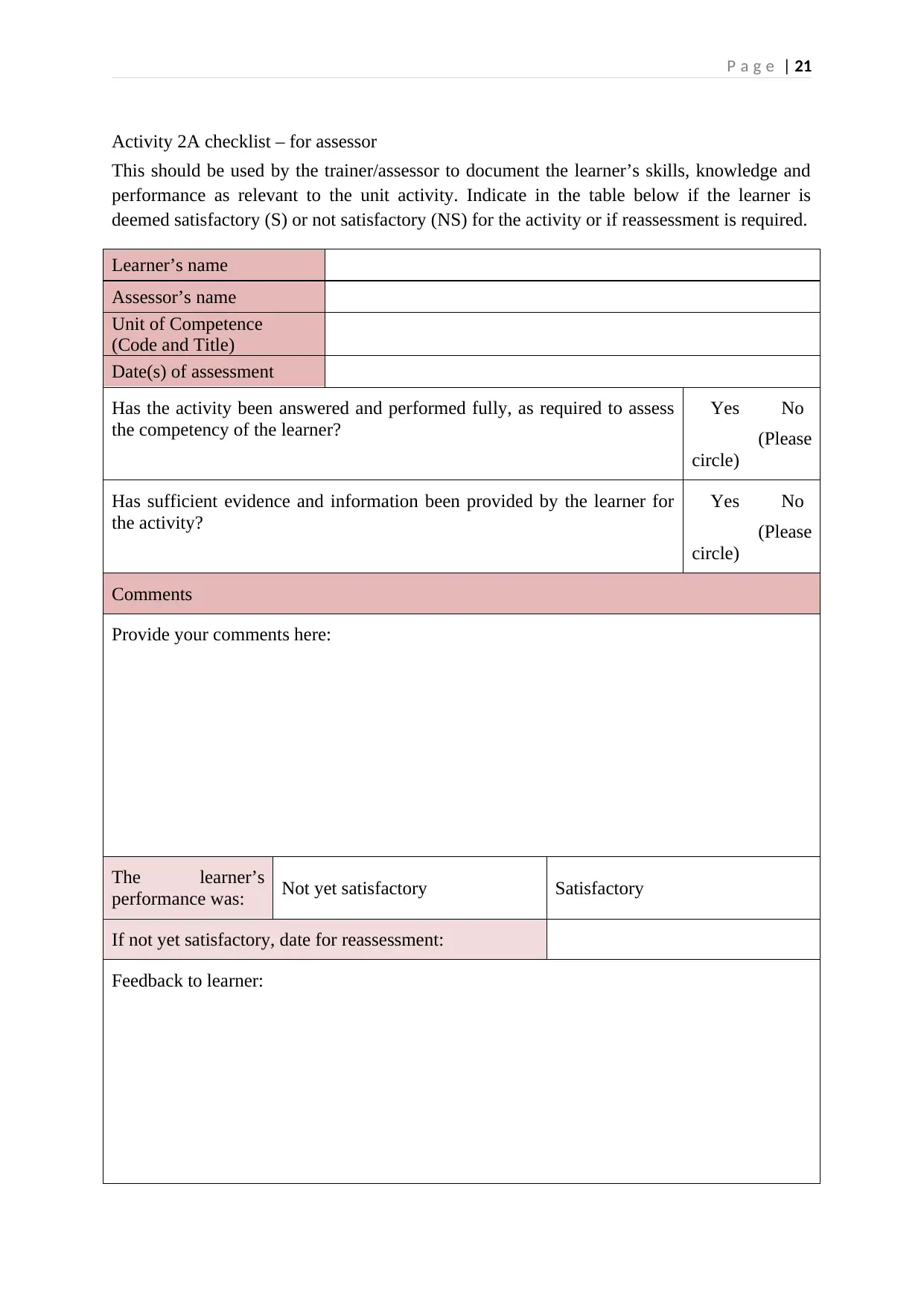
Activity 2A checklist – for assessor
This should be used by the trainer/assessor to document the learner’s skills, knowledge and
performance as relevant to the unit activity. Indicate in the table below if the learner is
deemed satisfactory (S) or not satisfactory (NS) for the activity or if reassessment is required.
Learner’s name
Assessor’s name
Unit of Competence
(Code and Title)
Date(s) of assessment
Has the activity been answered and performed fully, as required to assess
the competency of the learner?
Yes No
(Please
circle)
Has sufficient evidence and information been provided by the learner for
the activity?
Yes No
(Please
circle)
Comments
Provide your comments here:
The learner’s
performance was: Not yet satisfactory Satisfactory
If not yet satisfactory, date for reassessment:
Feedback to learner:
Paraphrase This Document
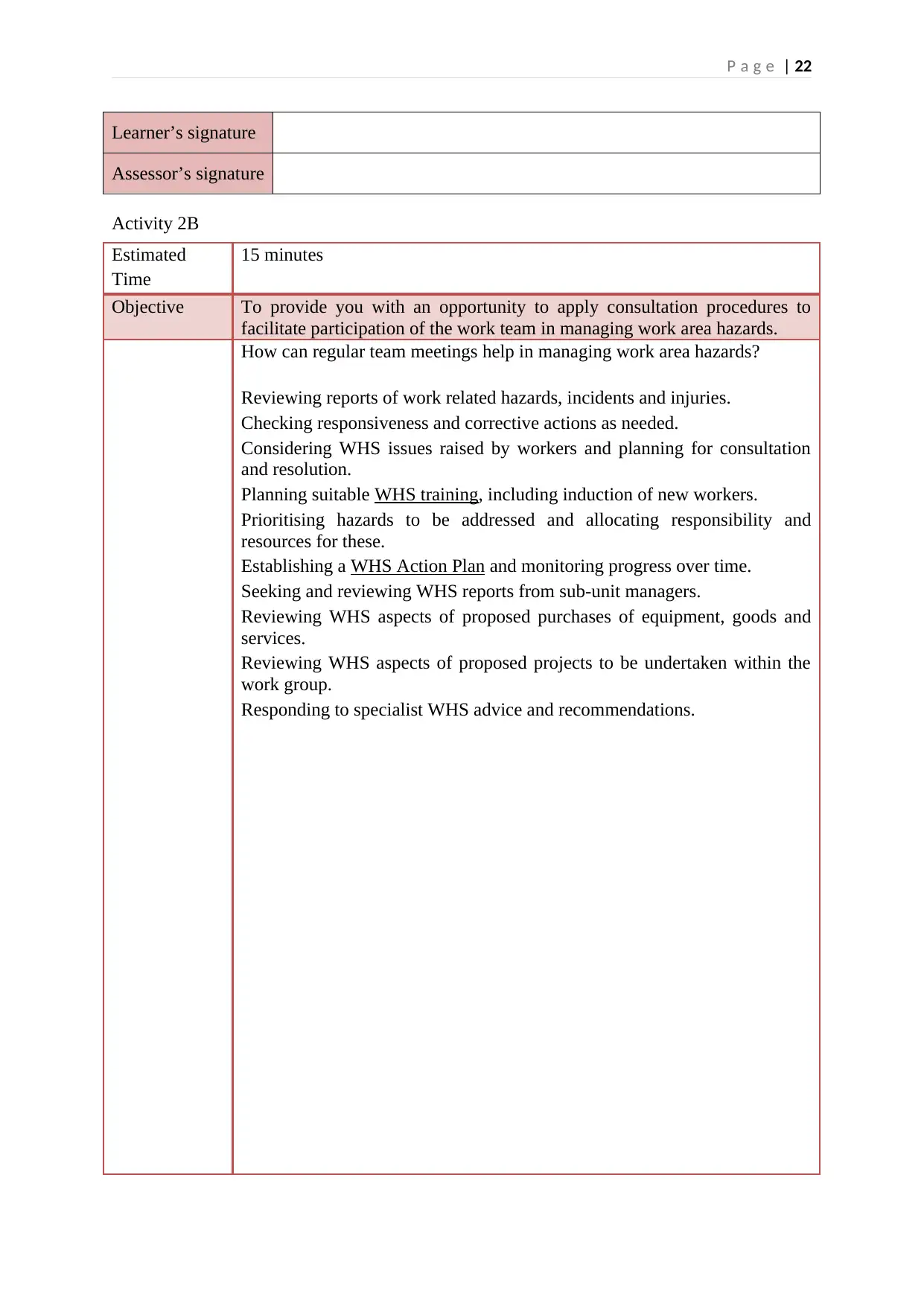
Learner’s signature
Assessor’s signature
Activity 2B
Estimated
Time
15 minutes
Objective To provide you with an opportunity to apply consultation procedures to
facilitate participation of the work team in managing work area hazards.
How can regular team meetings help in managing work area hazards?
Reviewing reports of work related hazards, incidents and injuries.
Checking responsiveness and corrective actions as needed.
Considering WHS issues raised by workers and planning for consultation
and resolution.
Planning suitable WHS training, including induction of new workers.
Prioritising hazards to be addressed and allocating responsibility and
resources for these.
Establishing a WHS Action Plan and monitoring progress over time.
Seeking and reviewing WHS reports from sub-unit managers.
Reviewing WHS aspects of proposed purchases of equipment, goods and
services.
Reviewing WHS aspects of proposed projects to be undertaken within the
work group.
Responding to specialist WHS advice and recommendations.

⊘ This is a preview!⊘
Do you want full access?
Subscribe today to unlock all pages.

Trusted by 1+ million students worldwide
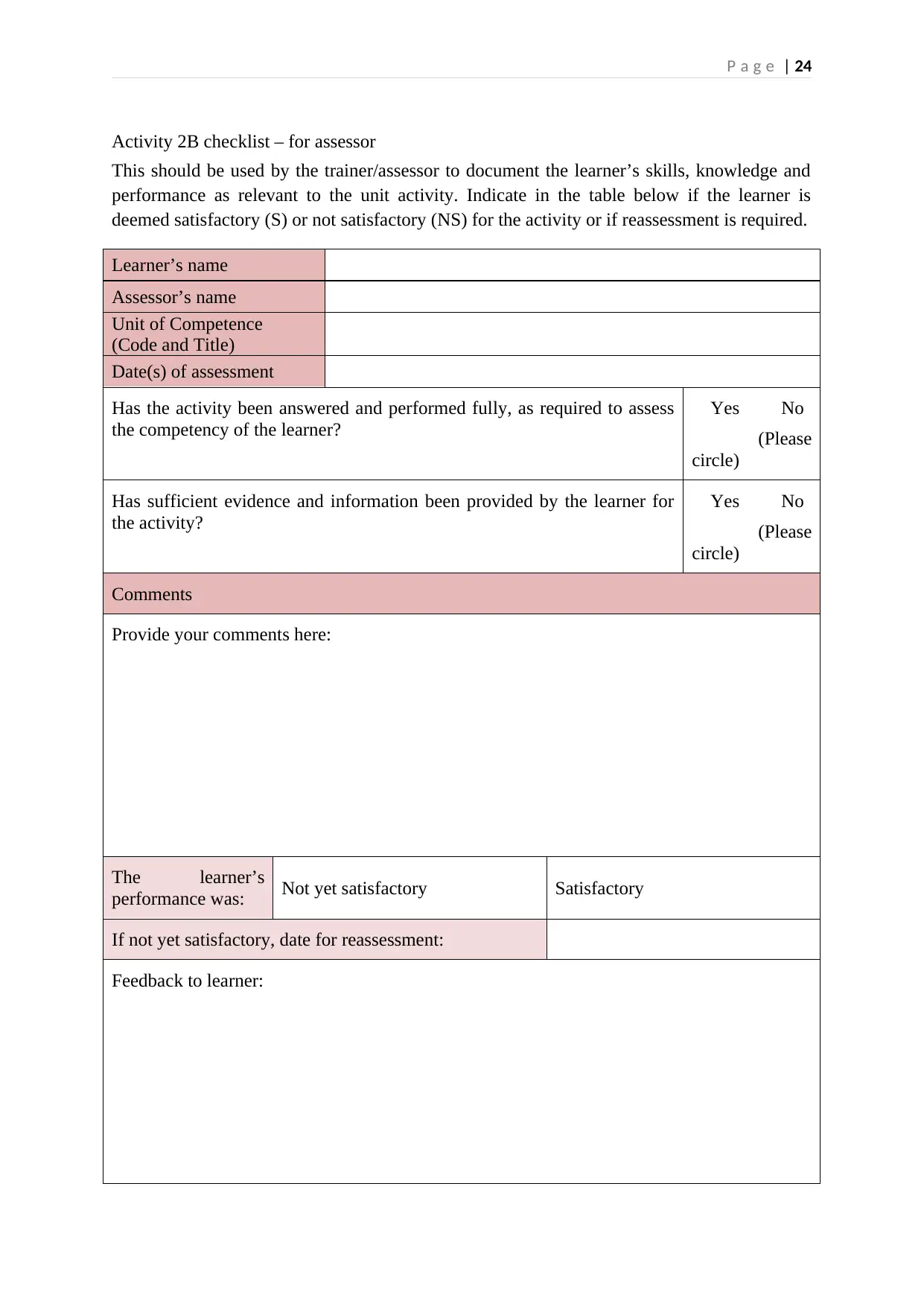
Activity 2B checklist – for assessor
This should be used by the trainer/assessor to document the learner’s skills, knowledge and
performance as relevant to the unit activity. Indicate in the table below if the learner is
deemed satisfactory (S) or not satisfactory (NS) for the activity or if reassessment is required.
Learner’s name
Assessor’s name
Unit of Competence
(Code and Title)
Date(s) of assessment
Has the activity been answered and performed fully, as required to assess
the competency of the learner?
Yes No
(Please
circle)
Has sufficient evidence and information been provided by the learner for
the activity?
Yes No
(Please
circle)
Comments
Provide your comments here:
The learner’s
performance was: Not yet satisfactory Satisfactory
If not yet satisfactory, date for reassessment:
Feedback to learner:
Paraphrase This Document
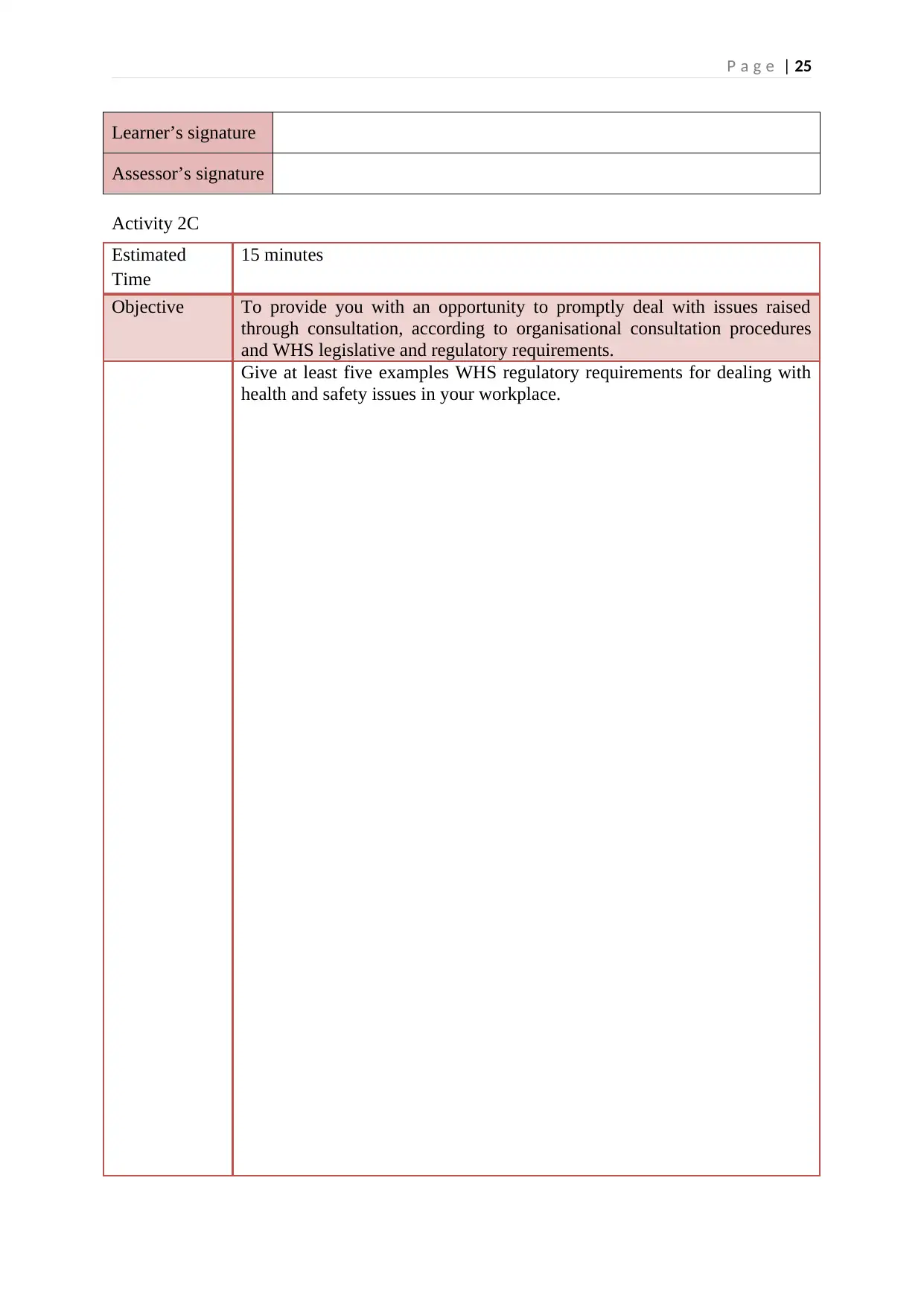
Learner’s signature
Assessor’s signature
Activity 2C
Estimated
Time
15 minutes
Objective To provide you with an opportunity to promptly deal with issues raised
through consultation, according to organisational consultation procedures
and WHS legislative and regulatory requirements.
Give at least five examples WHS regulatory requirements for dealing with
health and safety issues in your workplace.

⊘ This is a preview!⊘
Do you want full access?
Subscribe today to unlock all pages.

Trusted by 1+ million students worldwide
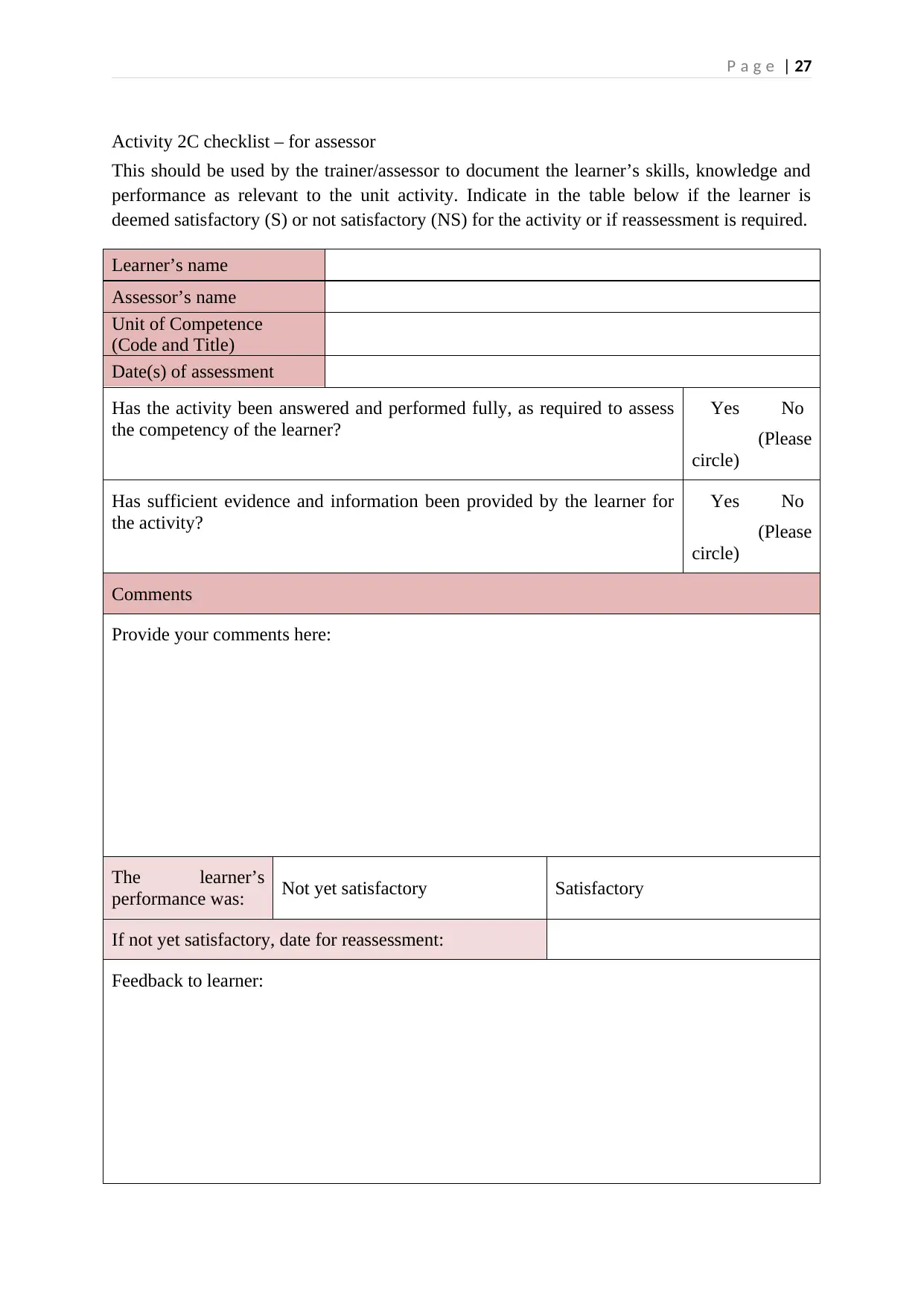
Activity 2C checklist – for assessor
This should be used by the trainer/assessor to document the learner’s skills, knowledge and
performance as relevant to the unit activity. Indicate in the table below if the learner is
deemed satisfactory (S) or not satisfactory (NS) for the activity or if reassessment is required.
Learner’s name
Assessor’s name
Unit of Competence
(Code and Title)
Date(s) of assessment
Has the activity been answered and performed fully, as required to assess
the competency of the learner?
Yes No
(Please
circle)
Has sufficient evidence and information been provided by the learner for
the activity?
Yes No
(Please
circle)
Comments
Provide your comments here:
The learner’s
performance was: Not yet satisfactory Satisfactory
If not yet satisfactory, date for reassessment:
Feedback to learner:
Paraphrase This Document
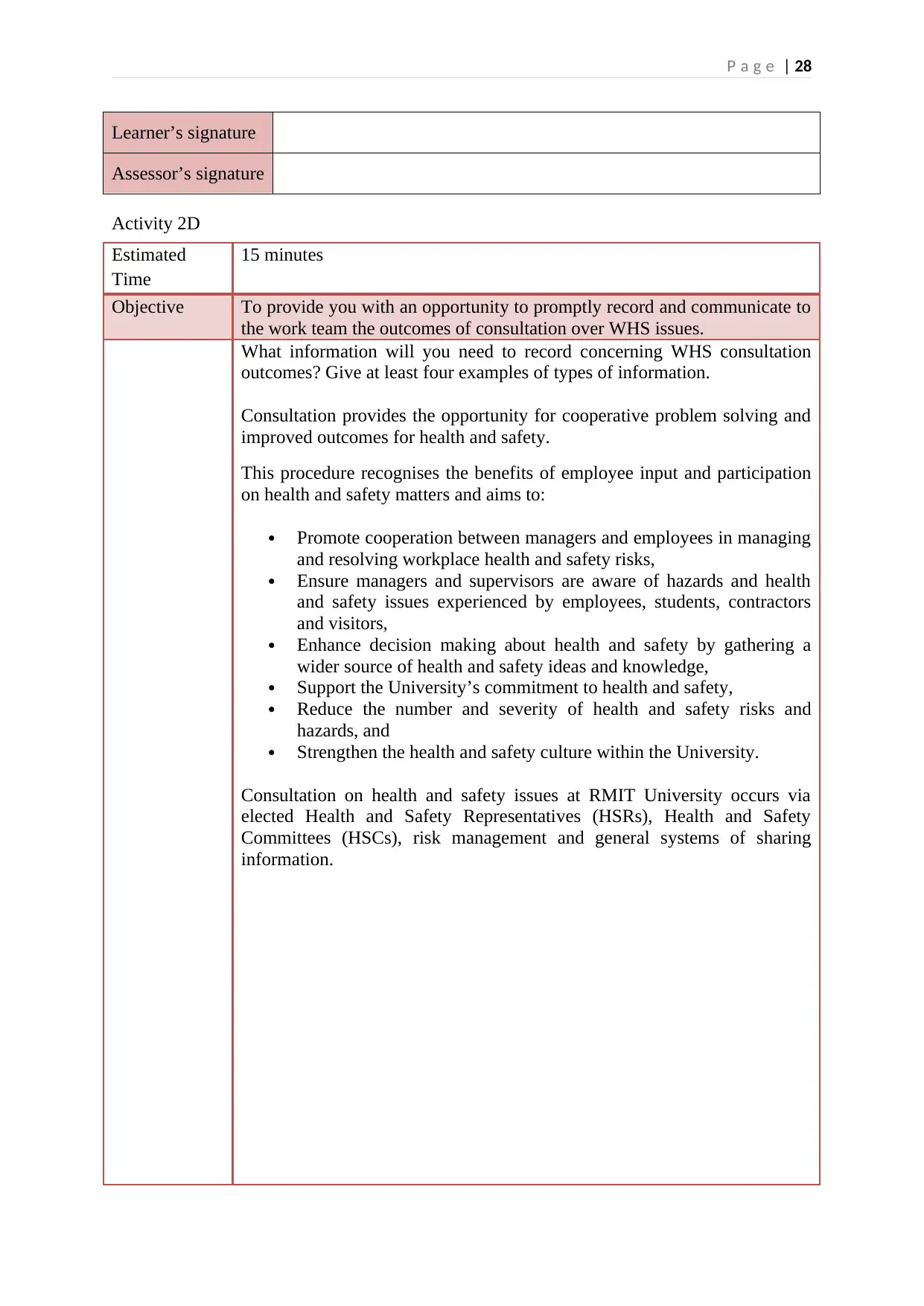
Learner’s signature
Assessor’s signature
Activity 2D
Estimated
Time
15 minutes
Objective To provide you with an opportunity to promptly record and communicate to
the work team the outcomes of consultation over WHS issues.
What information will you need to record concerning WHS consultation
outcomes? Give at least four examples of types of information.
Consultation provides the opportunity for cooperative problem solving and
improved outcomes for health and safety.
This procedure recognises the benefits of employee input and participation
on health and safety matters and aims to:
Promote cooperation between managers and employees in managing
and resolving workplace health and safety risks,
Ensure managers and supervisors are aware of hazards and health
and safety issues experienced by employees, students, contractors
and visitors,
Enhance decision making about health and safety by gathering a
wider source of health and safety ideas and knowledge,
Support the University’s commitment to health and safety,
Reduce the number and severity of health and safety risks and
hazards, and
Strengthen the health and safety culture within the University.
Consultation on health and safety issues at RMIT University occurs via
elected Health and Safety Representatives (HSRs), Health and Safety
Committees (HSCs), risk management and general systems of sharing
information.

⊘ This is a preview!⊘
Do you want full access?
Subscribe today to unlock all pages.

Trusted by 1+ million students worldwide
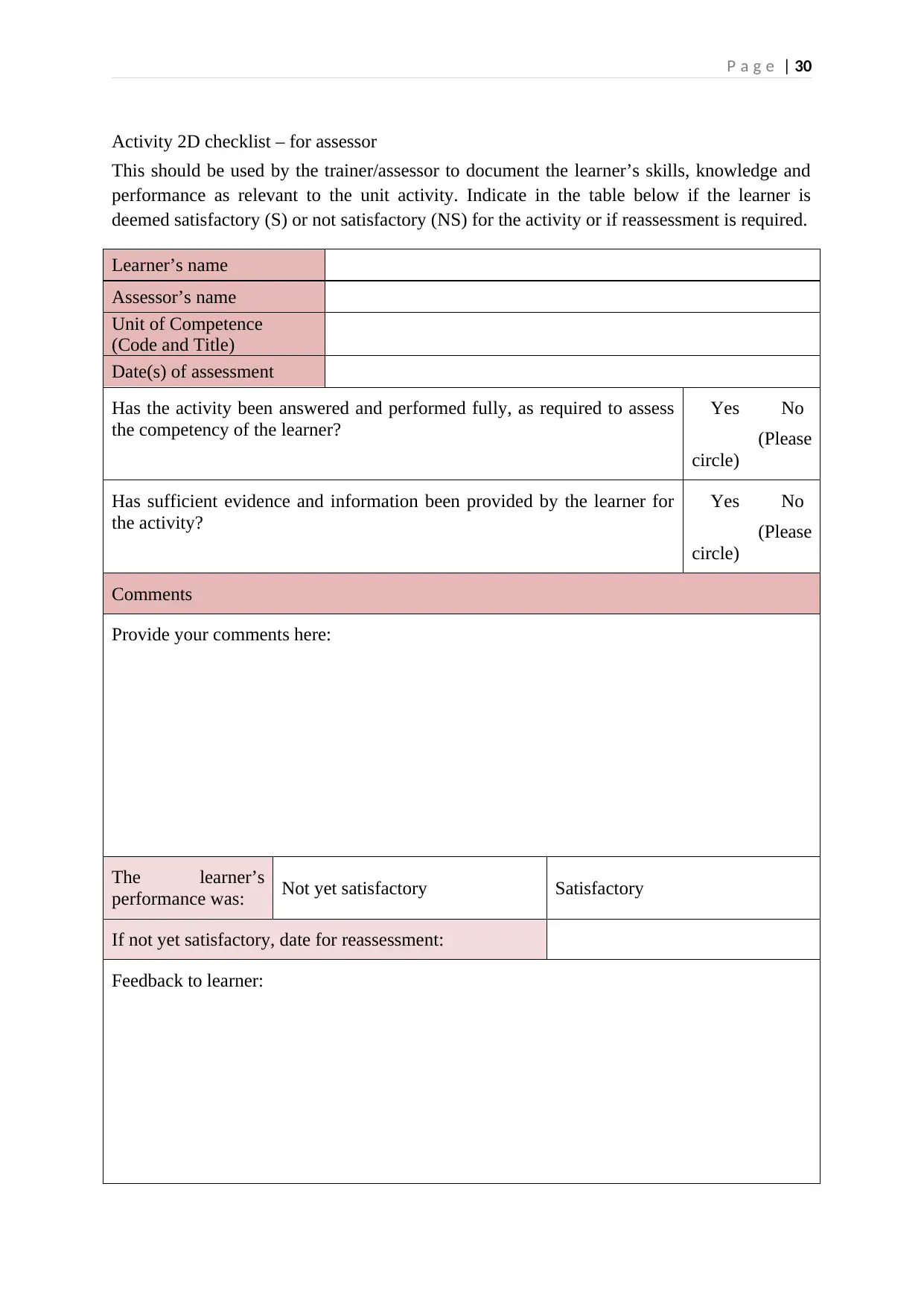
Activity 2D checklist – for assessor
This should be used by the trainer/assessor to document the learner’s skills, knowledge and
performance as relevant to the unit activity. Indicate in the table below if the learner is
deemed satisfactory (S) or not satisfactory (NS) for the activity or if reassessment is required.
Learner’s name
Assessor’s name
Unit of Competence
(Code and Title)
Date(s) of assessment
Has the activity been answered and performed fully, as required to assess
the competency of the learner?
Yes No
(Please
circle)
Has sufficient evidence and information been provided by the learner for
the activity?
Yes No
(Please
circle)
Comments
Provide your comments here:
The learner’s
performance was: Not yet satisfactory Satisfactory
If not yet satisfactory, date for reassessment:
Feedback to learner:
Paraphrase This Document

Learner’s signature
Assessor’s signature
Activity 3A
Estimated
Time
15 minutes
Objective To provide you with an opportunity to identify WHS training needs
according to organisational requirements and WHS legislative and
regulatory requirements.
Give examples of five training needs that your workforce has.
Training is an investment in your business and can lead to increased
productivity, enthusiastic staff, higher morale, increased profit and a
positive business reputation.
You will need to determine what training employees need, particularly new
employees, to ensure that they are able to complete the work you need them
to do. This process is commonly referred to as a training needs analysis
(TNA).
A TNA will help you to identify what training might be required to bridge
the gap between an employee’s current skill level and the skill level that you
need them to have. To make sure your training investment is properly
targeted, consider:
the role of each staff member and what you want them to achieve and
contribute to your business; and
whether each staff member has the skills and knowledge to do what
you need them to do. If not, identify what skills or knowledge they
need and put in place training in these areas to up skill them
To help you identify skills gaps and where training might be required for
current and future staff, use the Training needs analysis template. A TNA
can be applied across your business, from individual staff members to
whole departments.

⊘ This is a preview!⊘
Do you want full access?
Subscribe today to unlock all pages.

Trusted by 1+ million students worldwide
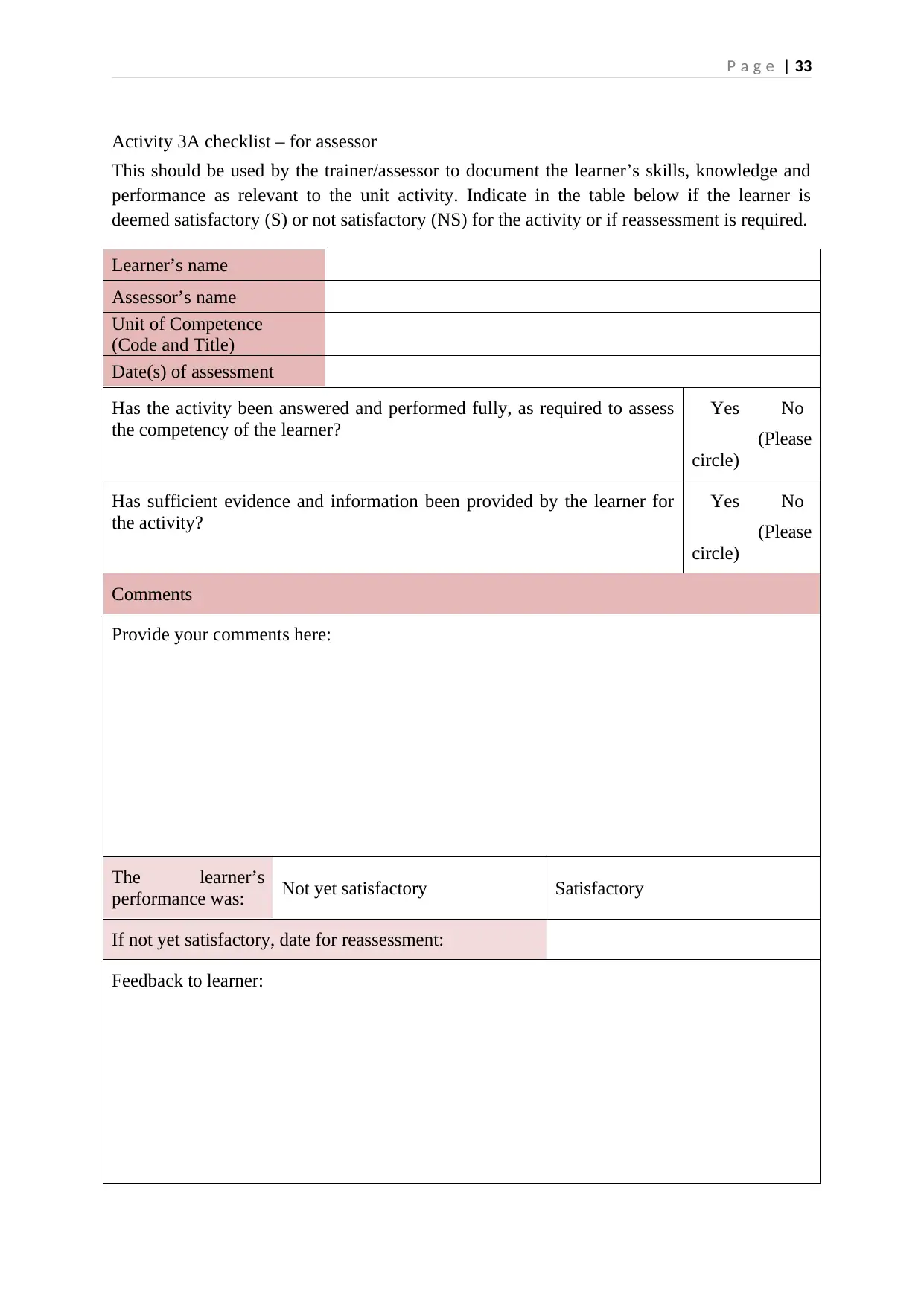
Activity 3A checklist – for assessor
This should be used by the trainer/assessor to document the learner’s skills, knowledge and
performance as relevant to the unit activity. Indicate in the table below if the learner is
deemed satisfactory (S) or not satisfactory (NS) for the activity or if reassessment is required.
Learner’s name
Assessor’s name
Unit of Competence
(Code and Title)
Date(s) of assessment
Has the activity been answered and performed fully, as required to assess
the competency of the learner?
Yes No
(Please
circle)
Has sufficient evidence and information been provided by the learner for
the activity?
Yes No
(Please
circle)
Comments
Provide your comments here:
The learner’s
performance was: Not yet satisfactory Satisfactory
If not yet satisfactory, date for reassessment:
Feedback to learner:
Paraphrase This Document
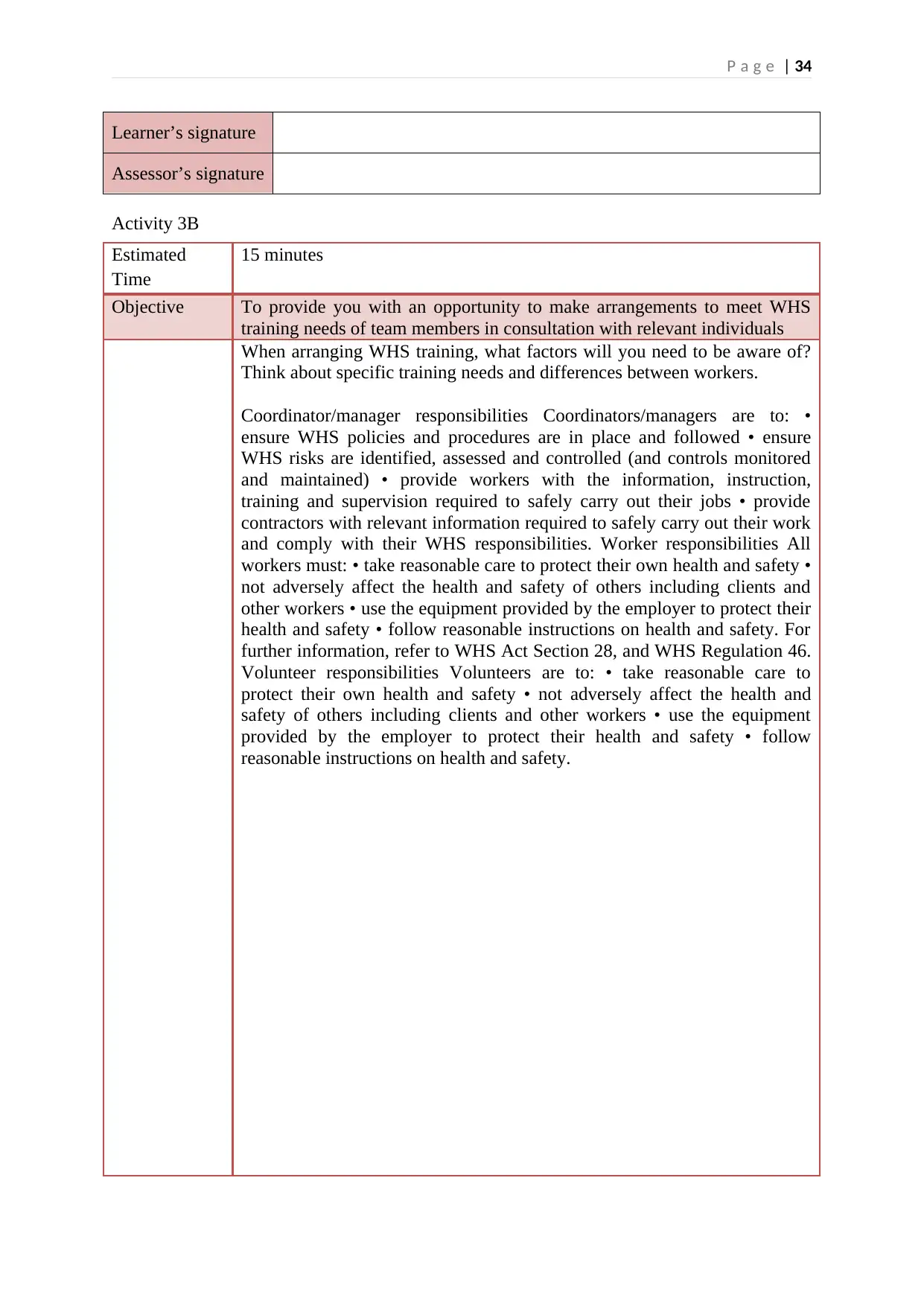
Learner’s signature
Assessor’s signature
Activity 3B
Estimated
Time
15 minutes
Objective To provide you with an opportunity to make arrangements to meet WHS
training needs of team members in consultation with relevant individuals
When arranging WHS training, what factors will you need to be aware of?
Think about specific training needs and differences between workers.
Coordinator/manager responsibilities Coordinators/managers are to: •
ensure WHS policies and procedures are in place and followed • ensure
WHS risks are identified, assessed and controlled (and controls monitored
and maintained) • provide workers with the information, instruction,
training and supervision required to safely carry out their jobs • provide
contractors with relevant information required to safely carry out their work
and comply with their WHS responsibilities. Worker responsibilities All
workers must: • take reasonable care to protect their own health and safety •
not adversely affect the health and safety of others including clients and
other workers • use the equipment provided by the employer to protect their
health and safety • follow reasonable instructions on health and safety. For
further information, refer to WHS Act Section 28, and WHS Regulation 46.
Volunteer responsibilities Volunteers are to: • take reasonable care to
protect their own health and safety • not adversely affect the health and
safety of others including clients and other workers • use the equipment
provided by the employer to protect their health and safety • follow
reasonable instructions on health and safety.

⊘ This is a preview!⊘
Do you want full access?
Subscribe today to unlock all pages.

Trusted by 1+ million students worldwide
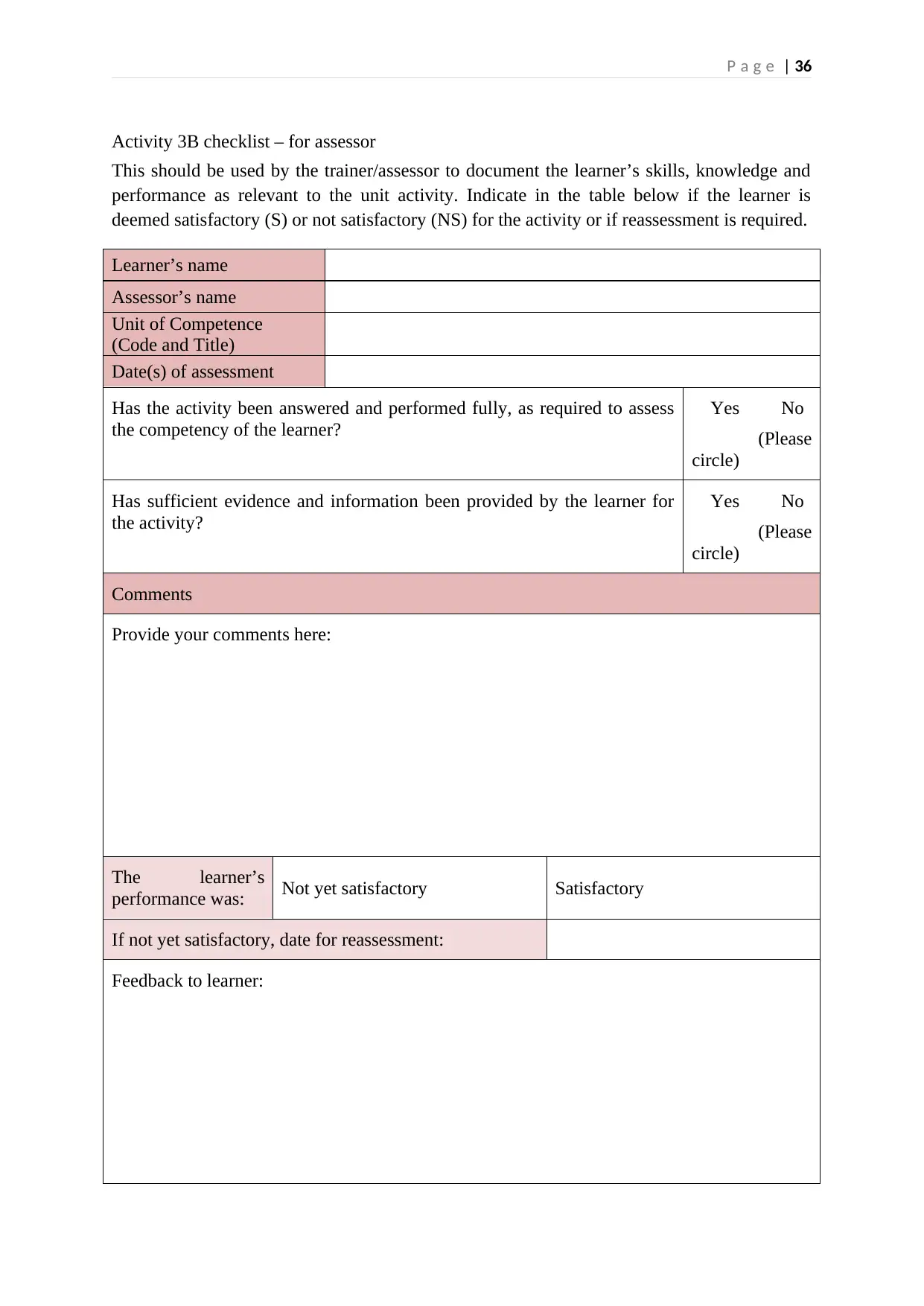
Activity 3B checklist – for assessor
This should be used by the trainer/assessor to document the learner’s skills, knowledge and
performance as relevant to the unit activity. Indicate in the table below if the learner is
deemed satisfactory (S) or not satisfactory (NS) for the activity or if reassessment is required.
Learner’s name
Assessor’s name
Unit of Competence
(Code and Title)
Date(s) of assessment
Has the activity been answered and performed fully, as required to assess
the competency of the learner?
Yes No
(Please
circle)
Has sufficient evidence and information been provided by the learner for
the activity?
Yes No
(Please
circle)
Comments
Provide your comments here:
The learner’s
performance was: Not yet satisfactory Satisfactory
If not yet satisfactory, date for reassessment:
Feedback to learner:
Paraphrase This Document
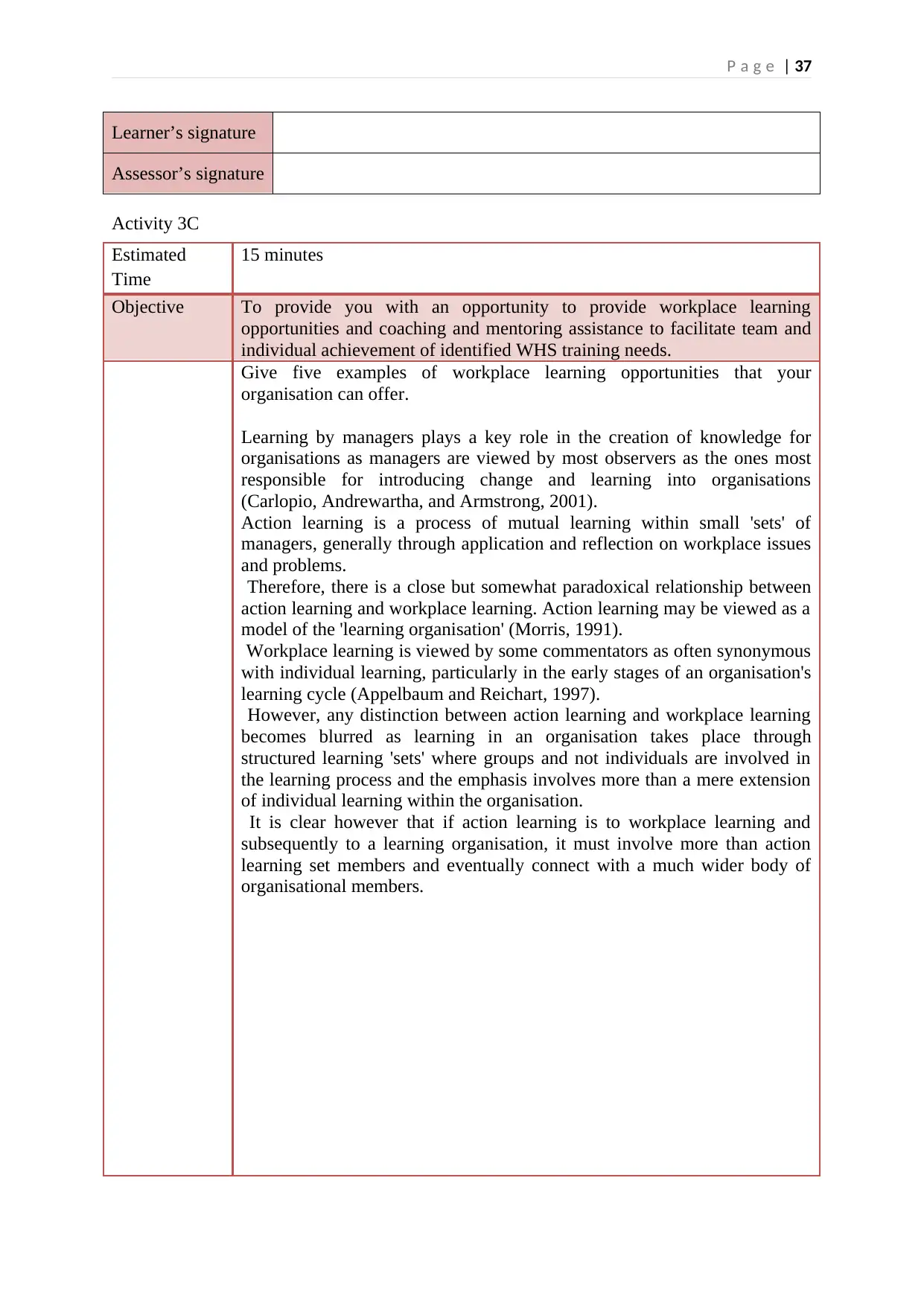
Learner’s signature
Assessor’s signature
Activity 3C
Estimated
Time
15 minutes
Objective To provide you with an opportunity to provide workplace learning
opportunities and coaching and mentoring assistance to facilitate team and
individual achievement of identified WHS training needs.
Give five examples of workplace learning opportunities that your
organisation can offer.
Learning by managers plays a key role in the creation of knowledge for
organisations as managers are viewed by most observers as the ones most
responsible for introducing change and learning into organisations
(Carlopio, Andrewartha, and Armstrong, 2001).
Action learning is a process of mutual learning within small 'sets' of
managers, generally through application and reflection on workplace issues
and problems.
Therefore, there is a close but somewhat paradoxical relationship between
action learning and workplace learning. Action learning may be viewed as a
model of the 'learning organisation' (Morris, 1991).
Workplace learning is viewed by some commentators as often synonymous
with individual learning, particularly in the early stages of an organisation's
learning cycle (Appelbaum and Reichart, 1997).
However, any distinction between action learning and workplace learning
becomes blurred as learning in an organisation takes place through
structured learning 'sets' where groups and not individuals are involved in
the learning process and the emphasis involves more than a mere extension
of individual learning within the organisation.
It is clear however that if action learning is to workplace learning and
subsequently to a learning organisation, it must involve more than action
learning set members and eventually connect with a much wider body of
organisational members.

⊘ This is a preview!⊘
Do you want full access?
Subscribe today to unlock all pages.

Trusted by 1+ million students worldwide
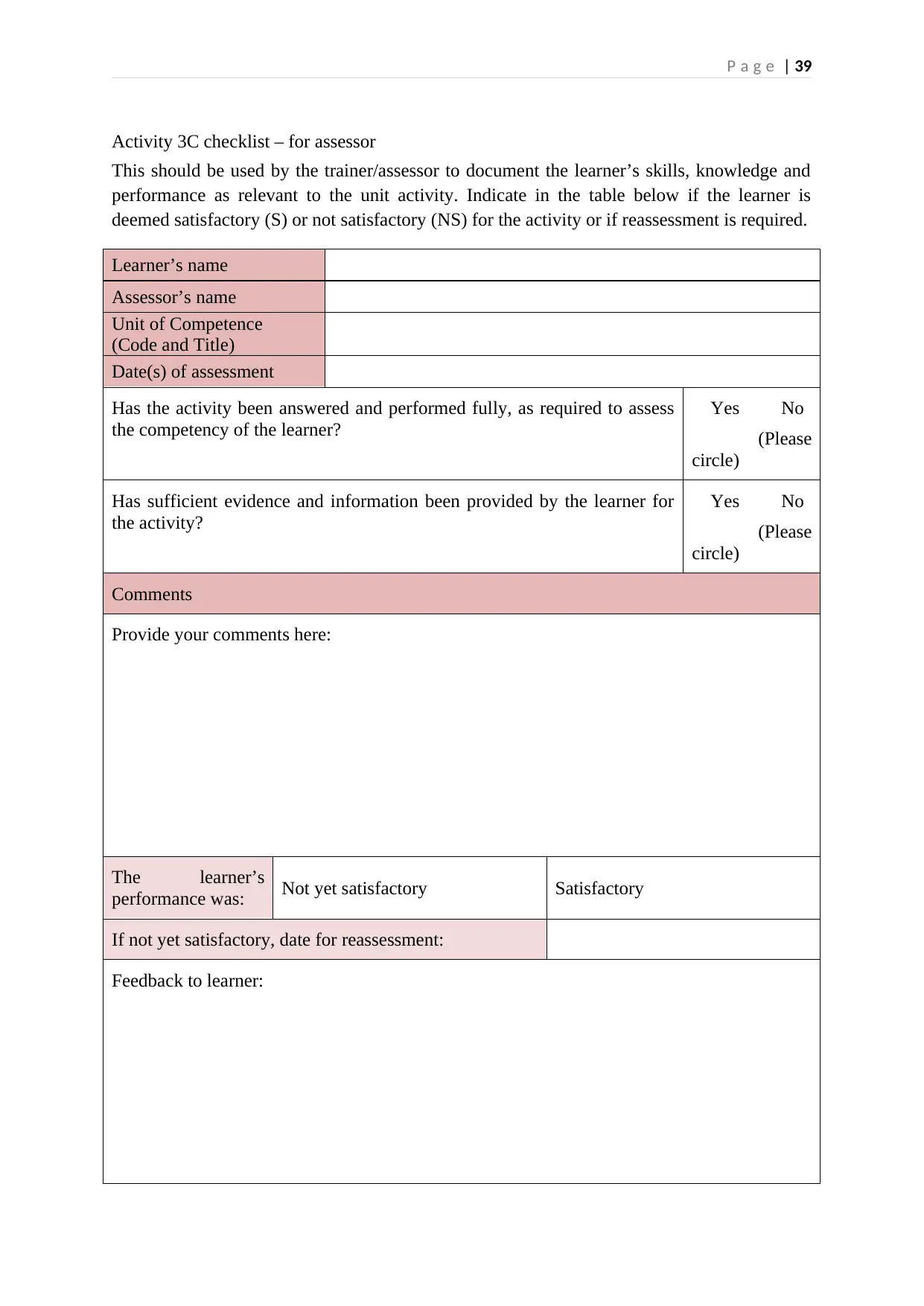
Activity 3C checklist – for assessor
This should be used by the trainer/assessor to document the learner’s skills, knowledge and
performance as relevant to the unit activity. Indicate in the table below if the learner is
deemed satisfactory (S) or not satisfactory (NS) for the activity or if reassessment is required.
Learner’s name
Assessor’s name
Unit of Competence
(Code and Title)
Date(s) of assessment
Has the activity been answered and performed fully, as required to assess
the competency of the learner?
Yes No
(Please
circle)
Has sufficient evidence and information been provided by the learner for
the activity?
Yes No
(Please
circle)
Comments
Provide your comments here:
The learner’s
performance was: Not yet satisfactory Satisfactory
If not yet satisfactory, date for reassessment:
Feedback to learner:
Paraphrase This Document
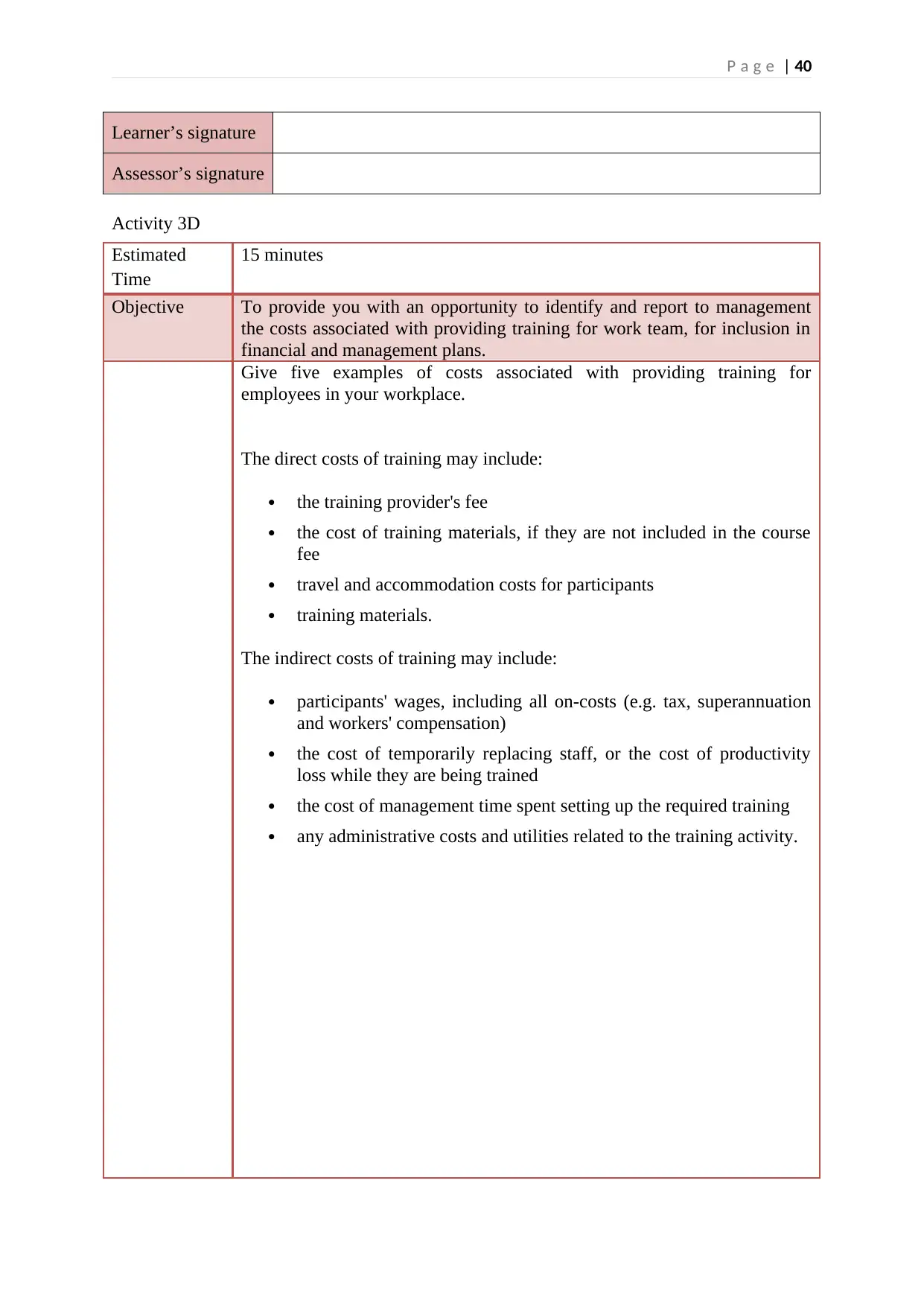
Learner’s signature
Assessor’s signature
Activity 3D
Estimated
Time
15 minutes
Objective To provide you with an opportunity to identify and report to management
the costs associated with providing training for work team, for inclusion in
financial and management plans.
Give five examples of costs associated with providing training for
employees in your workplace.
The direct costs of training may include:
the training provider's fee
the cost of training materials, if they are not included in the course
fee
travel and accommodation costs for participants
training materials.
The indirect costs of training may include:
participants' wages, including all on-costs (e.g. tax, superannuation
and workers' compensation)
the cost of temporarily replacing staff, or the cost of productivity
loss while they are being trained
the cost of management time spent setting up the required training
any administrative costs and utilities related to the training activity.

⊘ This is a preview!⊘
Do you want full access?
Subscribe today to unlock all pages.

Trusted by 1+ million students worldwide
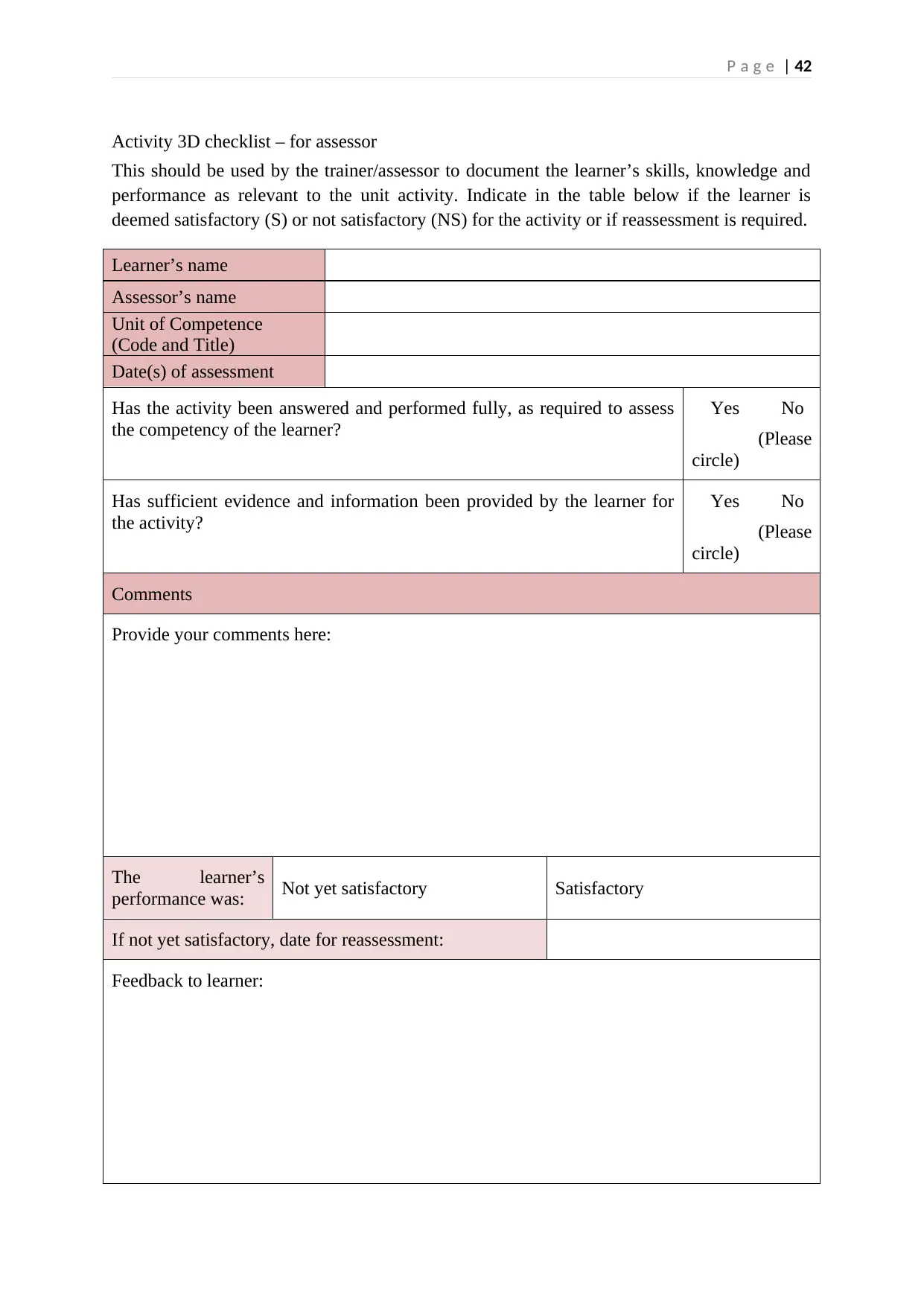
Activity 3D checklist – for assessor
This should be used by the trainer/assessor to document the learner’s skills, knowledge and
performance as relevant to the unit activity. Indicate in the table below if the learner is
deemed satisfactory (S) or not satisfactory (NS) for the activity or if reassessment is required.
Learner’s name
Assessor’s name
Unit of Competence
(Code and Title)
Date(s) of assessment
Has the activity been answered and performed fully, as required to assess
the competency of the learner?
Yes No
(Please
circle)
Has sufficient evidence and information been provided by the learner for
the activity?
Yes No
(Please
circle)
Comments
Provide your comments here:
The learner’s
performance was: Not yet satisfactory Satisfactory
If not yet satisfactory, date for reassessment:
Feedback to learner:
Paraphrase This Document
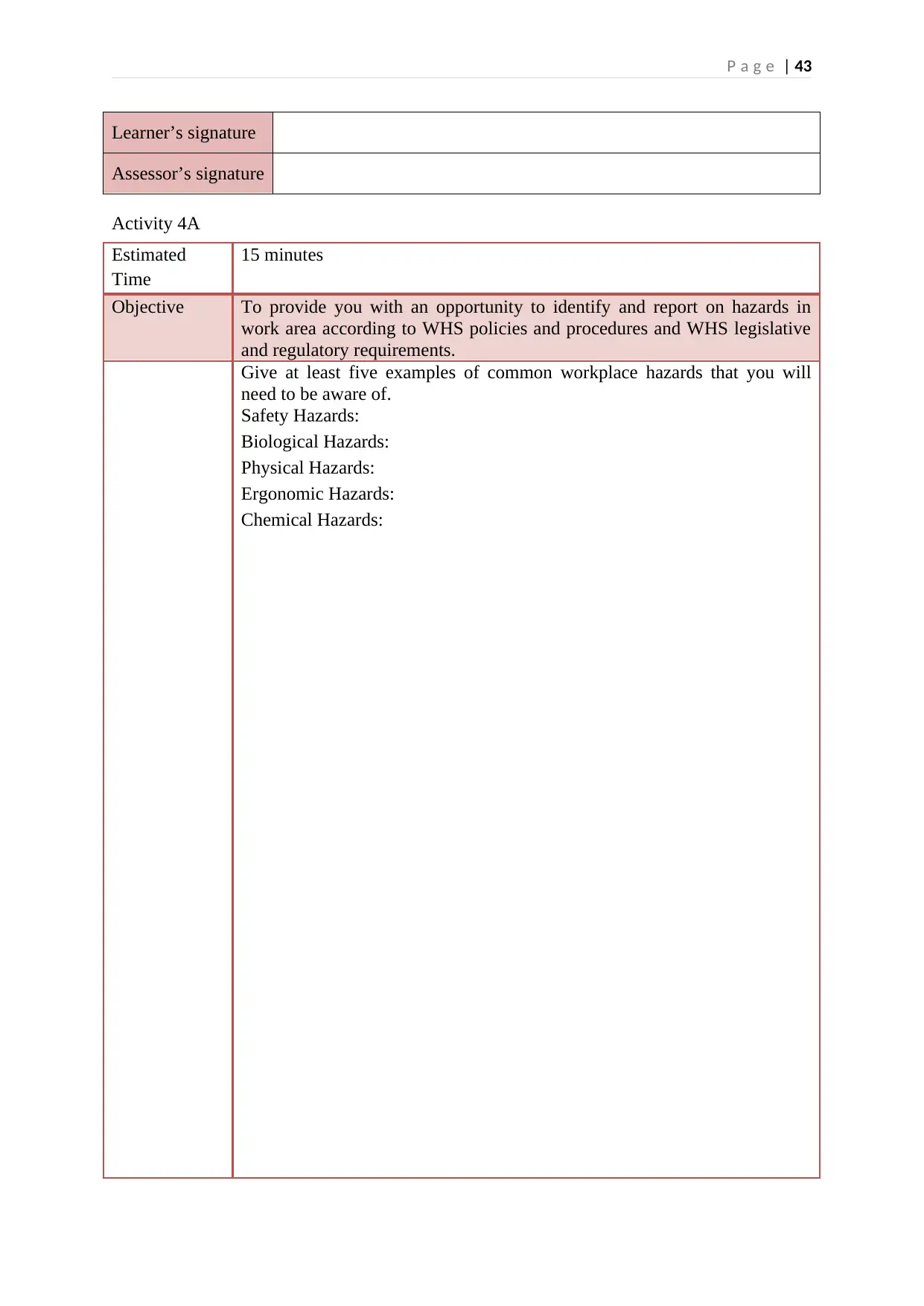
Learner’s signature
Assessor’s signature
Activity 4A
Estimated
Time
15 minutes
Objective To provide you with an opportunity to identify and report on hazards in
work area according to WHS policies and procedures and WHS legislative
and regulatory requirements.
Give at least five examples of common workplace hazards that you will
need to be aware of.
Safety Hazards:
Biological Hazards:
Physical Hazards:
Ergonomic Hazards:
Chemical Hazards:

⊘ This is a preview!⊘
Do you want full access?
Subscribe today to unlock all pages.

Trusted by 1+ million students worldwide
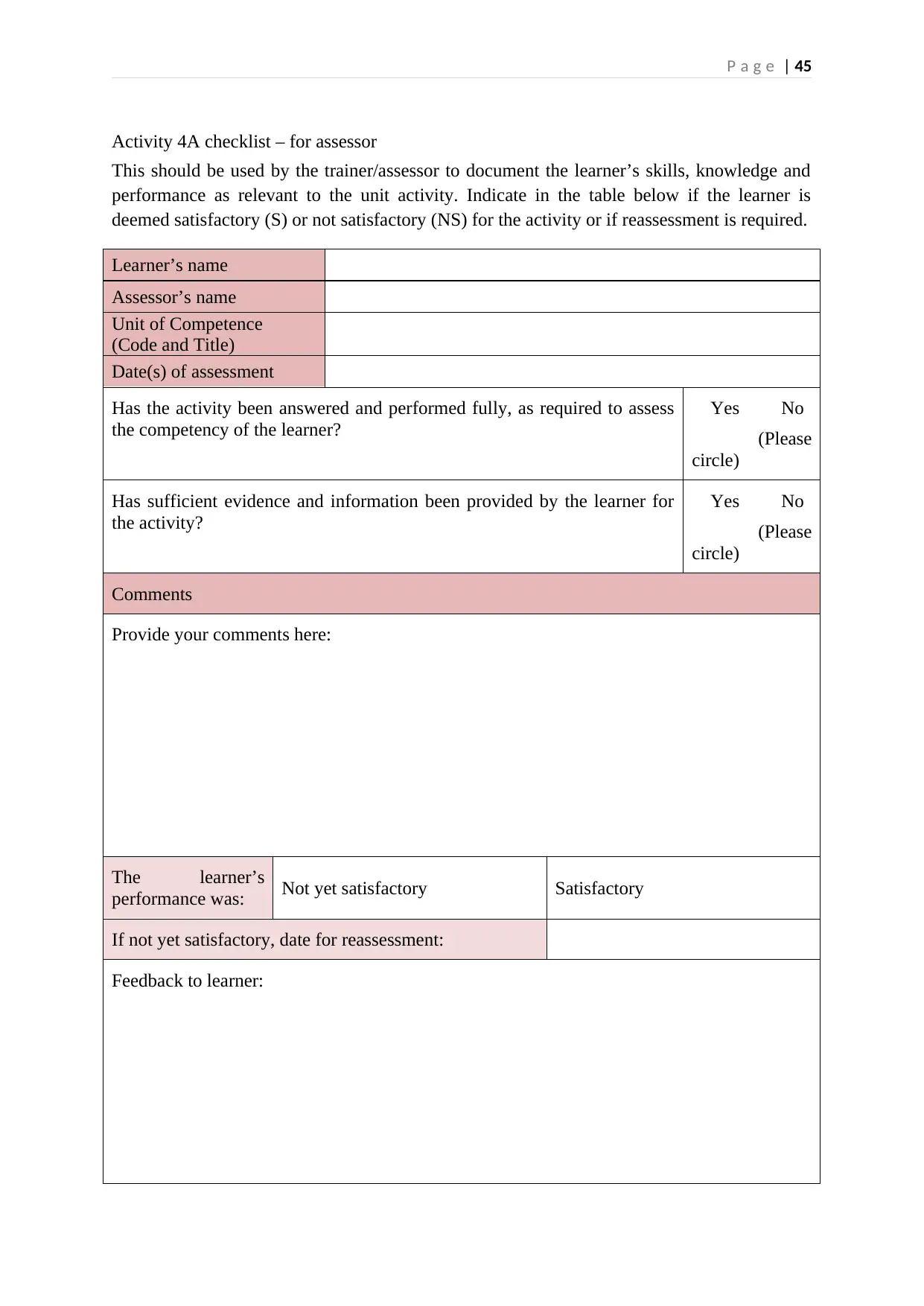
Activity 4A checklist – for assessor
This should be used by the trainer/assessor to document the learner’s skills, knowledge and
performance as relevant to the unit activity. Indicate in the table below if the learner is
deemed satisfactory (S) or not satisfactory (NS) for the activity or if reassessment is required.
Learner’s name
Assessor’s name
Unit of Competence
(Code and Title)
Date(s) of assessment
Has the activity been answered and performed fully, as required to assess
the competency of the learner?
Yes No
(Please
circle)
Has sufficient evidence and information been provided by the learner for
the activity?
Yes No
(Please
circle)
Comments
Provide your comments here:
The learner’s
performance was: Not yet satisfactory Satisfactory
If not yet satisfactory, date for reassessment:
Feedback to learner:
Paraphrase This Document
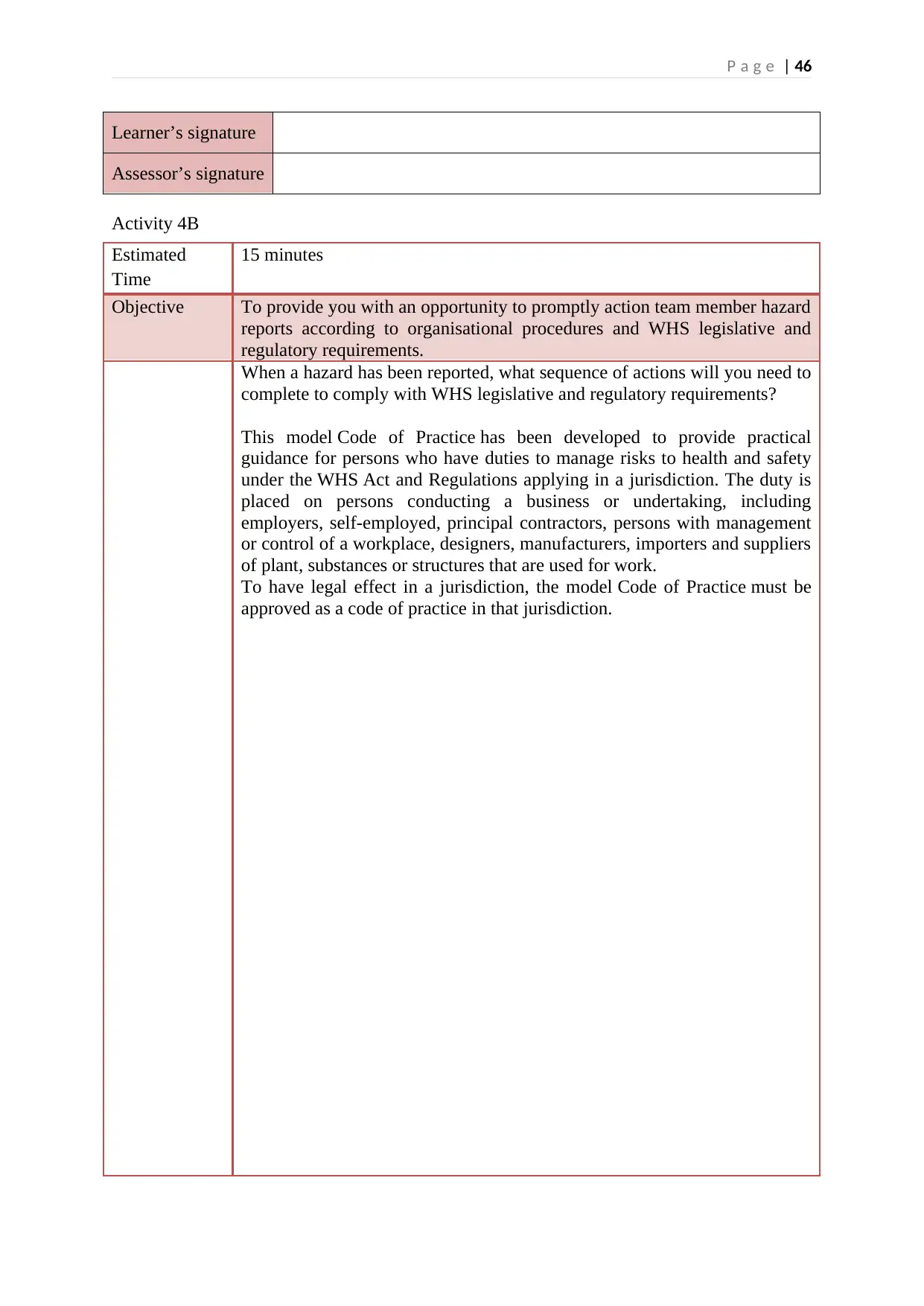
Learner’s signature
Assessor’s signature
Activity 4B
Estimated
Time
15 minutes
Objective To provide you with an opportunity to promptly action team member hazard
reports according to organisational procedures and WHS legislative and
regulatory requirements.
When a hazard has been reported, what sequence of actions will you need to
complete to comply with WHS legislative and regulatory requirements?
This model Code of Practice has been developed to provide practical
guidance for persons who have duties to manage risks to health and safety
under the WHS Act and Regulations applying in a jurisdiction. The duty is
placed on persons conducting a business or undertaking, including
employers, self-employed, principal contractors, persons with management
or control of a workplace, designers, manufacturers, importers and suppliers
of plant, substances or structures that are used for work.
To have legal effect in a jurisdiction, the model Code of Practice must be
approved as a code of practice in that jurisdiction.

⊘ This is a preview!⊘
Do you want full access?
Subscribe today to unlock all pages.

Trusted by 1+ million students worldwide
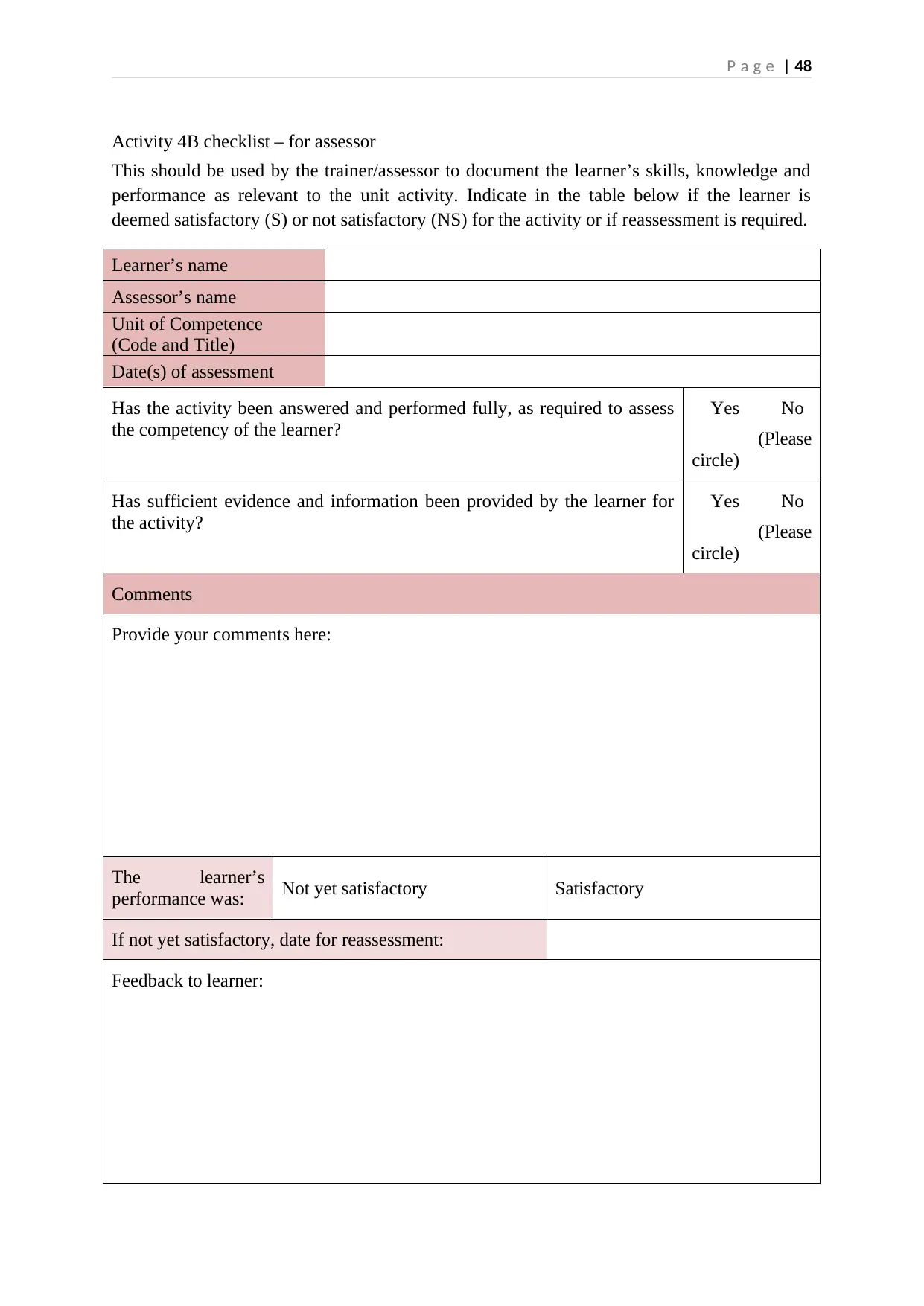
Activity 4B checklist – for assessor
This should be used by the trainer/assessor to document the learner’s skills, knowledge and
performance as relevant to the unit activity. Indicate in the table below if the learner is
deemed satisfactory (S) or not satisfactory (NS) for the activity or if reassessment is required.
Learner’s name
Assessor’s name
Unit of Competence
(Code and Title)
Date(s) of assessment
Has the activity been answered and performed fully, as required to assess
the competency of the learner?
Yes No
(Please
circle)
Has sufficient evidence and information been provided by the learner for
the activity?
Yes No
(Please
circle)
Comments
Provide your comments here:
The learner’s
performance was: Not yet satisfactory Satisfactory
If not yet satisfactory, date for reassessment:
Feedback to learner:
Paraphrase This Document
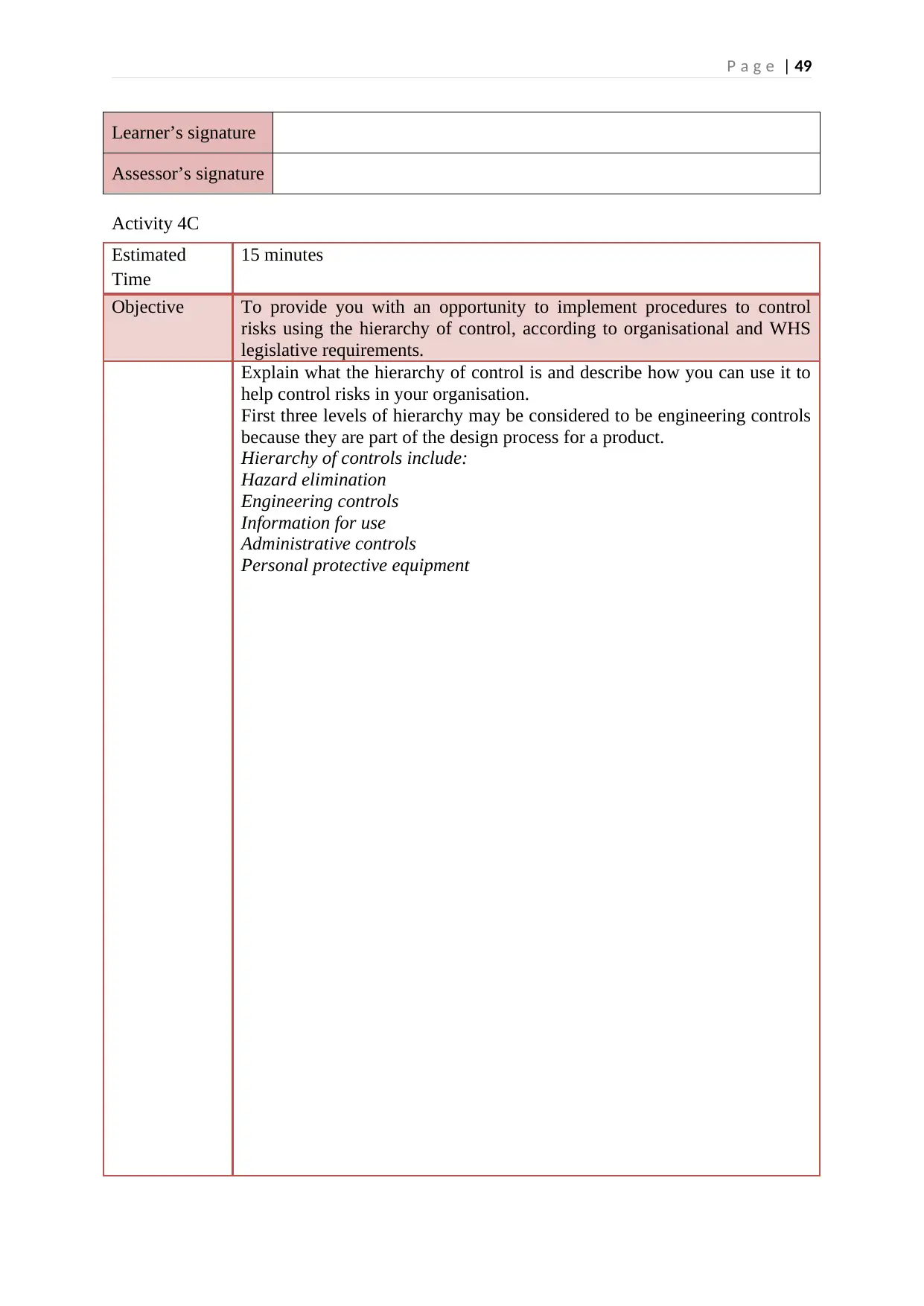
Learner’s signature
Assessor’s signature
Activity 4C
Estimated
Time
15 minutes
Objective To provide you with an opportunity to implement procedures to control
risks using the hierarchy of control, according to organisational and WHS
legislative requirements.
Explain what the hierarchy of control is and describe how you can use it to
help control risks in your organisation.
First three levels of hierarchy may be considered to be engineering controls
because they are part of the design process for a product.
Hierarchy of controls include:
Hazard elimination
Engineering controls
Information for use
Administrative controls
Personal protective equipment

⊘ This is a preview!⊘
Do you want full access?
Subscribe today to unlock all pages.

Trusted by 1+ million students worldwide
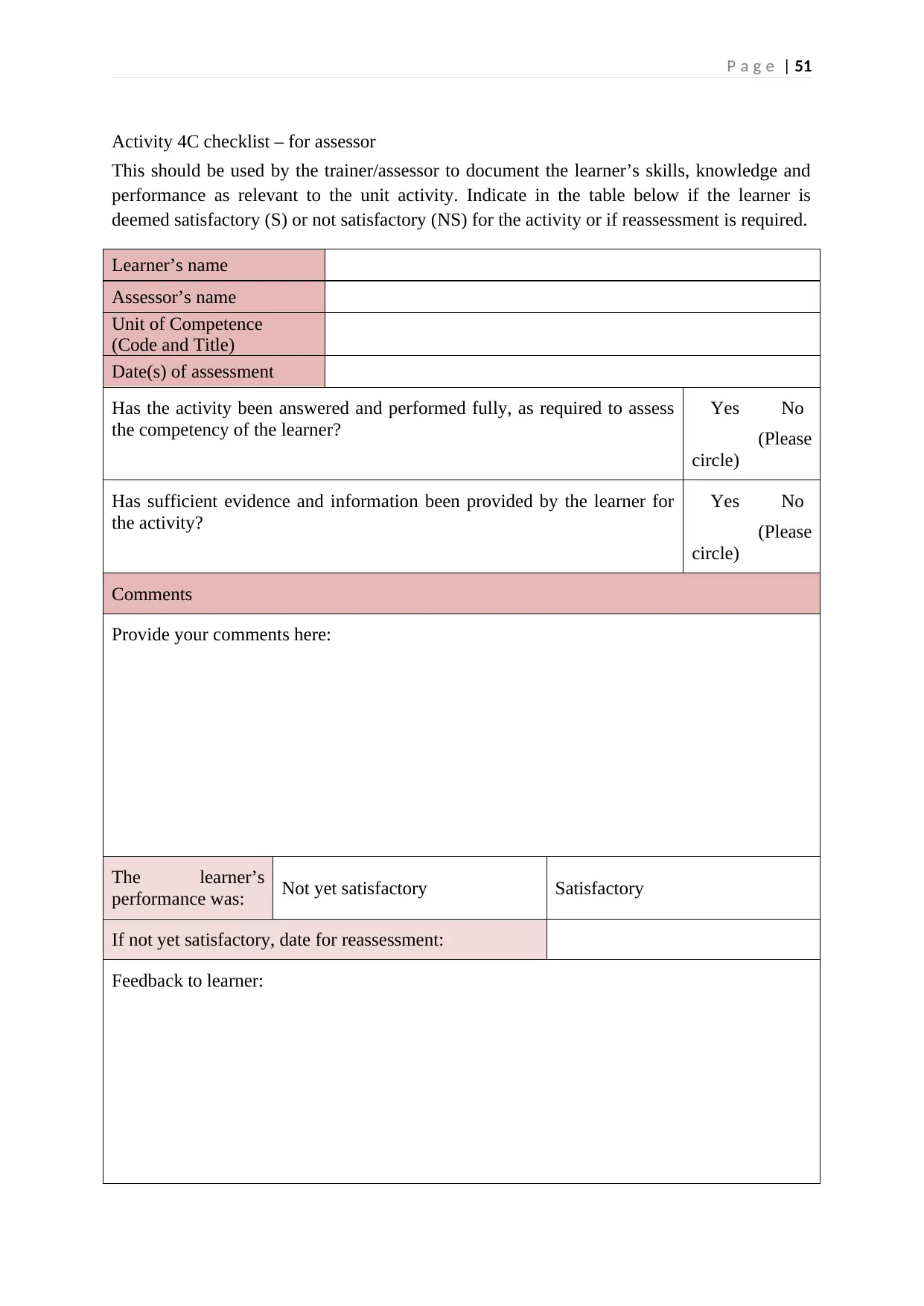
Activity 4C checklist – for assessor
This should be used by the trainer/assessor to document the learner’s skills, knowledge and
performance as relevant to the unit activity. Indicate in the table below if the learner is
deemed satisfactory (S) or not satisfactory (NS) for the activity or if reassessment is required.
Learner’s name
Assessor’s name
Unit of Competence
(Code and Title)
Date(s) of assessment
Has the activity been answered and performed fully, as required to assess
the competency of the learner?
Yes No
(Please
circle)
Has sufficient evidence and information been provided by the learner for
the activity?
Yes No
(Please
circle)
Comments
Provide your comments here:
The learner’s
performance was: Not yet satisfactory Satisfactory
If not yet satisfactory, date for reassessment:
Feedback to learner:
Paraphrase This Document
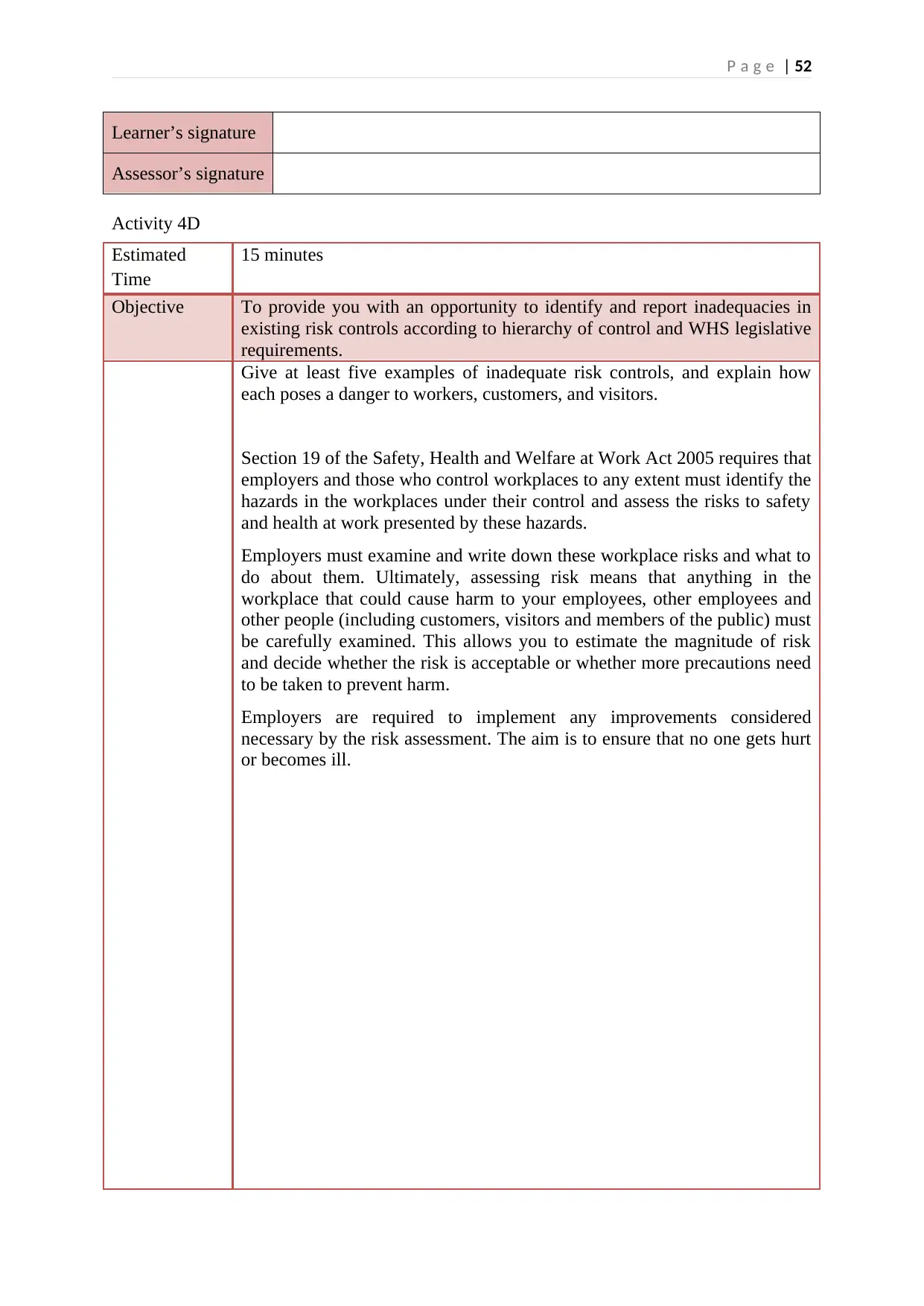
Learner’s signature
Assessor’s signature
Activity 4D
Estimated
Time
15 minutes
Objective To provide you with an opportunity to identify and report inadequacies in
existing risk controls according to hierarchy of control and WHS legislative
requirements.
Give at least five examples of inadequate risk controls, and explain how
each poses a danger to workers, customers, and visitors.
Section 19 of the Safety, Health and Welfare at Work Act 2005 requires that
employers and those who control workplaces to any extent must identify the
hazards in the workplaces under their control and assess the risks to safety
and health at work presented by these hazards.
Employers must examine and write down these workplace risks and what to
do about them. Ultimately, assessing risk means that anything in the
workplace that could cause harm to your employees, other employees and
other people (including customers, visitors and members of the public) must
be carefully examined. This allows you to estimate the magnitude of risk
and decide whether the risk is acceptable or whether more precautions need
to be taken to prevent harm.
Employers are required to implement any improvements considered
necessary by the risk assessment. The aim is to ensure that no one gets hurt
or becomes ill.

⊘ This is a preview!⊘
Do you want full access?
Subscribe today to unlock all pages.

Trusted by 1+ million students worldwide
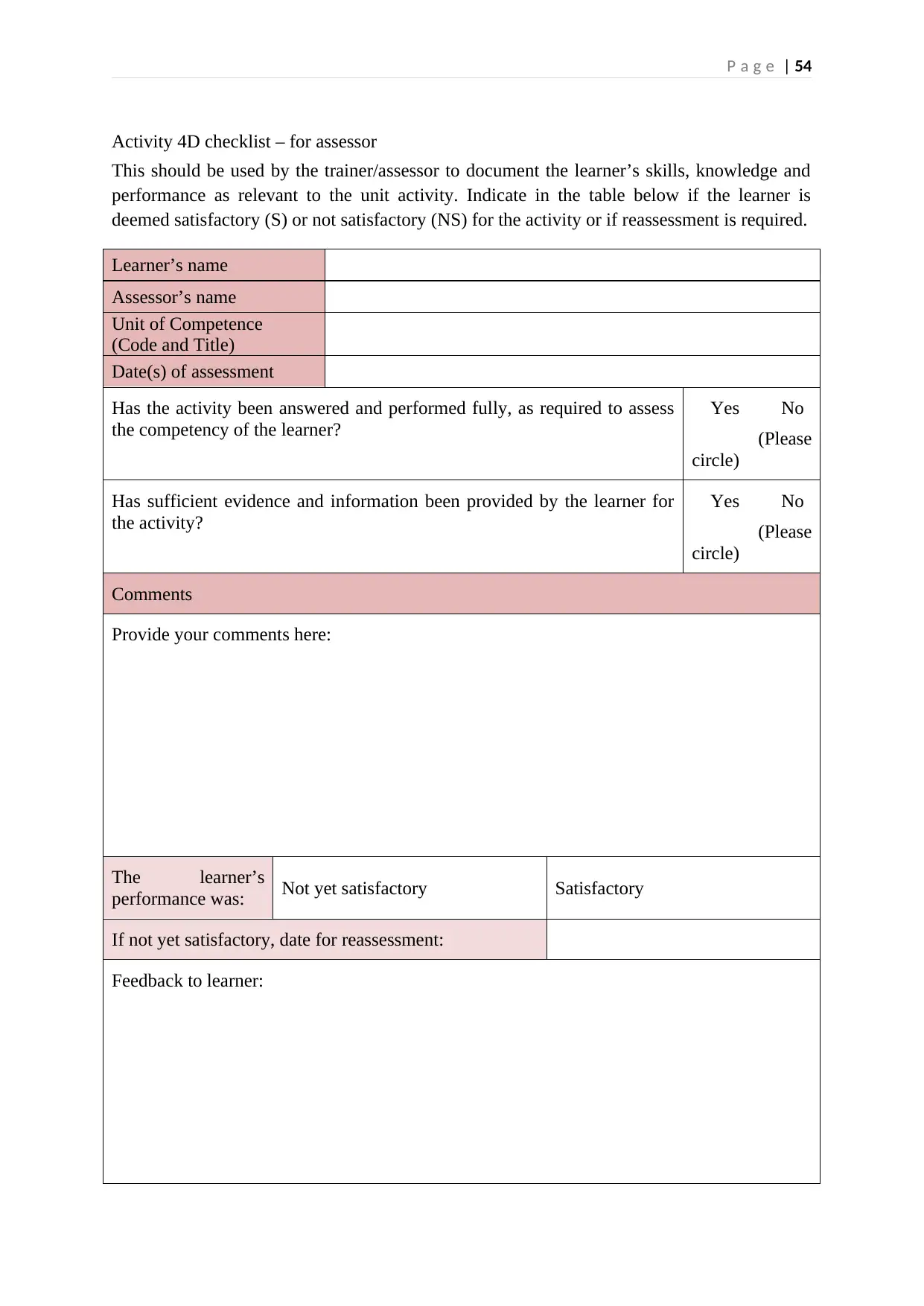
Activity 4D checklist – for assessor
This should be used by the trainer/assessor to document the learner’s skills, knowledge and
performance as relevant to the unit activity. Indicate in the table below if the learner is
deemed satisfactory (S) or not satisfactory (NS) for the activity or if reassessment is required.
Learner’s name
Assessor’s name
Unit of Competence
(Code and Title)
Date(s) of assessment
Has the activity been answered and performed fully, as required to assess
the competency of the learner?
Yes No
(Please
circle)
Has sufficient evidence and information been provided by the learner for
the activity?
Yes No
(Please
circle)
Comments
Provide your comments here:
The learner’s
performance was: Not yet satisfactory Satisfactory
If not yet satisfactory, date for reassessment:
Feedback to learner:
Paraphrase This Document
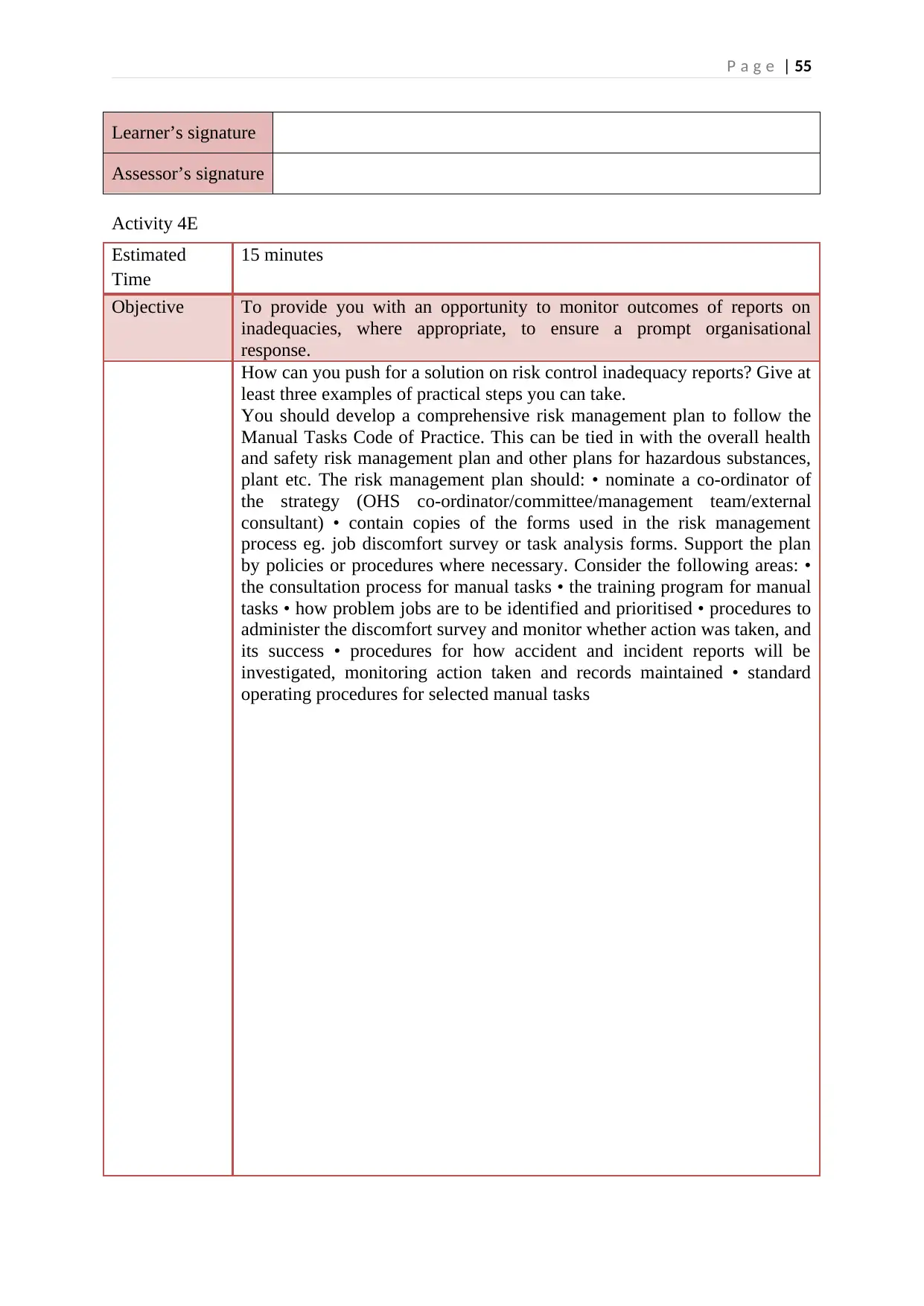
Learner’s signature
Assessor’s signature
Activity 4E
Estimated
Time
15 minutes
Objective To provide you with an opportunity to monitor outcomes of reports on
inadequacies, where appropriate, to ensure a prompt organisational
response.
How can you push for a solution on risk control inadequacy reports? Give at
least three examples of practical steps you can take.
You should develop a comprehensive risk management plan to follow the
Manual Tasks Code of Practice. This can be tied in with the overall health
and safety risk management plan and other plans for hazardous substances,
plant etc. The risk management plan should: • nominate a co-ordinator of
the strategy (OHS co-ordinator/committee/management team/external
consultant) • contain copies of the forms used in the risk management
process eg. job discomfort survey or task analysis forms. Support the plan
by policies or procedures where necessary. Consider the following areas: •
the consultation process for manual tasks • the training program for manual
tasks • how problem jobs are to be identified and prioritised • procedures to
administer the discomfort survey and monitor whether action was taken, and
its success • procedures for how accident and incident reports will be
investigated, monitoring action taken and records maintained • standard
operating procedures for selected manual tasks

⊘ This is a preview!⊘
Do you want full access?
Subscribe today to unlock all pages.

Trusted by 1+ million students worldwide
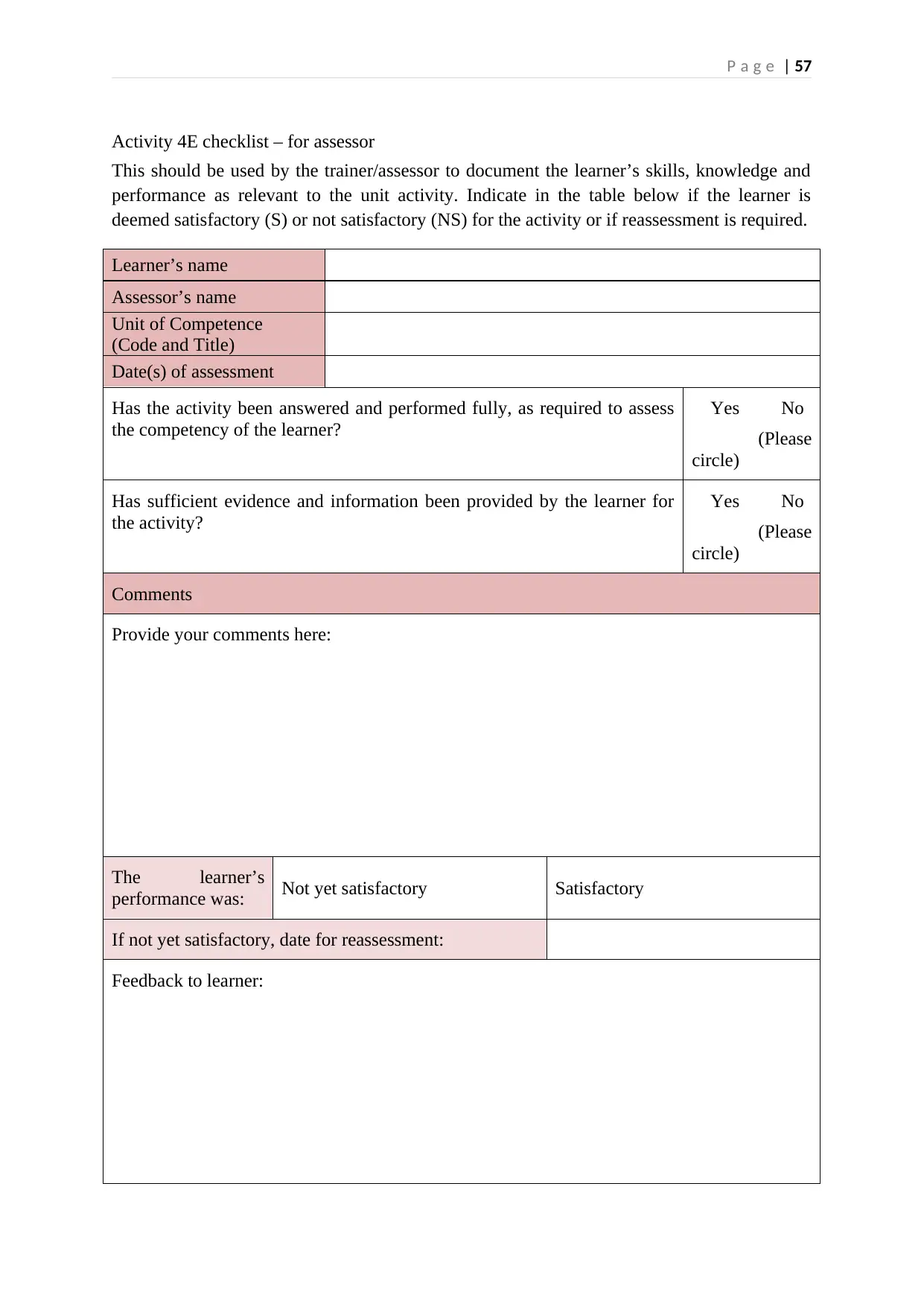
Activity 4E checklist – for assessor
This should be used by the trainer/assessor to document the learner’s skills, knowledge and
performance as relevant to the unit activity. Indicate in the table below if the learner is
deemed satisfactory (S) or not satisfactory (NS) for the activity or if reassessment is required.
Learner’s name
Assessor’s name
Unit of Competence
(Code and Title)
Date(s) of assessment
Has the activity been answered and performed fully, as required to assess
the competency of the learner?
Yes No
(Please
circle)
Has sufficient evidence and information been provided by the learner for
the activity?
Yes No
(Please
circle)
Comments
Provide your comments here:
The learner’s
performance was: Not yet satisfactory Satisfactory
If not yet satisfactory, date for reassessment:
Feedback to learner:
Paraphrase This Document
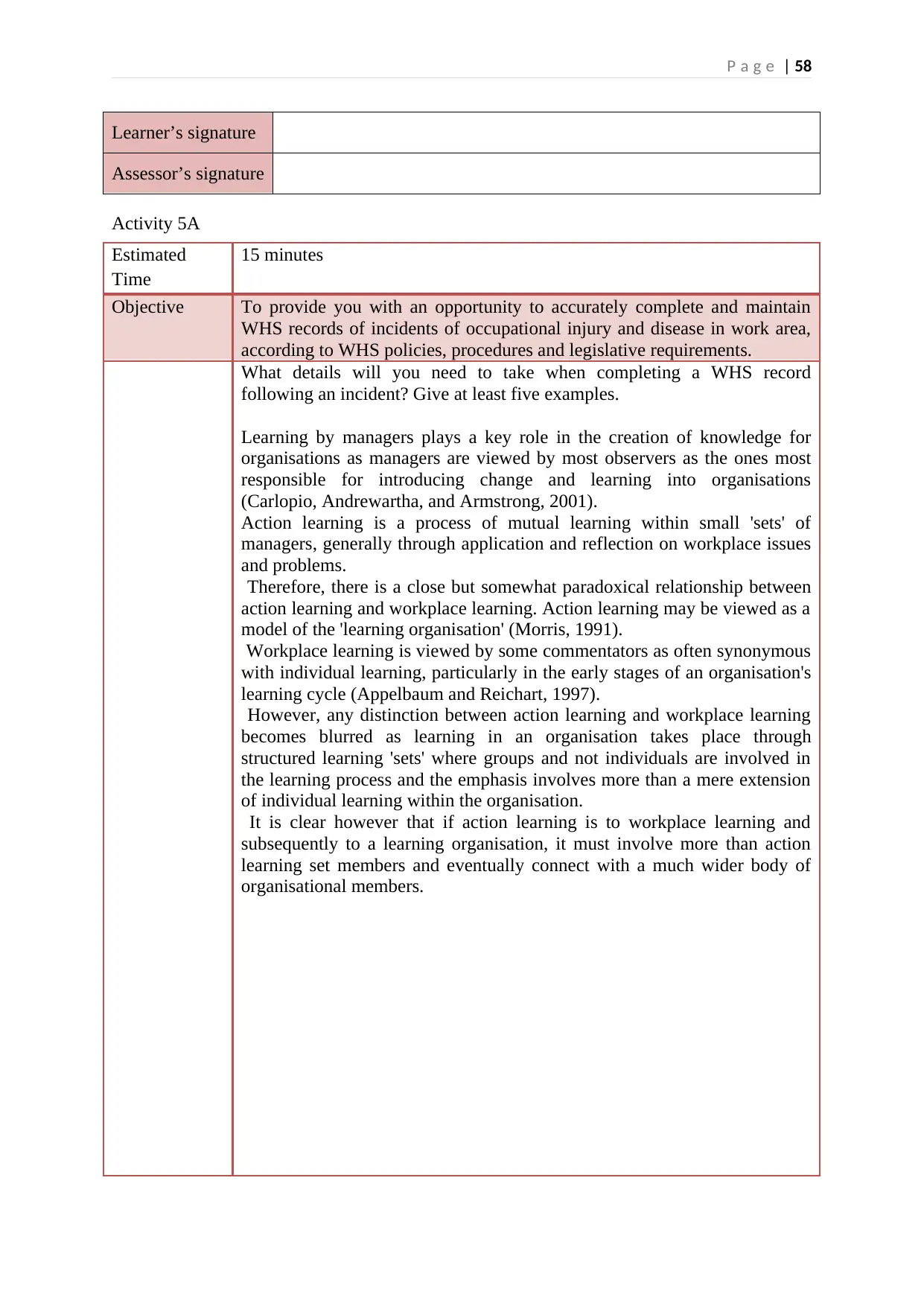
Learner’s signature
Assessor’s signature
Activity 5A
Estimated
Time
15 minutes
Objective To provide you with an opportunity to accurately complete and maintain
WHS records of incidents of occupational injury and disease in work area,
according to WHS policies, procedures and legislative requirements.
What details will you need to take when completing a WHS record
following an incident? Give at least five examples.
Learning by managers plays a key role in the creation of knowledge for
organisations as managers are viewed by most observers as the ones most
responsible for introducing change and learning into organisations
(Carlopio, Andrewartha, and Armstrong, 2001).
Action learning is a process of mutual learning within small 'sets' of
managers, generally through application and reflection on workplace issues
and problems.
Therefore, there is a close but somewhat paradoxical relationship between
action learning and workplace learning. Action learning may be viewed as a
model of the 'learning organisation' (Morris, 1991).
Workplace learning is viewed by some commentators as often synonymous
with individual learning, particularly in the early stages of an organisation's
learning cycle (Appelbaum and Reichart, 1997).
However, any distinction between action learning and workplace learning
becomes blurred as learning in an organisation takes place through
structured learning 'sets' where groups and not individuals are involved in
the learning process and the emphasis involves more than a mere extension
of individual learning within the organisation.
It is clear however that if action learning is to workplace learning and
subsequently to a learning organisation, it must involve more than action
learning set members and eventually connect with a much wider body of
organisational members.

⊘ This is a preview!⊘
Do you want full access?
Subscribe today to unlock all pages.

Trusted by 1+ million students worldwide
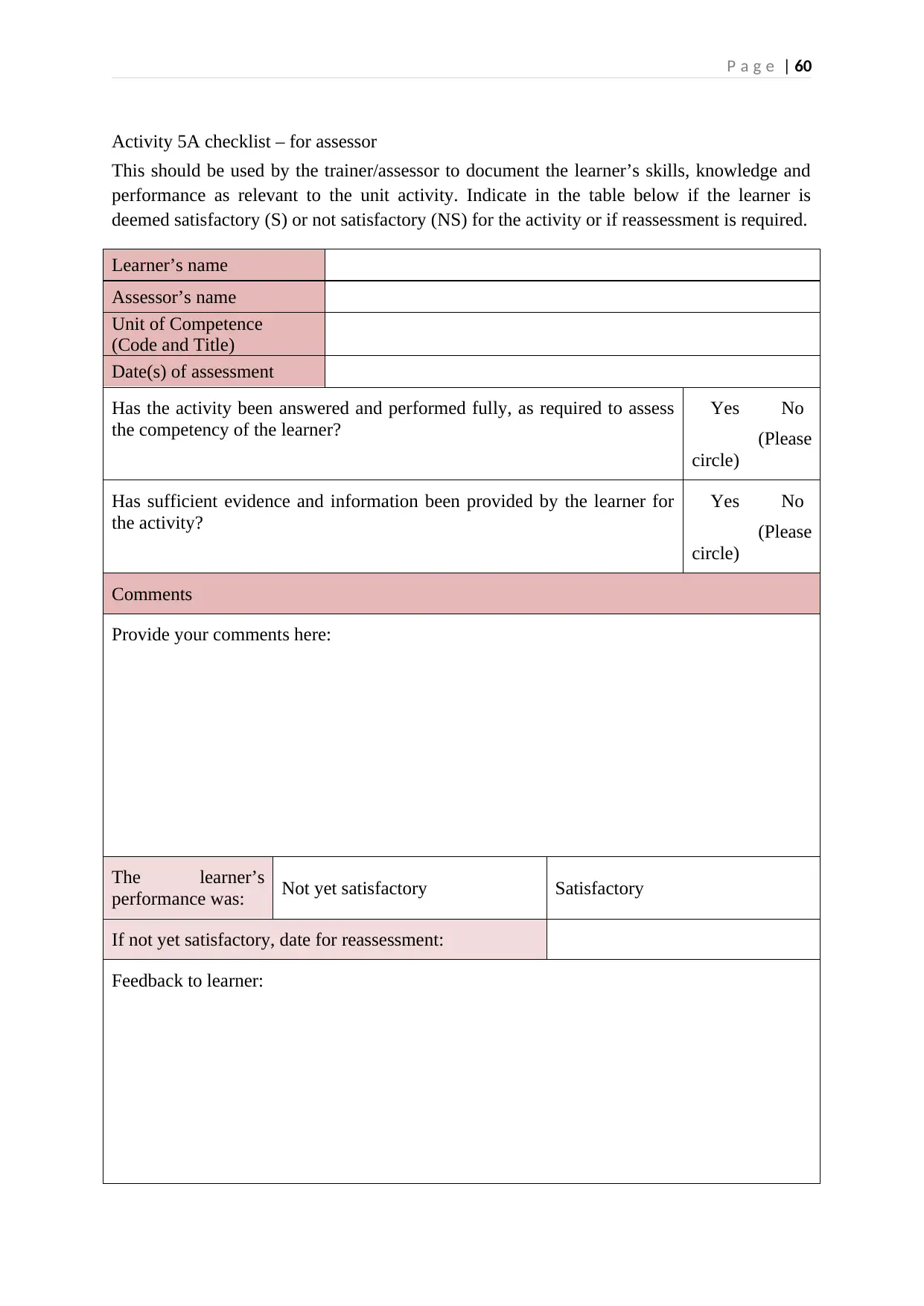
Activity 5A checklist – for assessor
This should be used by the trainer/assessor to document the learner’s skills, knowledge and
performance as relevant to the unit activity. Indicate in the table below if the learner is
deemed satisfactory (S) or not satisfactory (NS) for the activity or if reassessment is required.
Learner’s name
Assessor’s name
Unit of Competence
(Code and Title)
Date(s) of assessment
Has the activity been answered and performed fully, as required to assess
the competency of the learner?
Yes No
(Please
circle)
Has sufficient evidence and information been provided by the learner for
the activity?
Yes No
(Please
circle)
Comments
Provide your comments here:
The learner’s
performance was: Not yet satisfactory Satisfactory
If not yet satisfactory, date for reassessment:
Feedback to learner:
Paraphrase This Document
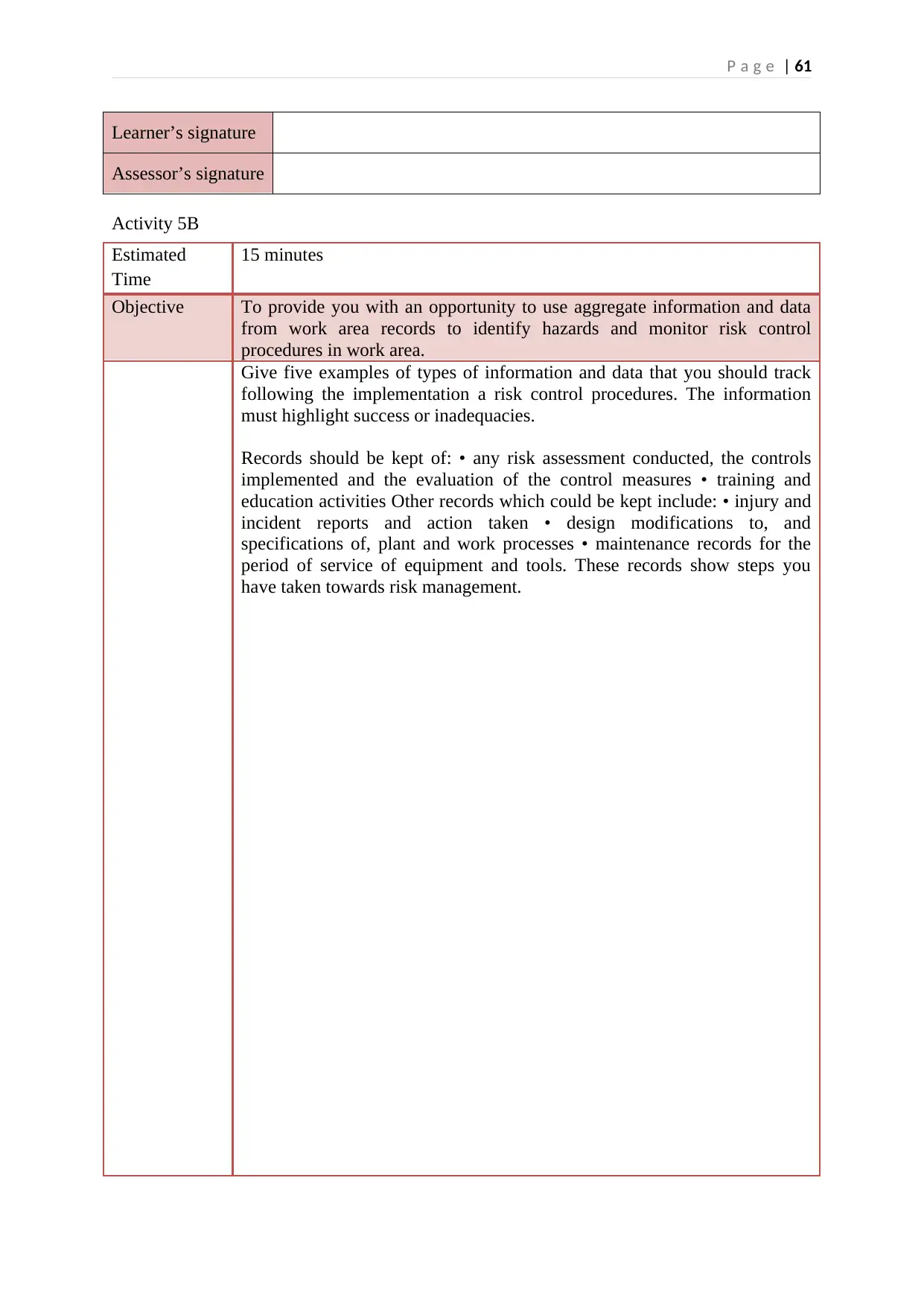
Learner’s signature
Assessor’s signature
Activity 5B
Estimated
Time
15 minutes
Objective To provide you with an opportunity to use aggregate information and data
from work area records to identify hazards and monitor risk control
procedures in work area.
Give five examples of types of information and data that you should track
following the implementation a risk control procedures. The information
must highlight success or inadequacies.
Records should be kept of: • any risk assessment conducted, the controls
implemented and the evaluation of the control measures • training and
education activities Other records which could be kept include: • injury and
incident reports and action taken • design modifications to, and
specifications of, plant and work processes • maintenance records for the
period of service of equipment and tools. These records show steps you
have taken towards risk management.

⊘ This is a preview!⊘
Do you want full access?
Subscribe today to unlock all pages.

Trusted by 1+ million students worldwide
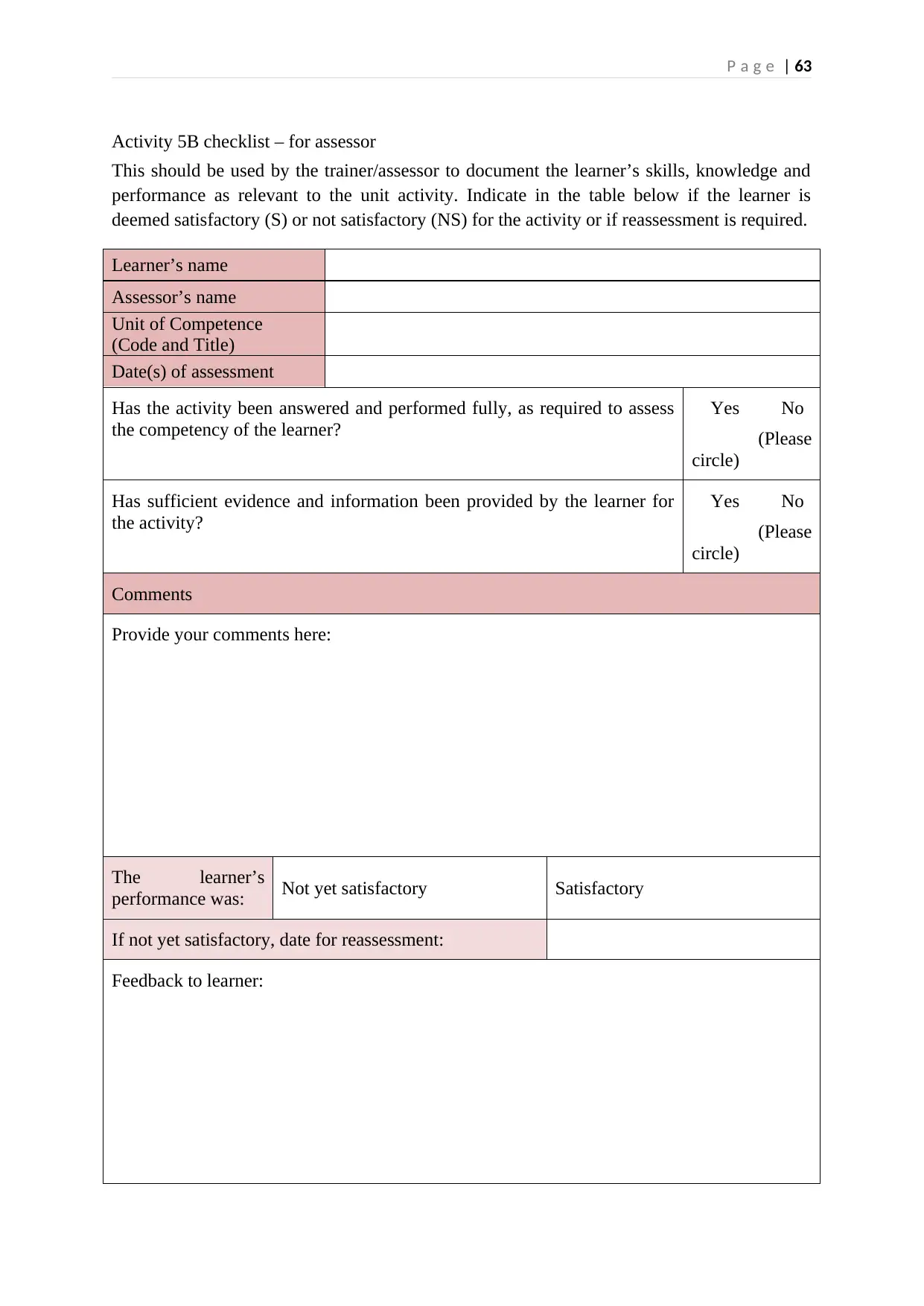
Activity 5B checklist – for assessor
This should be used by the trainer/assessor to document the learner’s skills, knowledge and
performance as relevant to the unit activity. Indicate in the table below if the learner is
deemed satisfactory (S) or not satisfactory (NS) for the activity or if reassessment is required.
Learner’s name
Assessor’s name
Unit of Competence
(Code and Title)
Date(s) of assessment
Has the activity been answered and performed fully, as required to assess
the competency of the learner?
Yes No
(Please
circle)
Has sufficient evidence and information been provided by the learner for
the activity?
Yes No
(Please
circle)
Comments
Provide your comments here:
The learner’s
performance was: Not yet satisfactory Satisfactory
If not yet satisfactory, date for reassessment:
Feedback to learner:
Paraphrase This Document
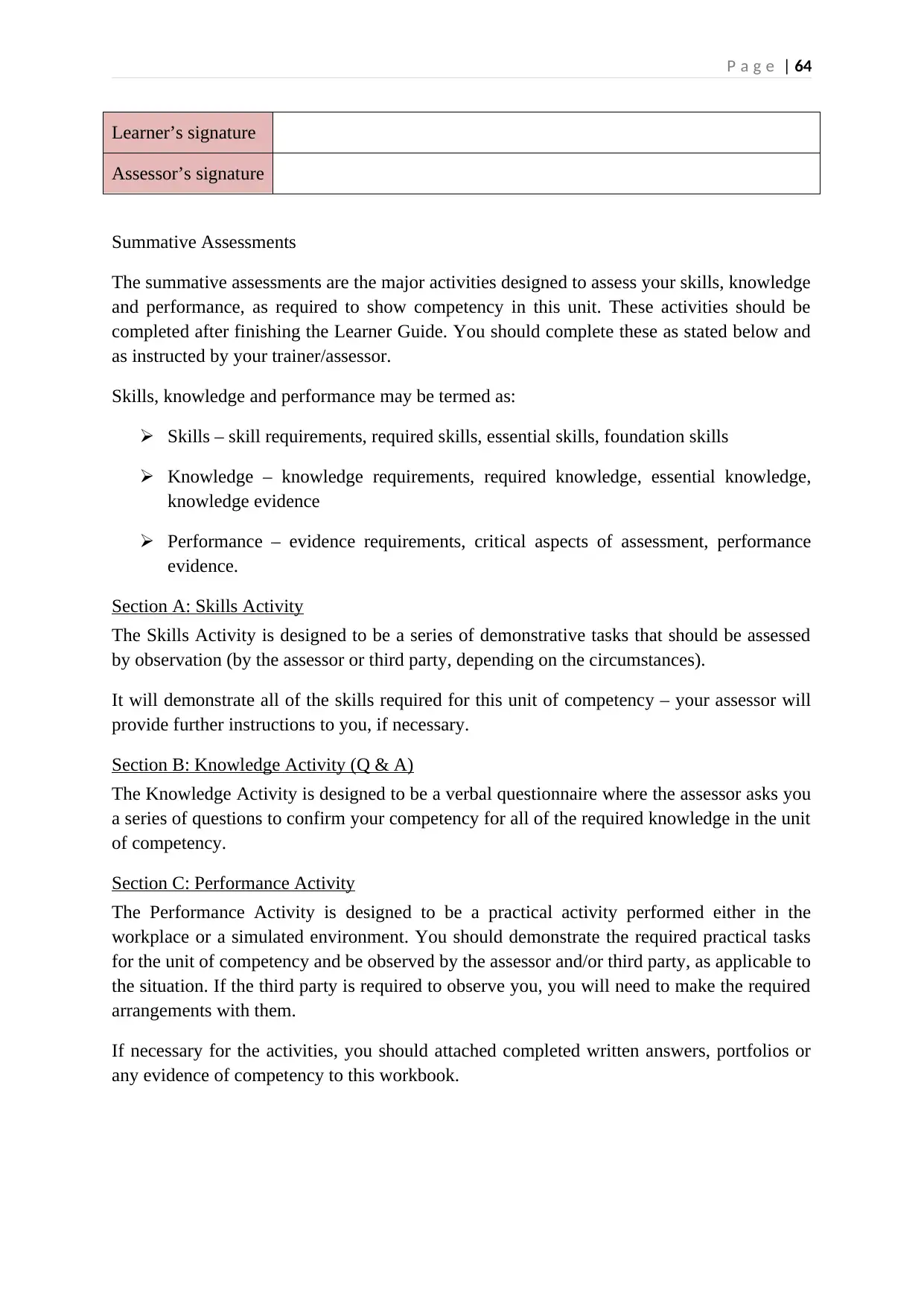
Learner’s signature
Assessor’s signature
Summative Assessments
The summative assessments are the major activities designed to assess your skills, knowledge
and performance, as required to show competency in this unit. These activities should be
completed after finishing the Learner Guide. You should complete these as stated below and
as instructed by your trainer/assessor.
Skills, knowledge and performance may be termed as:
Skills – skill requirements, required skills, essential skills, foundation skills
Knowledge – knowledge requirements, required knowledge, essential knowledge,
knowledge evidence
Performance – evidence requirements, critical aspects of assessment, performance
evidence.
Section A: Skills Activity
The Skills Activity is designed to be a series of demonstrative tasks that should be assessed
by observation (by the assessor or third party, depending on the circumstances).
It will demonstrate all of the skills required for this unit of competency – your assessor will
provide further instructions to you, if necessary.
Section B: Knowledge Activity (Q & A)
The Knowledge Activity is designed to be a verbal questionnaire where the assessor asks you
a series of questions to confirm your competency for all of the required knowledge in the unit
of competency.
Section C: Performance Activity
The Performance Activity is designed to be a practical activity performed either in the
workplace or a simulated environment. You should demonstrate the required practical tasks
for the unit of competency and be observed by the assessor and/or third party, as applicable to
the situation. If the third party is required to observe you, you will need to make the required
arrangements with them.
If necessary for the activities, you should attached completed written answers, portfolios or
any evidence of competency to this workbook.
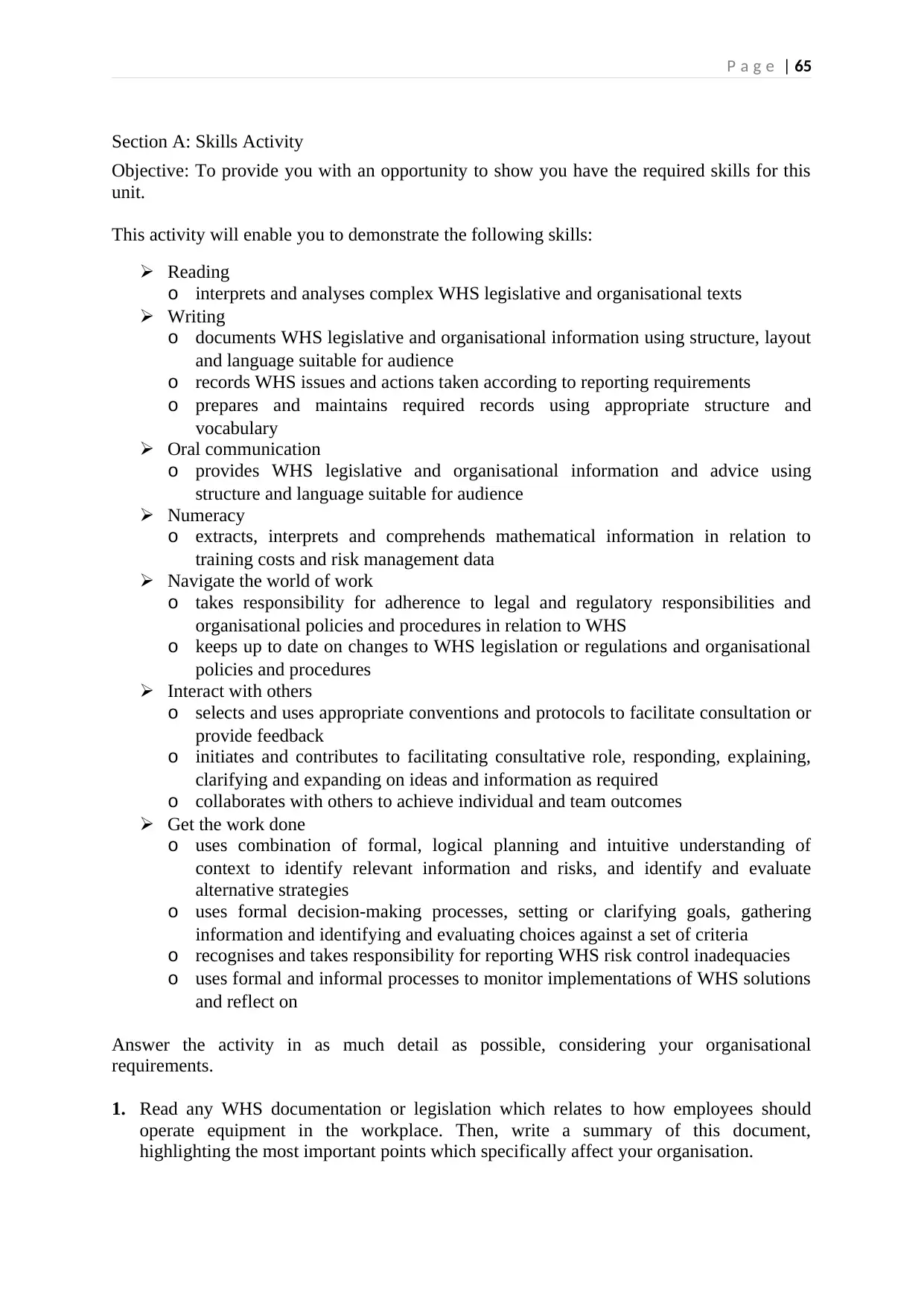
Section A: Skills Activity
Objective: To provide you with an opportunity to show you have the required skills for this
unit.
This activity will enable you to demonstrate the following skills:
Reading
o interprets and analyses complex WHS legislative and organisational texts
Writing
o documents WHS legislative and organisational information using structure, layout
and language suitable for audience
o records WHS issues and actions taken according to reporting requirements
o prepares and maintains required records using appropriate structure and
vocabulary
Oral communication
o provides WHS legislative and organisational information and advice using
structure and language suitable for audience
Numeracy
o extracts, interprets and comprehends mathematical information in relation to
training costs and risk management data
Navigate the world of work
o takes responsibility for adherence to legal and regulatory responsibilities and
organisational policies and procedures in relation to WHS
o keeps up to date on changes to WHS legislation or regulations and organisational
policies and procedures
Interact with others
o selects and uses appropriate conventions and protocols to facilitate consultation or
provide feedback
o initiates and contributes to facilitating consultative role, responding, explaining,
clarifying and expanding on ideas and information as required
o collaborates with others to achieve individual and team outcomes
Get the work done
o uses combination of formal, logical planning and intuitive understanding of
context to identify relevant information and risks, and identify and evaluate
alternative strategies
o uses formal decision-making processes, setting or clarifying goals, gathering
information and identifying and evaluating choices against a set of criteria
o recognises and takes responsibility for reporting WHS risk control inadequacies
o uses formal and informal processes to monitor implementations of WHS solutions
and reflect on
Answer the activity in as much detail as possible, considering your organisational
requirements.
1. Read any WHS documentation or legislation which relates to how employees should
operate equipment in the workplace. Then, write a summary of this document,
highlighting the most important points which specifically affect your organisation.
⊘ This is a preview!⊘
Do you want full access?
Subscribe today to unlock all pages.

Trusted by 1+ million students worldwide
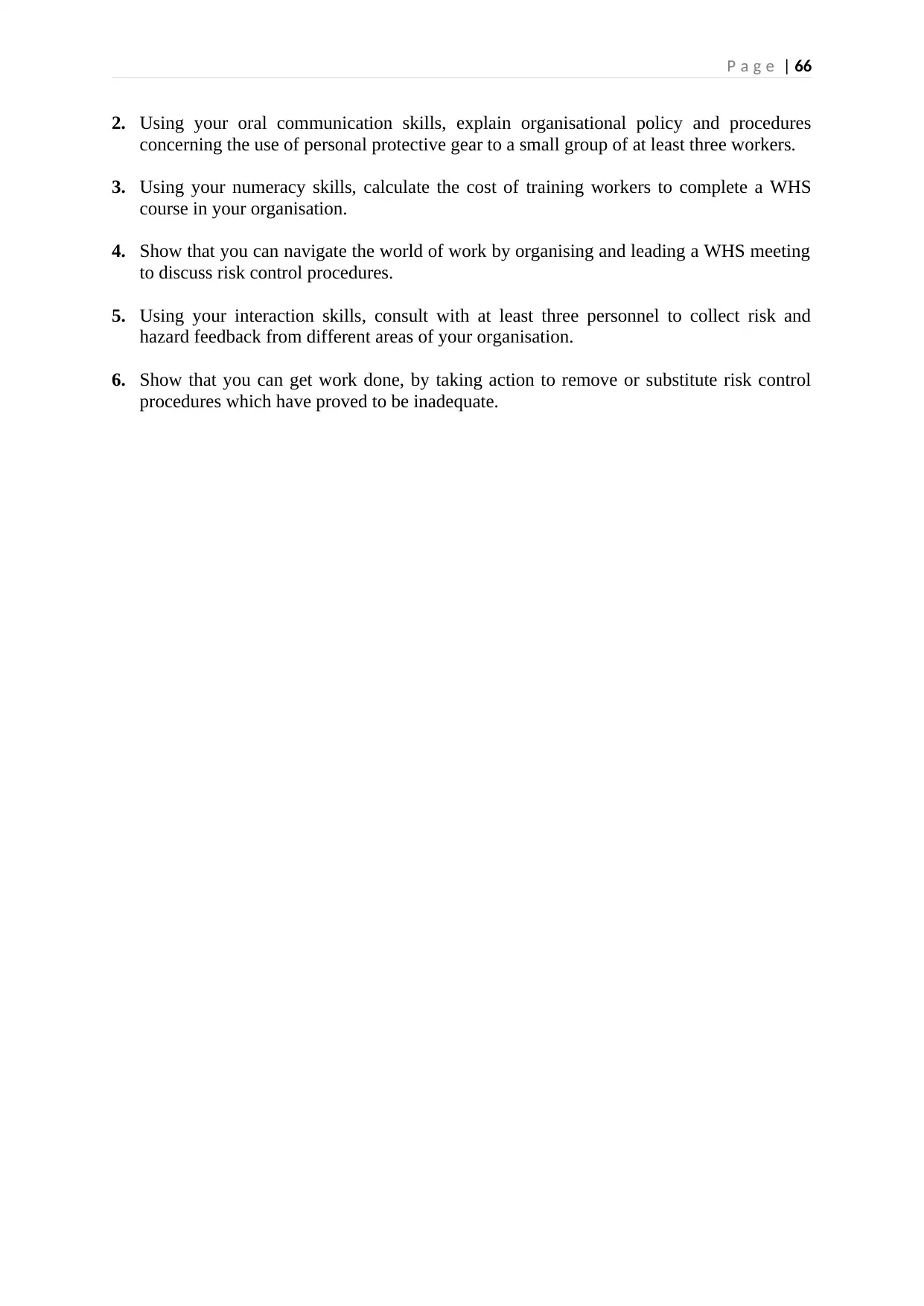
2. Using your oral communication skills, explain organisational policy and procedures
concerning the use of personal protective gear to a small group of at least three workers.
3. Using your numeracy skills, calculate the cost of training workers to complete a WHS
course in your organisation.
4. Show that you can navigate the world of work by organising and leading a WHS meeting
to discuss risk control procedures.
5. Using your interaction skills, consult with at least three personnel to collect risk and
hazard feedback from different areas of your organisation.
6. Show that you can get work done, by taking action to remove or substitute risk control
procedures which have proved to be inadequate.
Paraphrase This Document
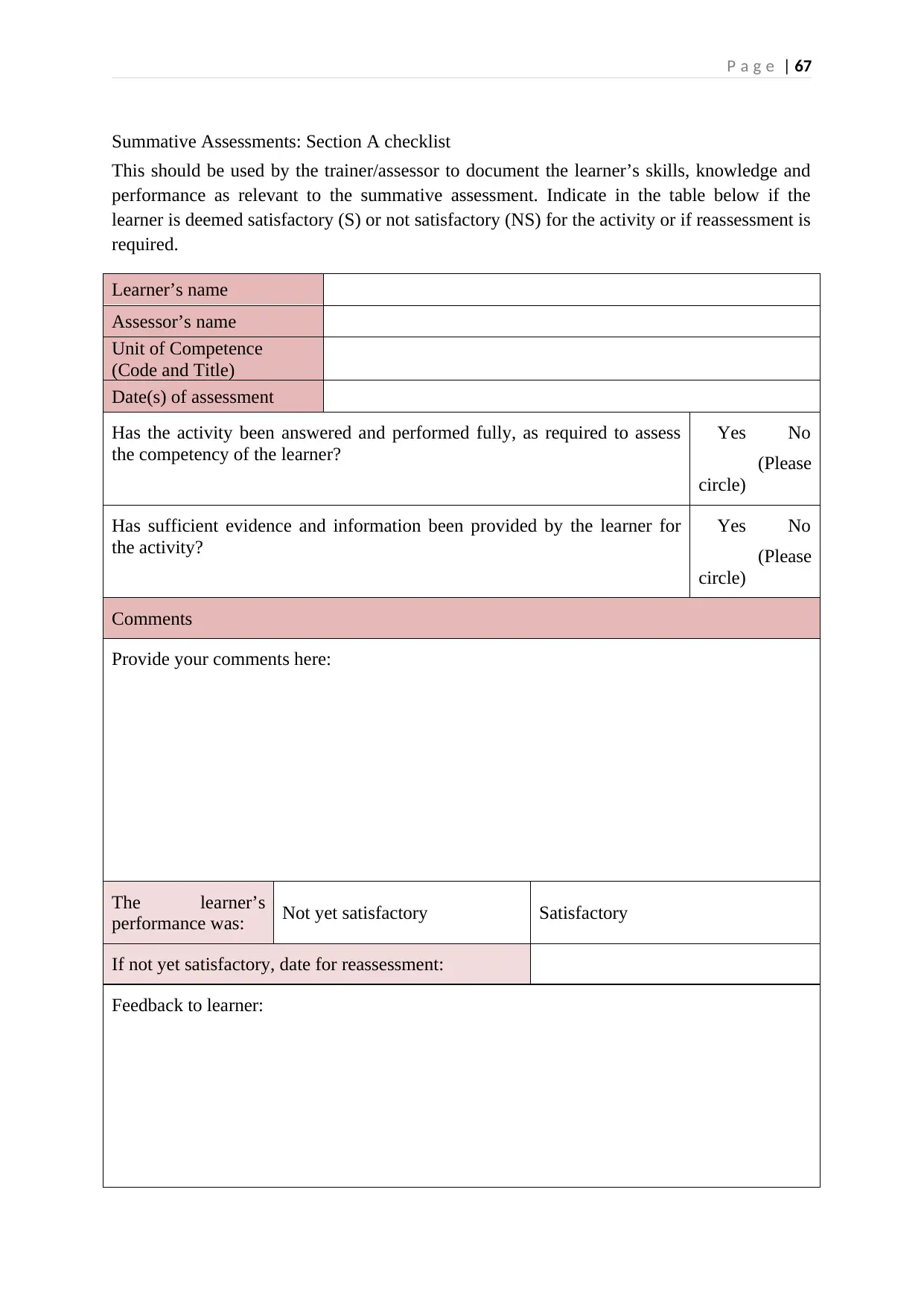
Summative Assessments: Section A checklist
This should be used by the trainer/assessor to document the learner’s skills, knowledge and
performance as relevant to the summative assessment. Indicate in the table below if the
learner is deemed satisfactory (S) or not satisfactory (NS) for the activity or if reassessment is
required.
Learner’s name
Assessor’s name
Unit of Competence
(Code and Title)
Date(s) of assessment
Has the activity been answered and performed fully, as required to assess
the competency of the learner?
Yes No
(Please
circle)
Has sufficient evidence and information been provided by the learner for
the activity?
Yes No
(Please
circle)
Comments
Provide your comments here:
The learner’s
performance was: Not yet satisfactory Satisfactory
If not yet satisfactory, date for reassessment:
Feedback to learner:
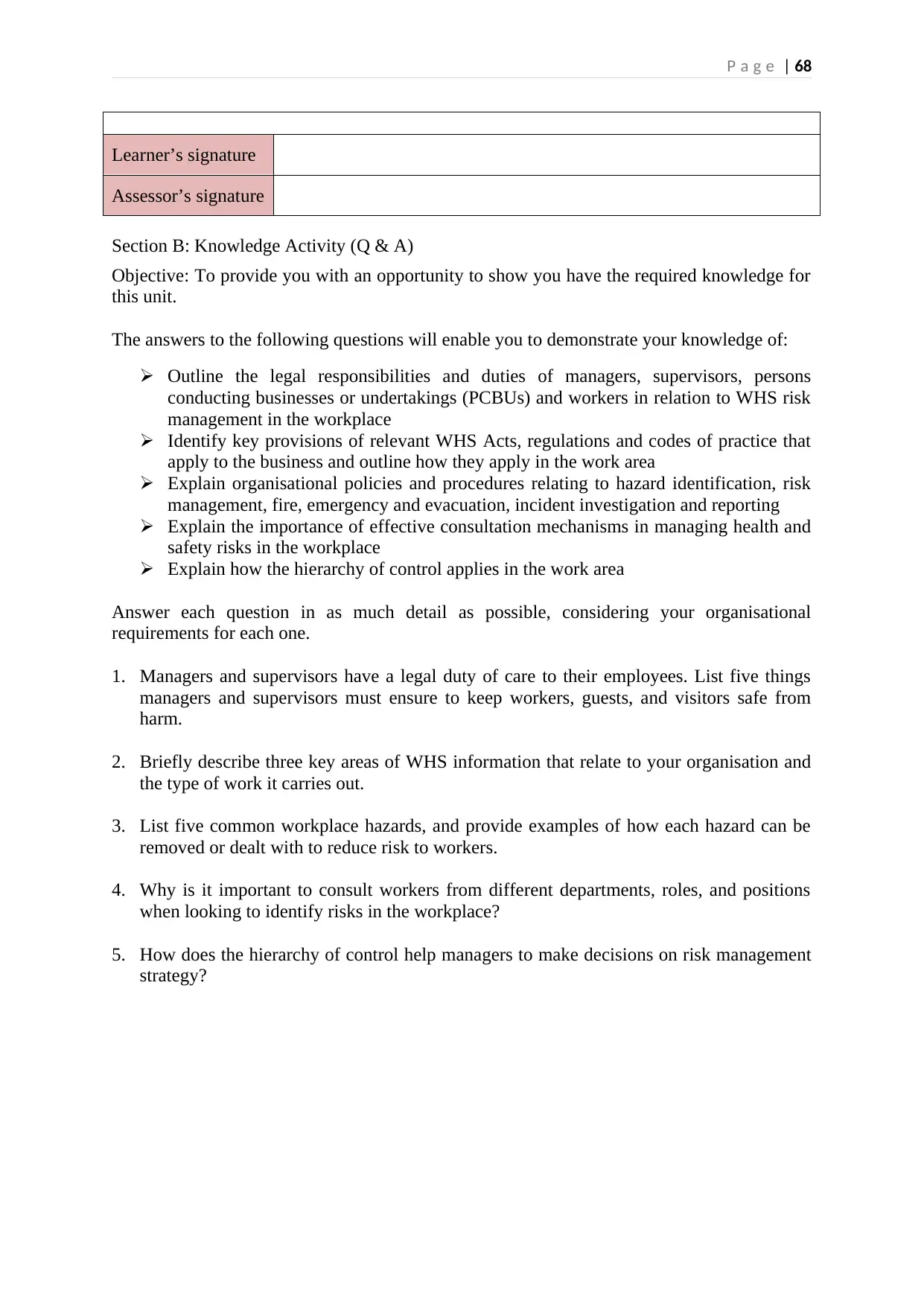
Learner’s signature
Assessor’s signature
Section B: Knowledge Activity (Q & A)
Objective: To provide you with an opportunity to show you have the required knowledge for
this unit.
The answers to the following questions will enable you to demonstrate your knowledge of:
Outline the legal responsibilities and duties of managers, supervisors, persons
conducting businesses or undertakings (PCBUs) and workers in relation to WHS risk
management in the workplace
Identify key provisions of relevant WHS Acts, regulations and codes of practice that
apply to the business and outline how they apply in the work area
Explain organisational policies and procedures relating to hazard identification, risk
management, fire, emergency and evacuation, incident investigation and reporting
Explain the importance of effective consultation mechanisms in managing health and
safety risks in the workplace
Explain how the hierarchy of control applies in the work area
Answer each question in as much detail as possible, considering your organisational
requirements for each one.
1. Managers and supervisors have a legal duty of care to their employees. List five things
managers and supervisors must ensure to keep workers, guests, and visitors safe from
harm.
2. Briefly describe three key areas of WHS information that relate to your organisation and
the type of work it carries out.
3. List five common workplace hazards, and provide examples of how each hazard can be
removed or dealt with to reduce risk to workers.
4. Why is it important to consult workers from different departments, roles, and positions
when looking to identify risks in the workplace?
5. How does the hierarchy of control help managers to make decisions on risk management
strategy?
⊘ This is a preview!⊘
Do you want full access?
Subscribe today to unlock all pages.

Trusted by 1+ million students worldwide
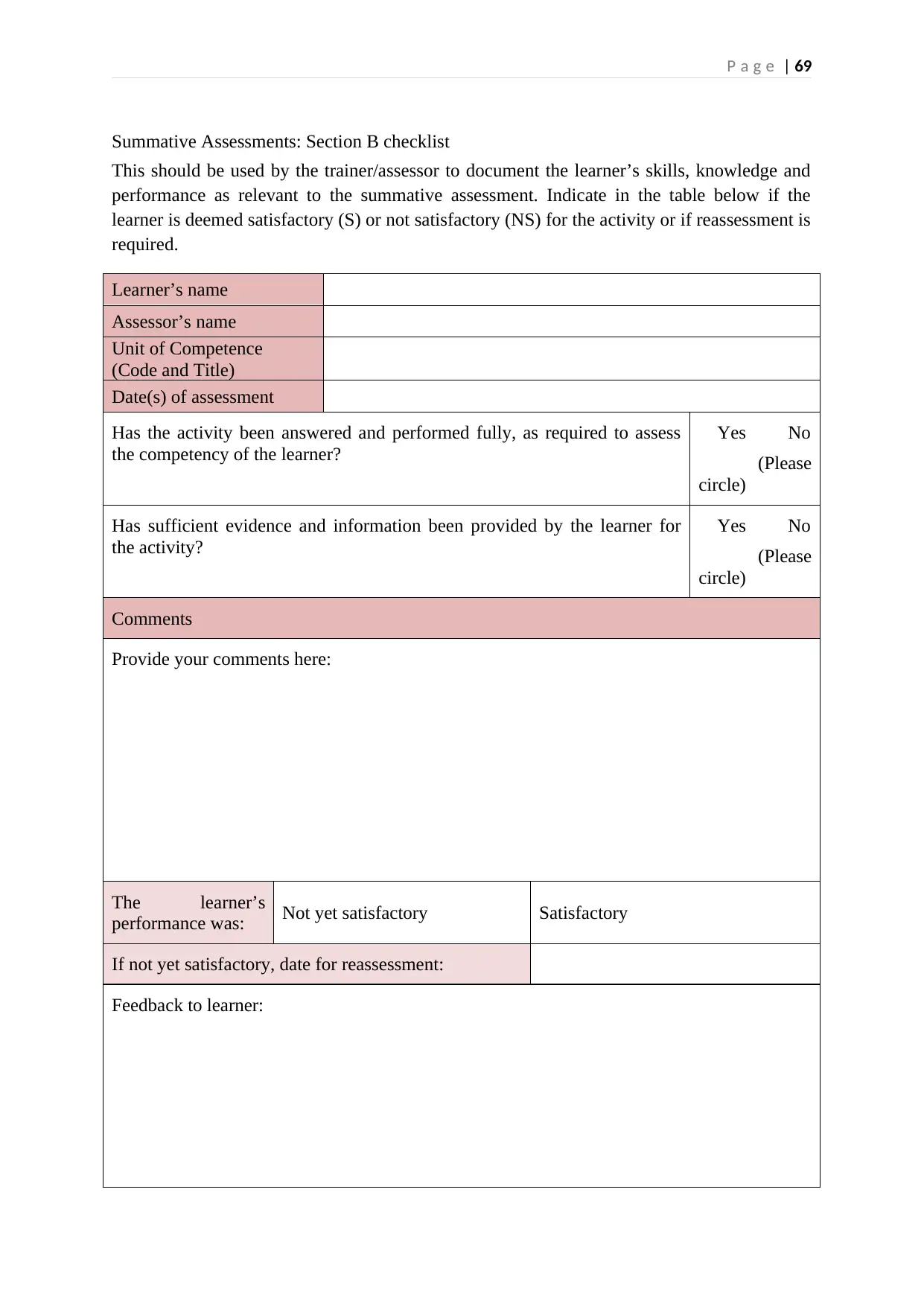
Summative Assessments: Section B checklist
This should be used by the trainer/assessor to document the learner’s skills, knowledge and
performance as relevant to the summative assessment. Indicate in the table below if the
learner is deemed satisfactory (S) or not satisfactory (NS) for the activity or if reassessment is
required.
Learner’s name
Assessor’s name
Unit of Competence
(Code and Title)
Date(s) of assessment
Has the activity been answered and performed fully, as required to assess
the competency of the learner?
Yes No
(Please
circle)
Has sufficient evidence and information been provided by the learner for
the activity?
Yes No
(Please
circle)
Comments
Provide your comments here:
The learner’s
performance was: Not yet satisfactory Satisfactory
If not yet satisfactory, date for reassessment:
Feedback to learner:
Paraphrase This Document
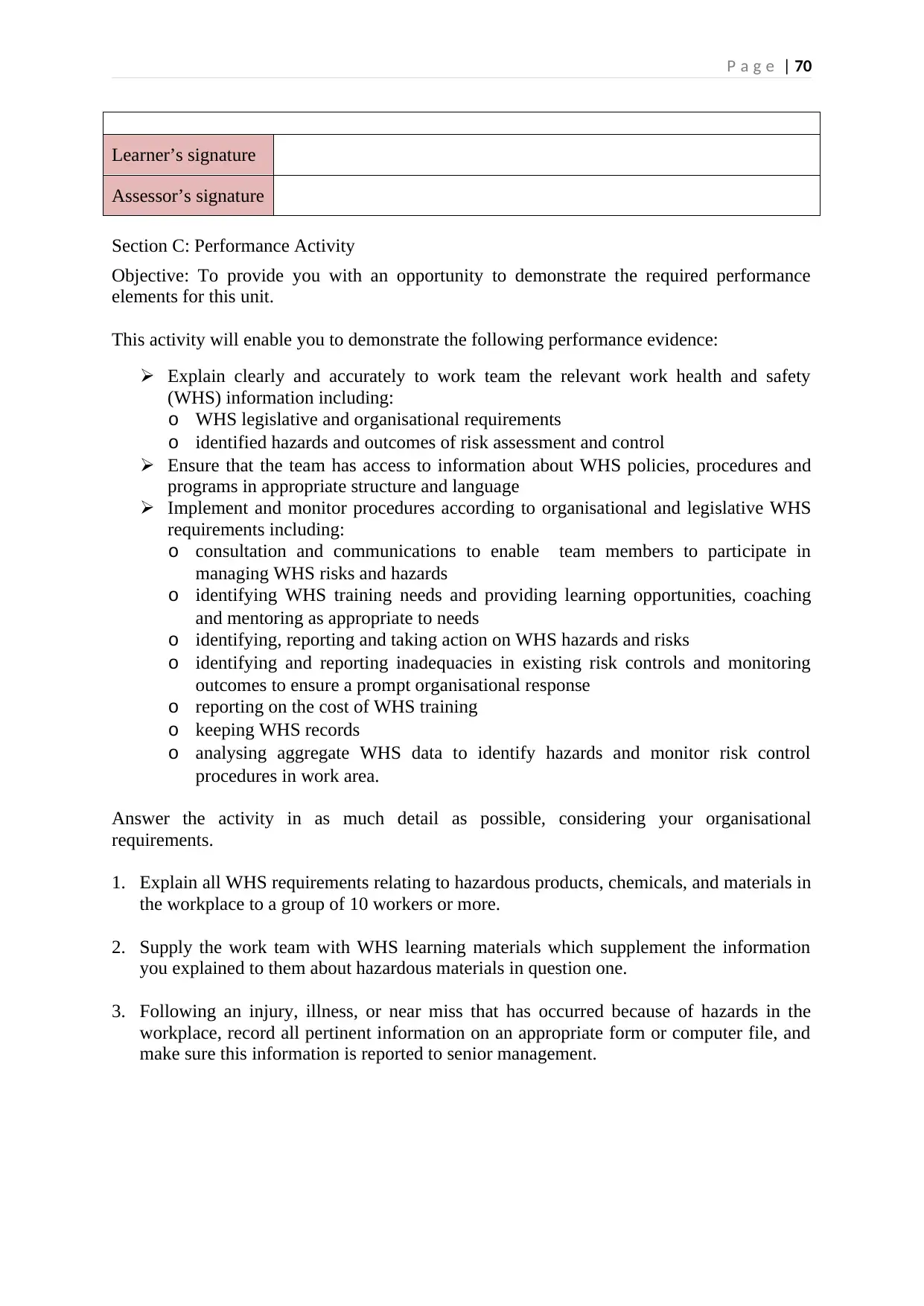
Learner’s signature
Assessor’s signature
Section C: Performance Activity
Objective: To provide you with an opportunity to demonstrate the required performance
elements for this unit.
This activity will enable you to demonstrate the following performance evidence:
Explain clearly and accurately to work team the relevant work health and safety
(WHS) information including:
o WHS legislative and organisational requirements
o identified hazards and outcomes of risk assessment and control
Ensure that the team has access to information about WHS policies, procedures and
programs in appropriate structure and language
Implement and monitor procedures according to organisational and legislative WHS
requirements including:
o consultation and communications to enable team members to participate in
managing WHS risks and hazards
o identifying WHS training needs and providing learning opportunities, coaching
and mentoring as appropriate to needs
o identifying, reporting and taking action on WHS hazards and risks
o identifying and reporting inadequacies in existing risk controls and monitoring
outcomes to ensure a prompt organisational response
o reporting on the cost of WHS training
o keeping WHS records
o analysing aggregate WHS data to identify hazards and monitor risk control
procedures in work area.
Answer the activity in as much detail as possible, considering your organisational
requirements.
1. Explain all WHS requirements relating to hazardous products, chemicals, and materials in
the workplace to a group of 10 workers or more.
2. Supply the work team with WHS learning materials which supplement the information
you explained to them about hazardous materials in question one.
3. Following an injury, illness, or near miss that has occurred because of hazards in the
workplace, record all pertinent information on an appropriate form or computer file, and
make sure this information is reported to senior management.
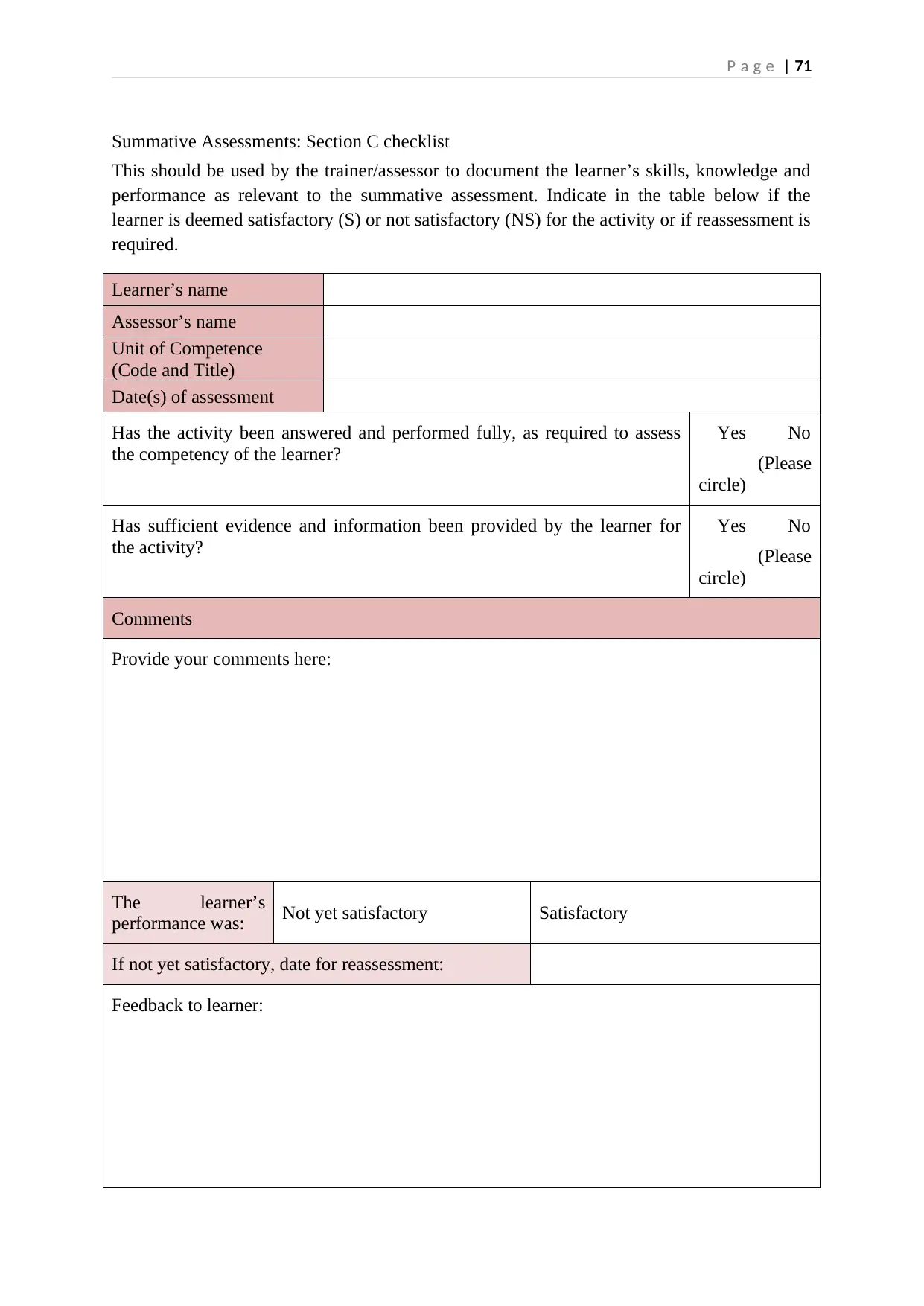
Summative Assessments: Section C checklist
This should be used by the trainer/assessor to document the learner’s skills, knowledge and
performance as relevant to the summative assessment. Indicate in the table below if the
learner is deemed satisfactory (S) or not satisfactory (NS) for the activity or if reassessment is
required.
Learner’s name
Assessor’s name
Unit of Competence
(Code and Title)
Date(s) of assessment
Has the activity been answered and performed fully, as required to assess
the competency of the learner?
Yes No
(Please
circle)
Has sufficient evidence and information been provided by the learner for
the activity?
Yes No
(Please
circle)
Comments
Provide your comments here:
The learner’s
performance was: Not yet satisfactory Satisfactory
If not yet satisfactory, date for reassessment:
Feedback to learner:
⊘ This is a preview!⊘
Do you want full access?
Subscribe today to unlock all pages.

Trusted by 1+ million students worldwide
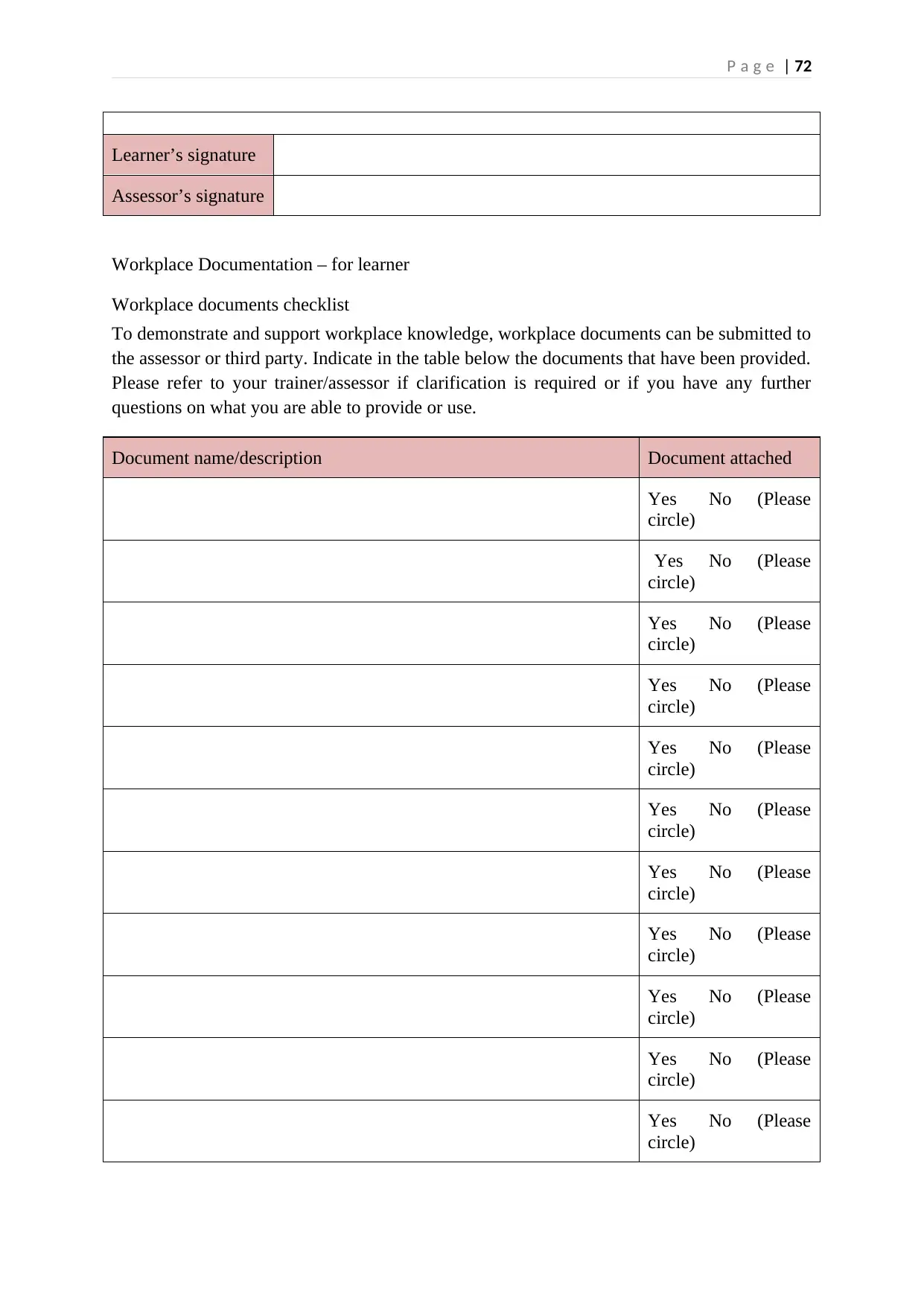
Learner’s signature
Assessor’s signature
Workplace Documentation – for learner
Workplace documents checklist
To demonstrate and support workplace knowledge, workplace documents can be submitted to
the assessor or third party. Indicate in the table below the documents that have been provided.
Please refer to your trainer/assessor if clarification is required or if you have any further
questions on what you are able to provide or use.
Document name/description Document attached
Yes No (Please
circle)
Yes No (Please
circle)
Yes No (Please
circle)
Yes No (Please
circle)
Yes No (Please
circle)
Yes No (Please
circle)
Yes No (Please
circle)
Yes No (Please
circle)
Yes No (Please
circle)
Yes No (Please
circle)
Yes No (Please
circle)
Paraphrase This Document
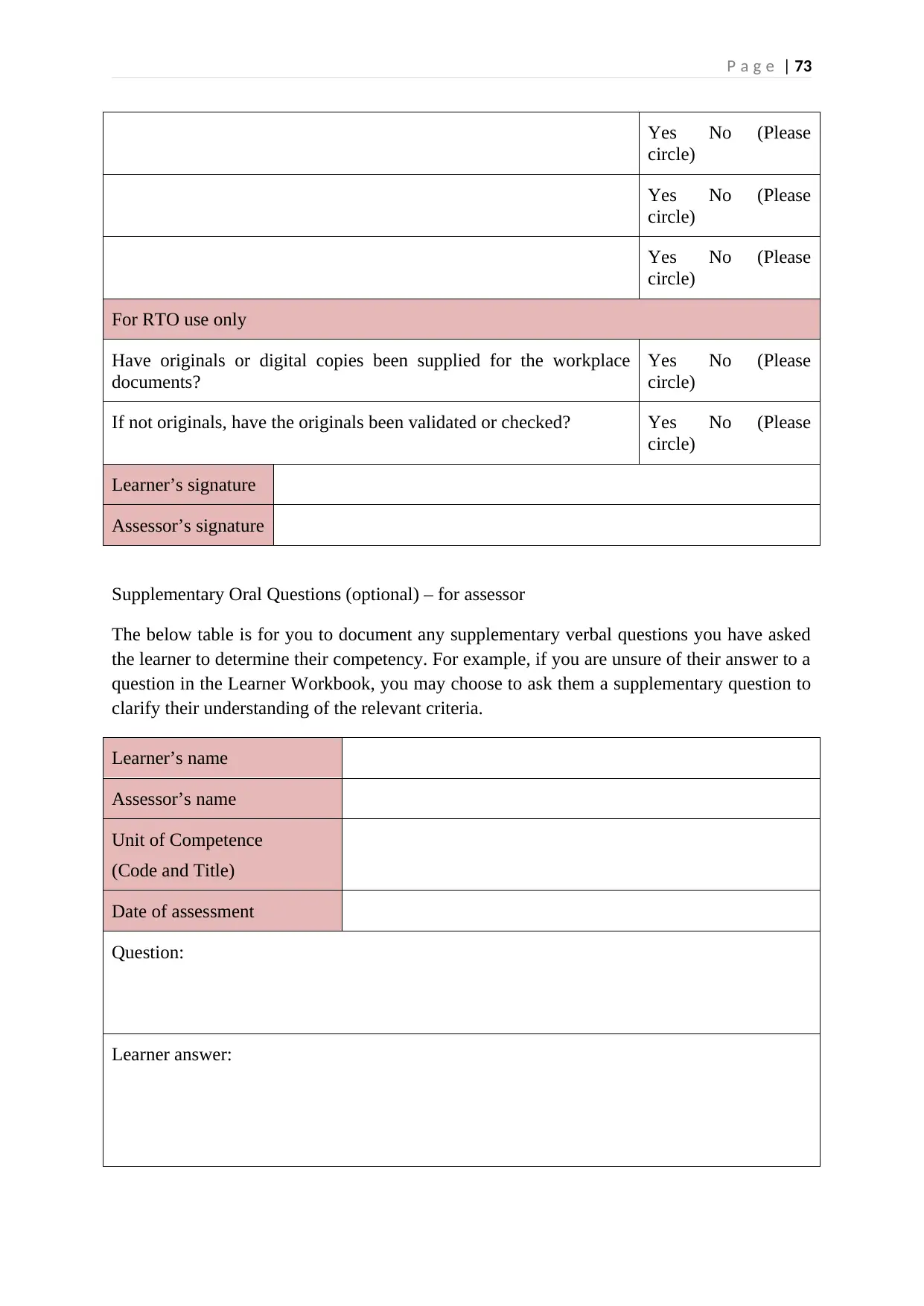
Yes No (Please
circle)
Yes No (Please
circle)
Yes No (Please
circle)
For RTO use only
Have originals or digital copies been supplied for the workplace
documents?
Yes No (Please
circle)
If not originals, have the originals been validated or checked? Yes No (Please
circle)
Learner’s signature
Assessor’s signature
Supplementary Oral Questions (optional) – for assessor
The below table is for you to document any supplementary verbal questions you have asked
the learner to determine their competency. For example, if you are unsure of their answer to a
question in the Learner Workbook, you may choose to ask them a supplementary question to
clarify their understanding of the relevant criteria.
Learner’s name
Assessor’s name
Unit of Competence
(Code and Title)
Date of assessment
Question:
Learner answer:
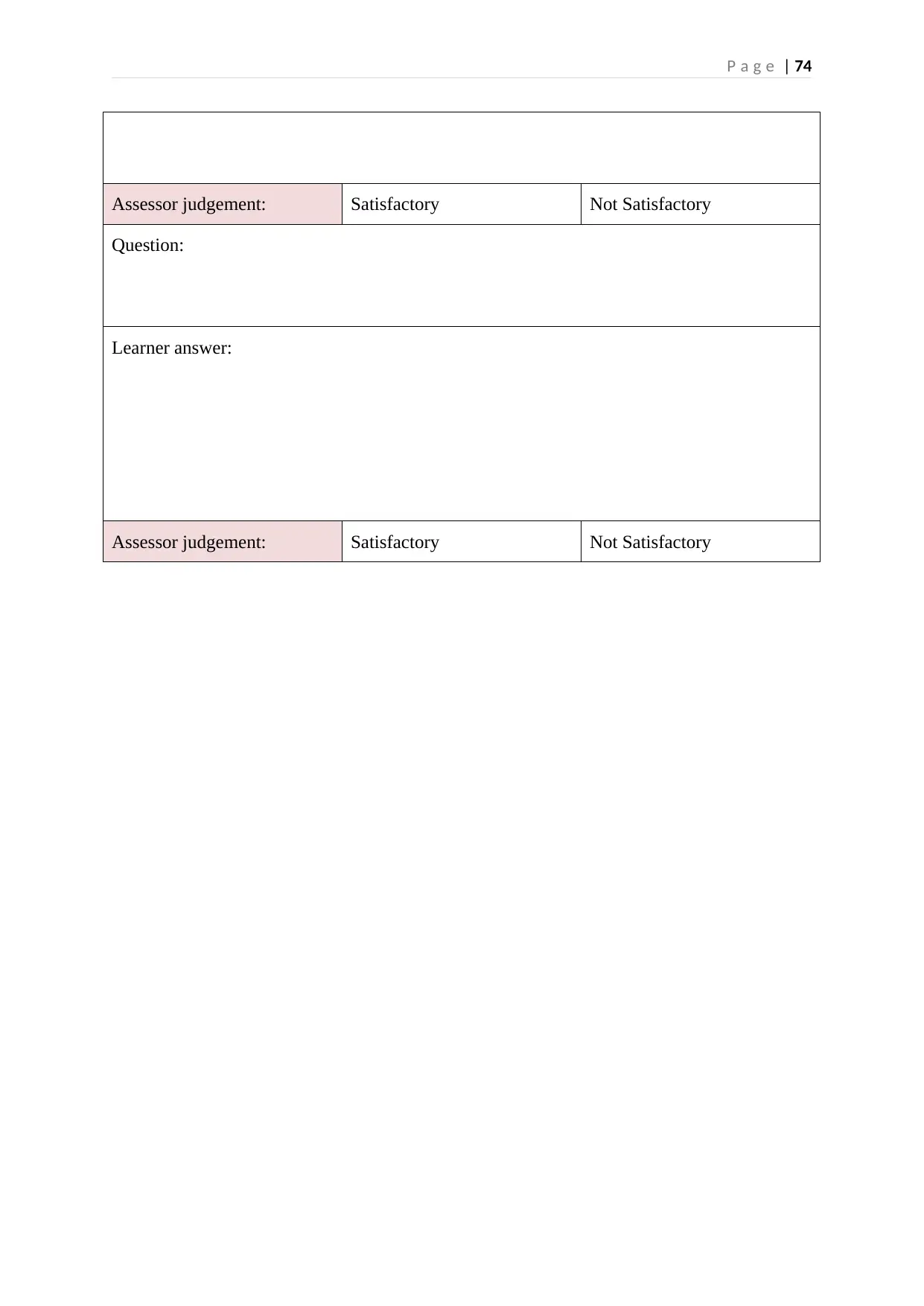
Assessor judgement: Satisfactory Not Satisfactory
Question:
Learner answer:
Assessor judgement: Satisfactory Not Satisfactory
⊘ This is a preview!⊘
Do you want full access?
Subscribe today to unlock all pages.

Trusted by 1+ million students worldwide
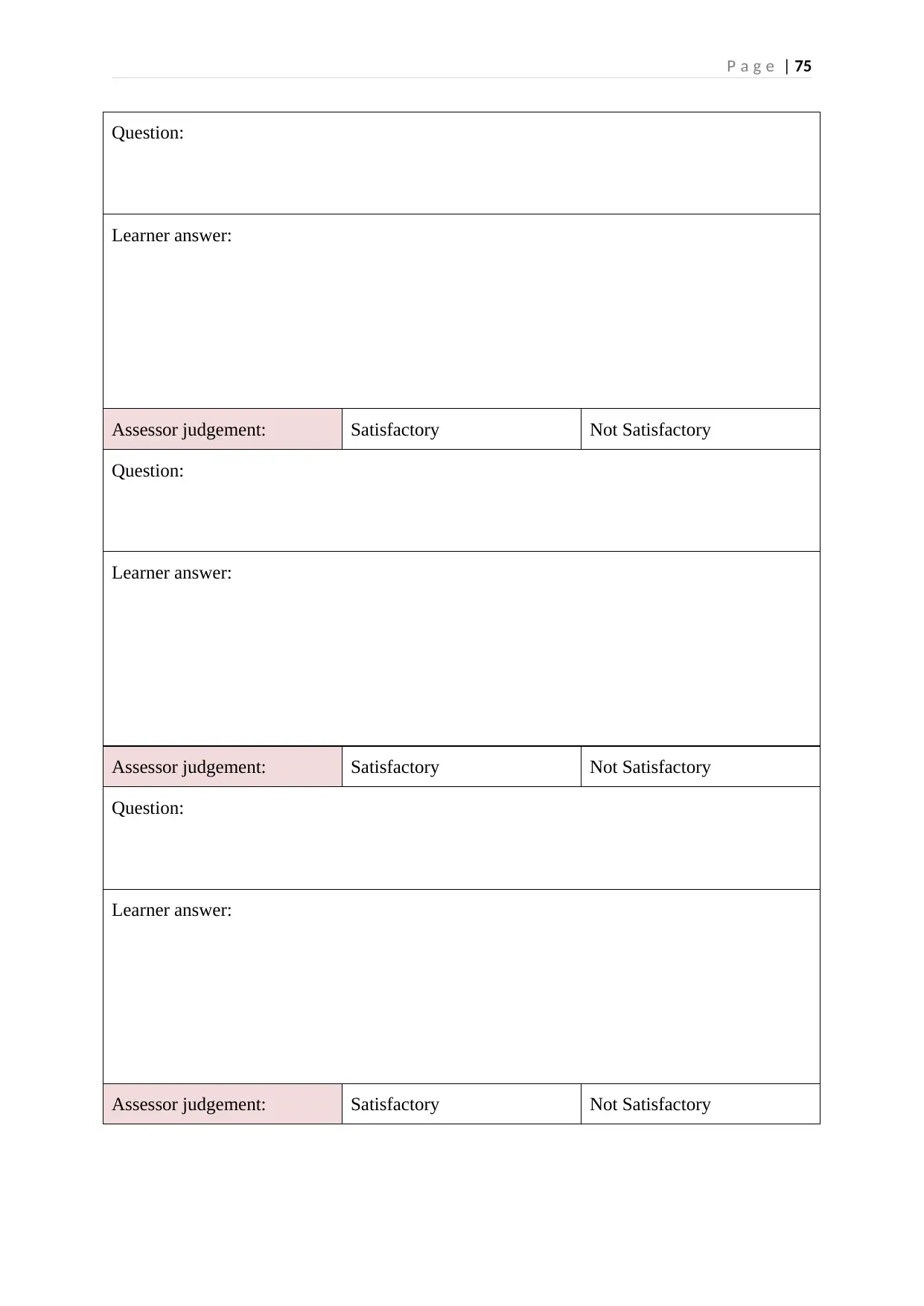
Question:
Learner answer:
Assessor judgement: Satisfactory Not Satisfactory
Question:
Learner answer:
Assessor judgement: Satisfactory Not Satisfactory
Question:
Learner answer:
Assessor judgement: Satisfactory Not Satisfactory
Paraphrase This Document
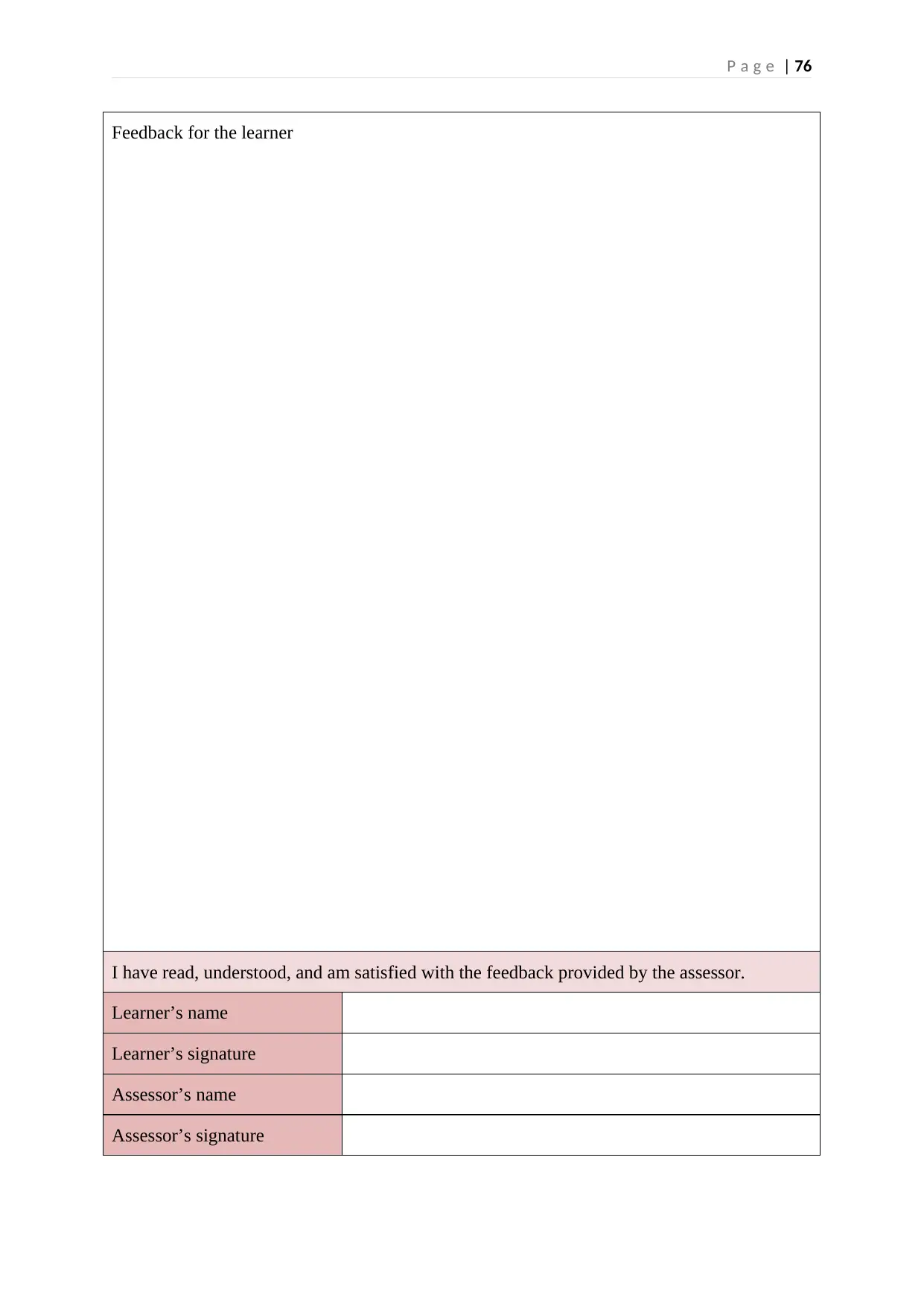
Feedback for the learner
I have read, understood, and am satisfied with the feedback provided by the assessor.
Learner’s name
Learner’s signature
Assessor’s name
Assessor’s signature

⊘ This is a preview!⊘
Do you want full access?
Subscribe today to unlock all pages.

Trusted by 1+ million students worldwide

Competency record to be completed by assessor
This should be used by the trainer/assessor to document the learner’s skills, knowledge and
performance as relevant to the overall unit. Indicate in the table below if the learner is
deemed competent or not yet competent for the unit or if reassessment is required.
Learner’s name
Assessor’s name
Unit of Competence
(Code and Title)
Date(s) of assessment
Has the learner completed all required assessments to a satisfactory
standard?
Yes No
(Please
circle)
Has sufficient evidence and information been provided by the learner to
prove their competency across the entire unit?
Yes No
(Please
circle)
The learner has been assessed as competent in the elements and performance criteria and the
evidence has been presented as:
Authentic Yes No
(Please
circle)
Valid Yes No
(Please
circle)
Reliable Yes No
(Please
circle)
Current Yes No
(Please
circle)
Sufficient Yes No
(Please
circle)
Paraphrase This Document
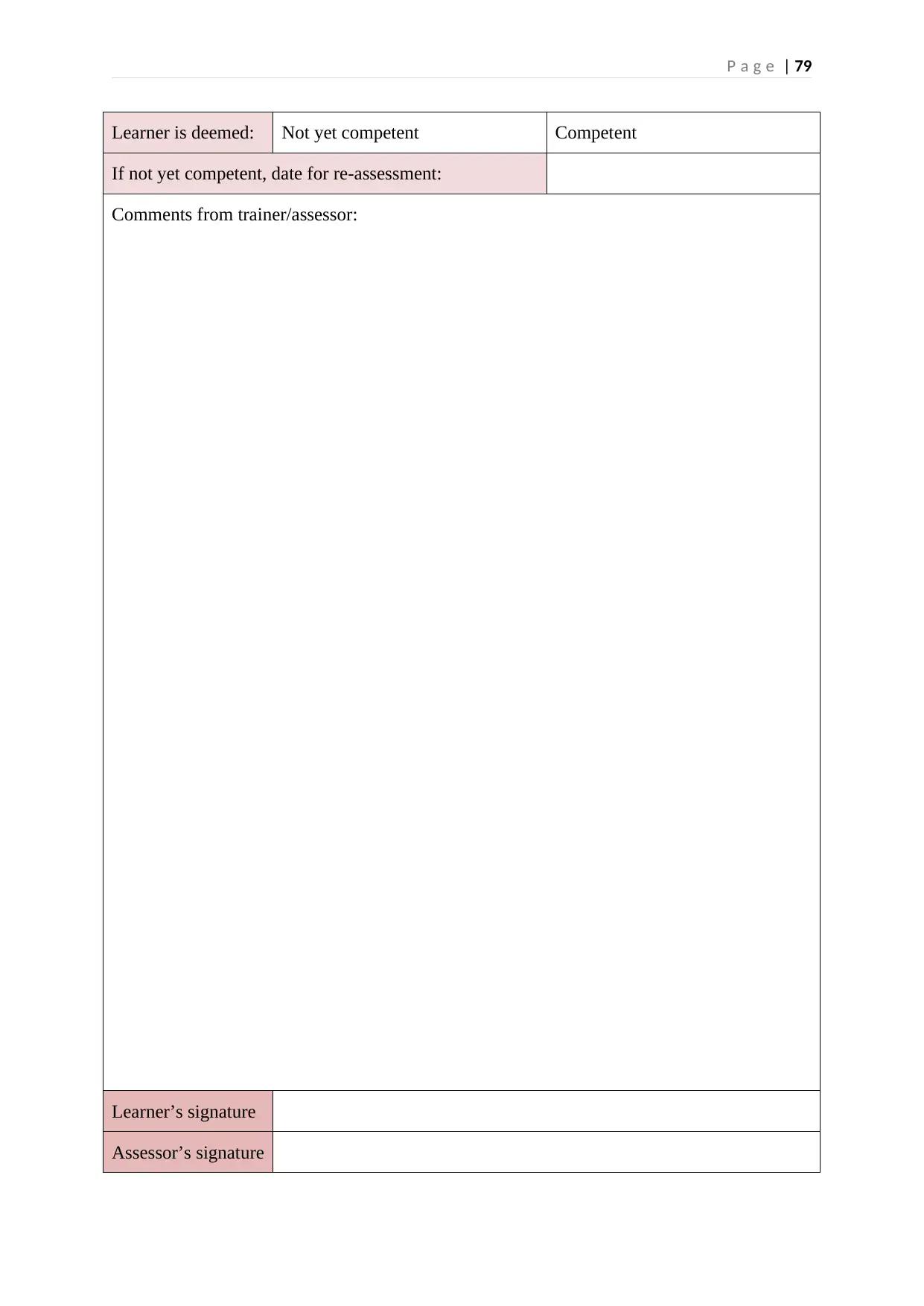
Learner is deemed: Not yet competent Competent
If not yet competent, date for re-assessment:
Comments from trainer/assessor:
Learner’s signature
Assessor’s signature

⊘ This is a preview!⊘
Do you want full access?
Subscribe today to unlock all pages.

Trusted by 1+ million students worldwide
Related Documents
Your All-in-One AI-Powered Toolkit for Academic Success.
+13062052269
info@desklib.com
Available 24*7 on WhatsApp / Email
![[object Object]](/_next/static/media/star-bottom.7253800d.svg)
© 2024 | Zucol Services PVT LTD | All rights reserved.





